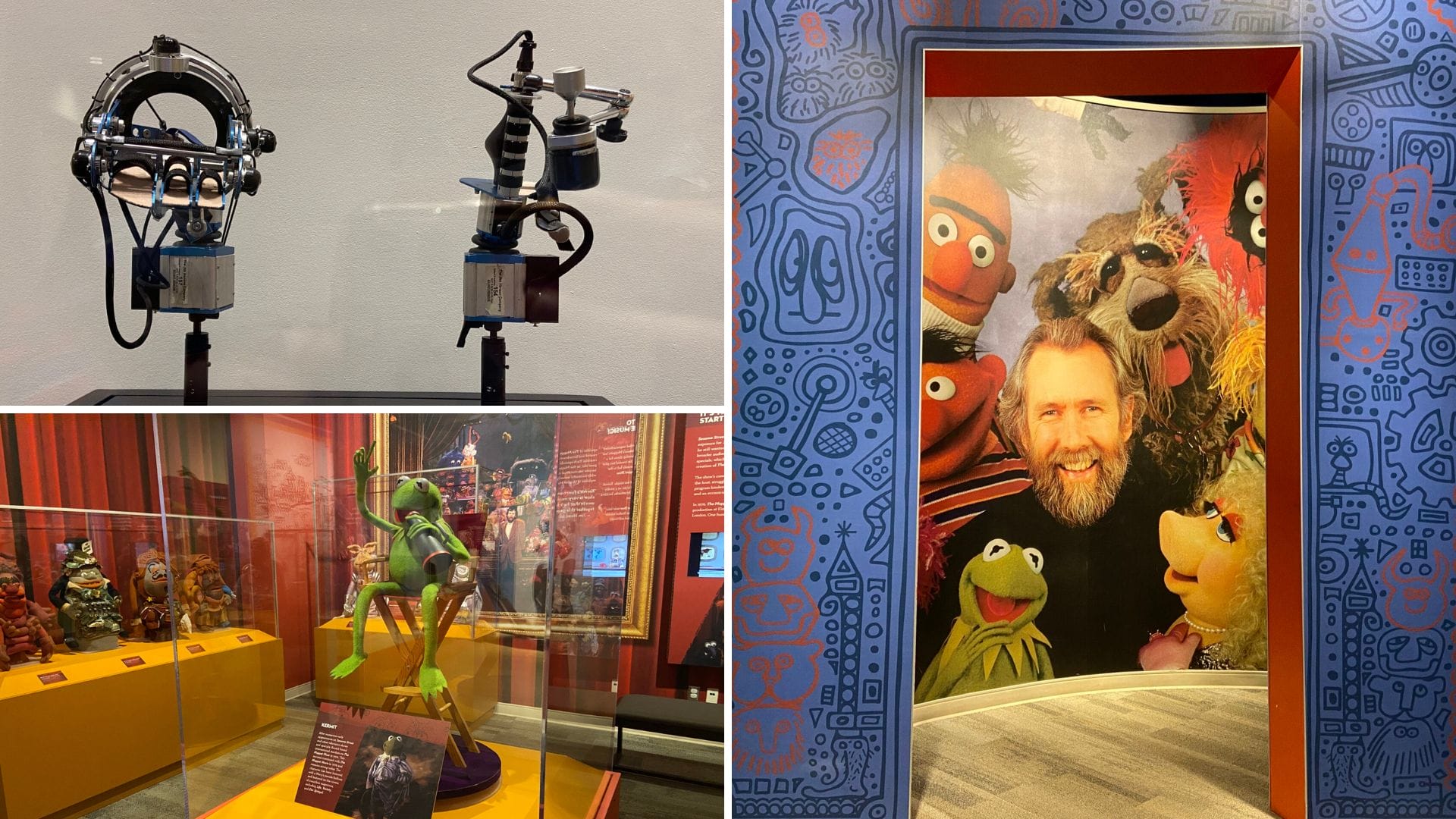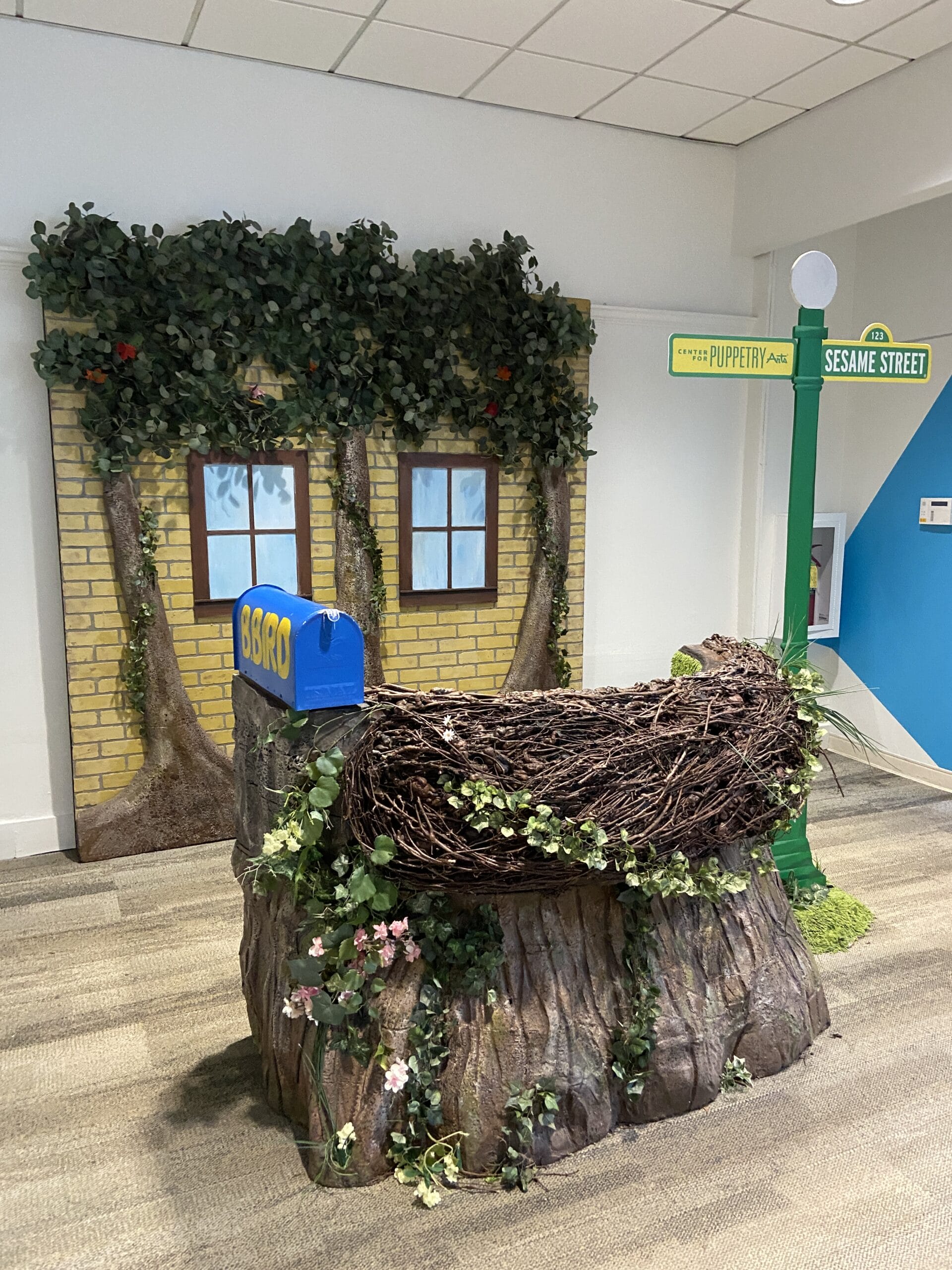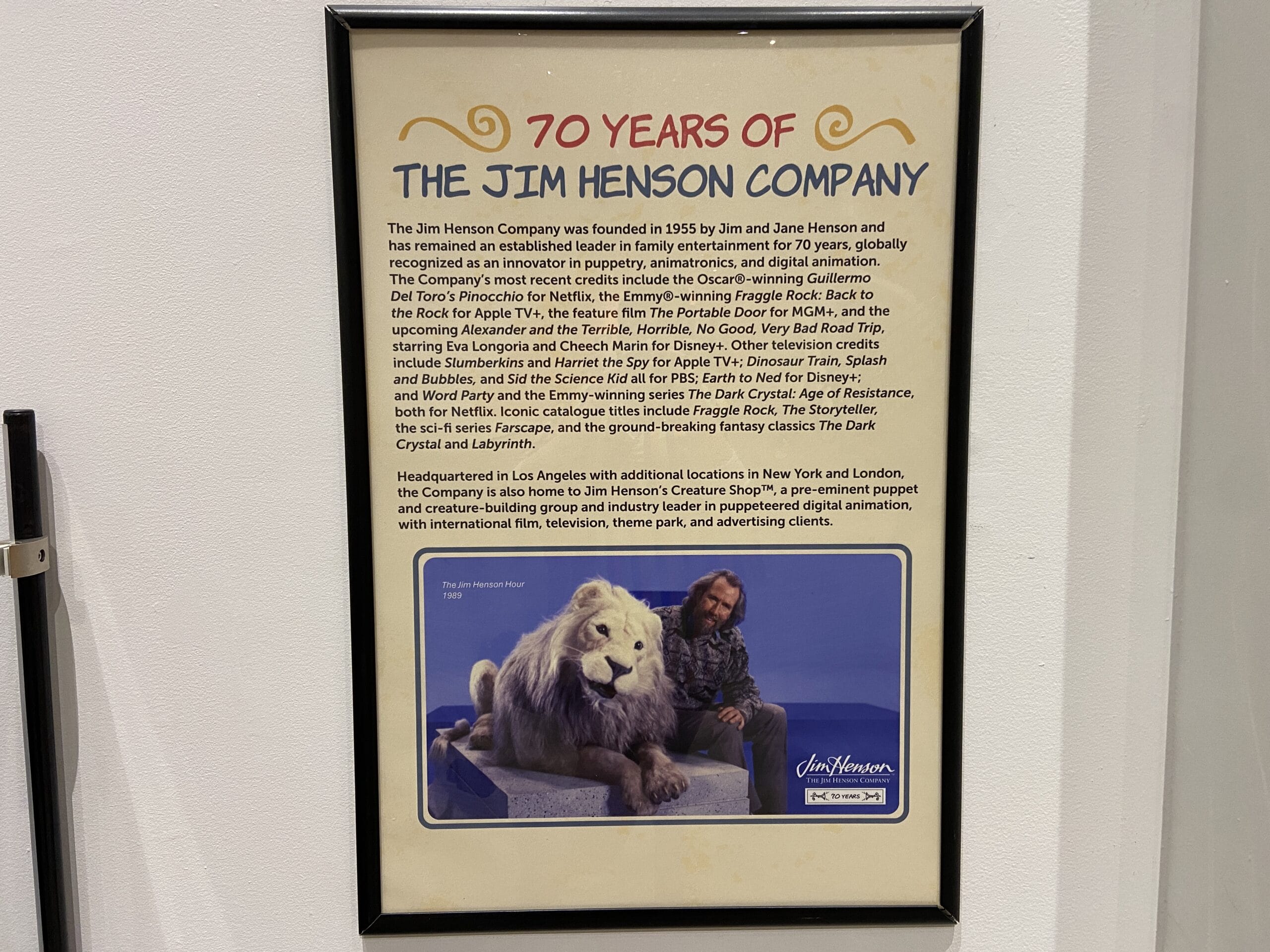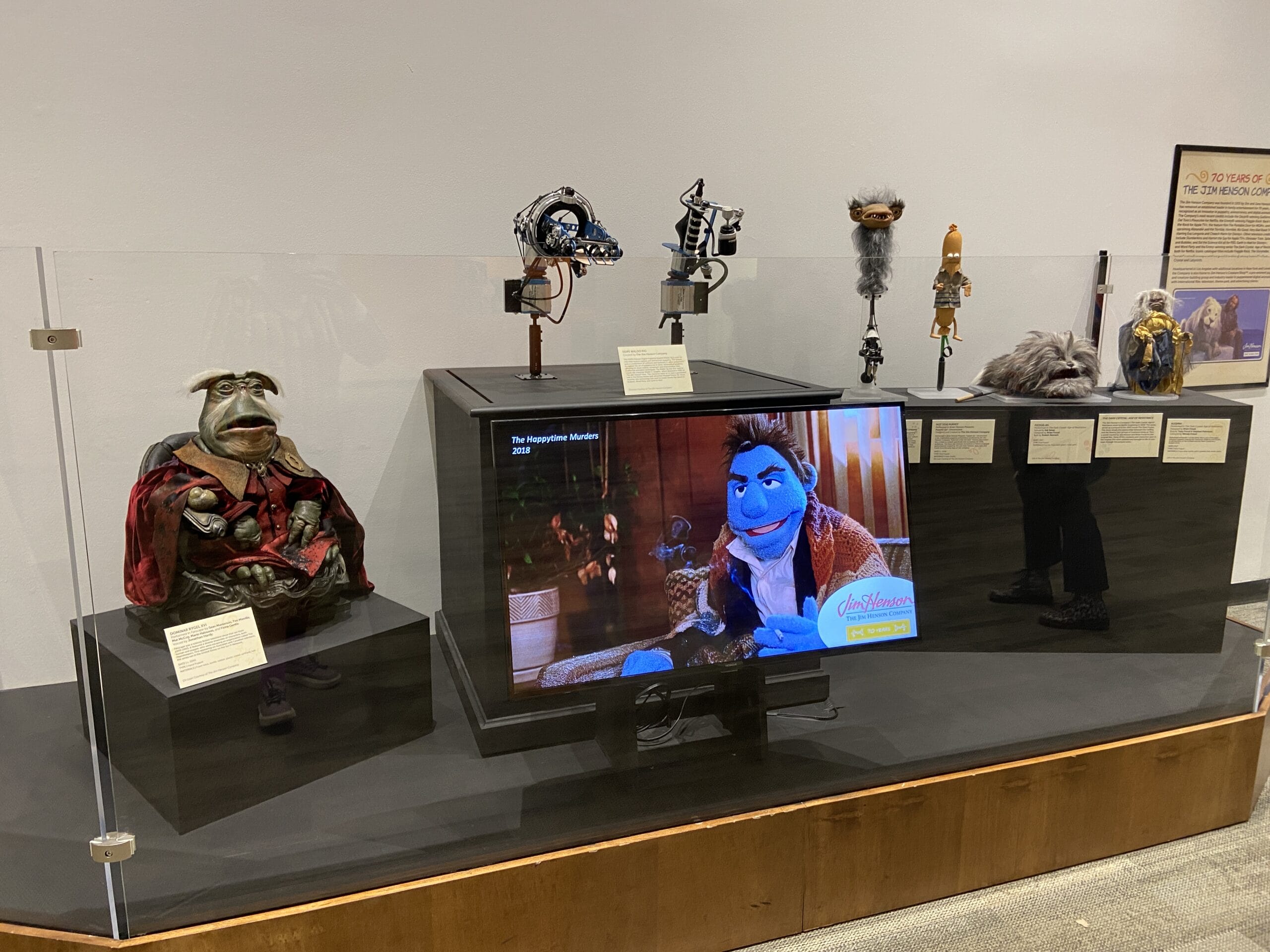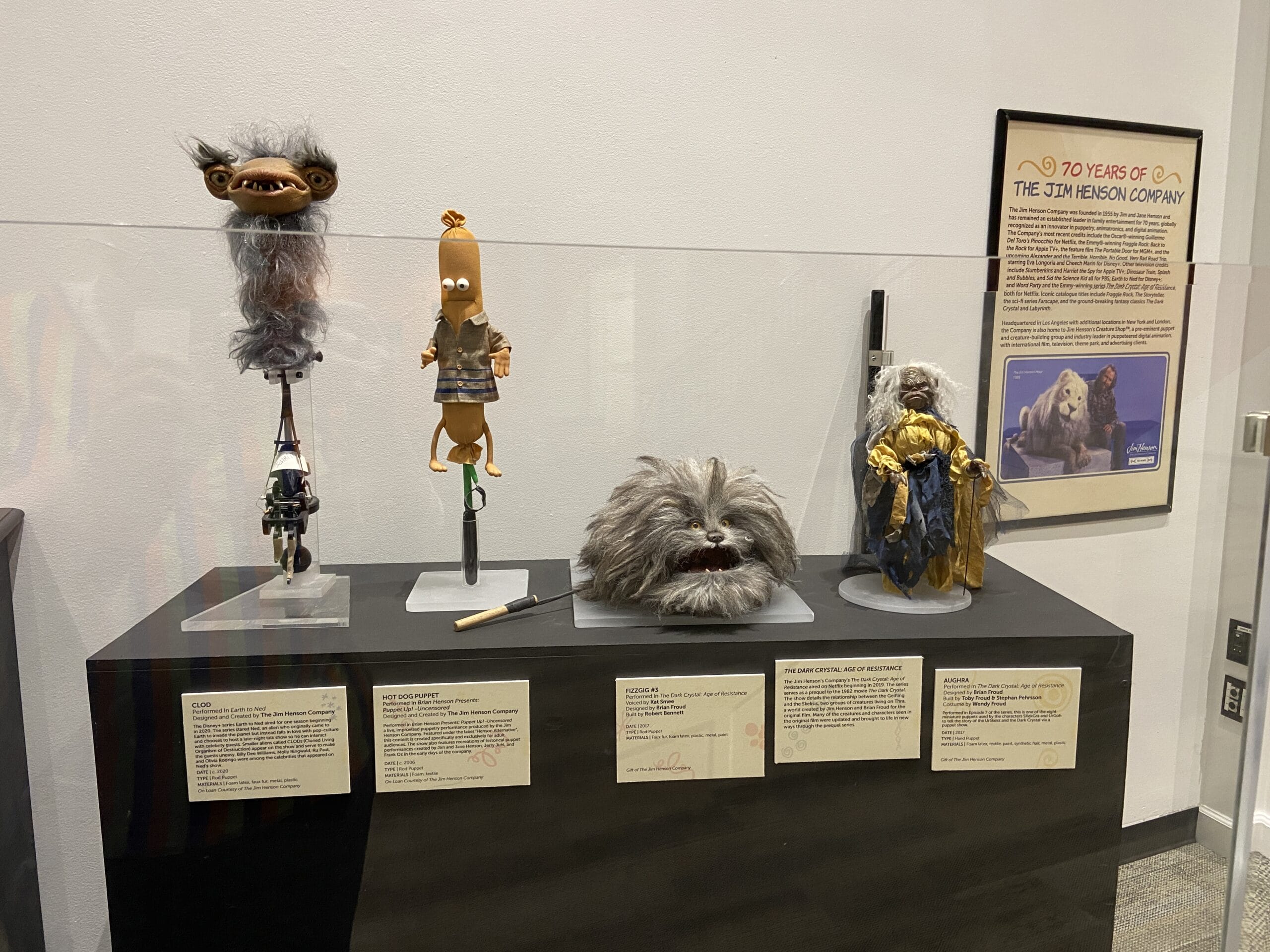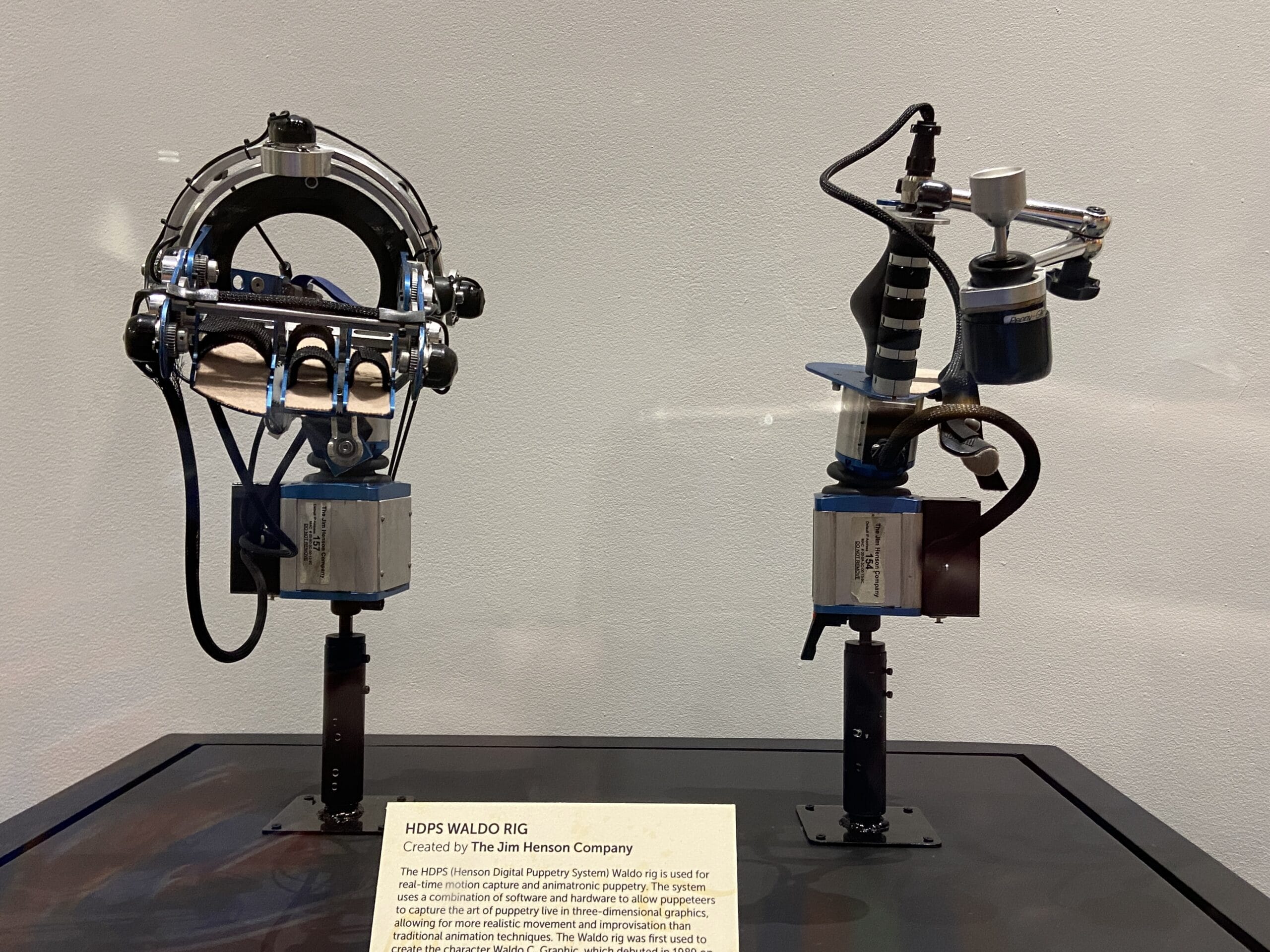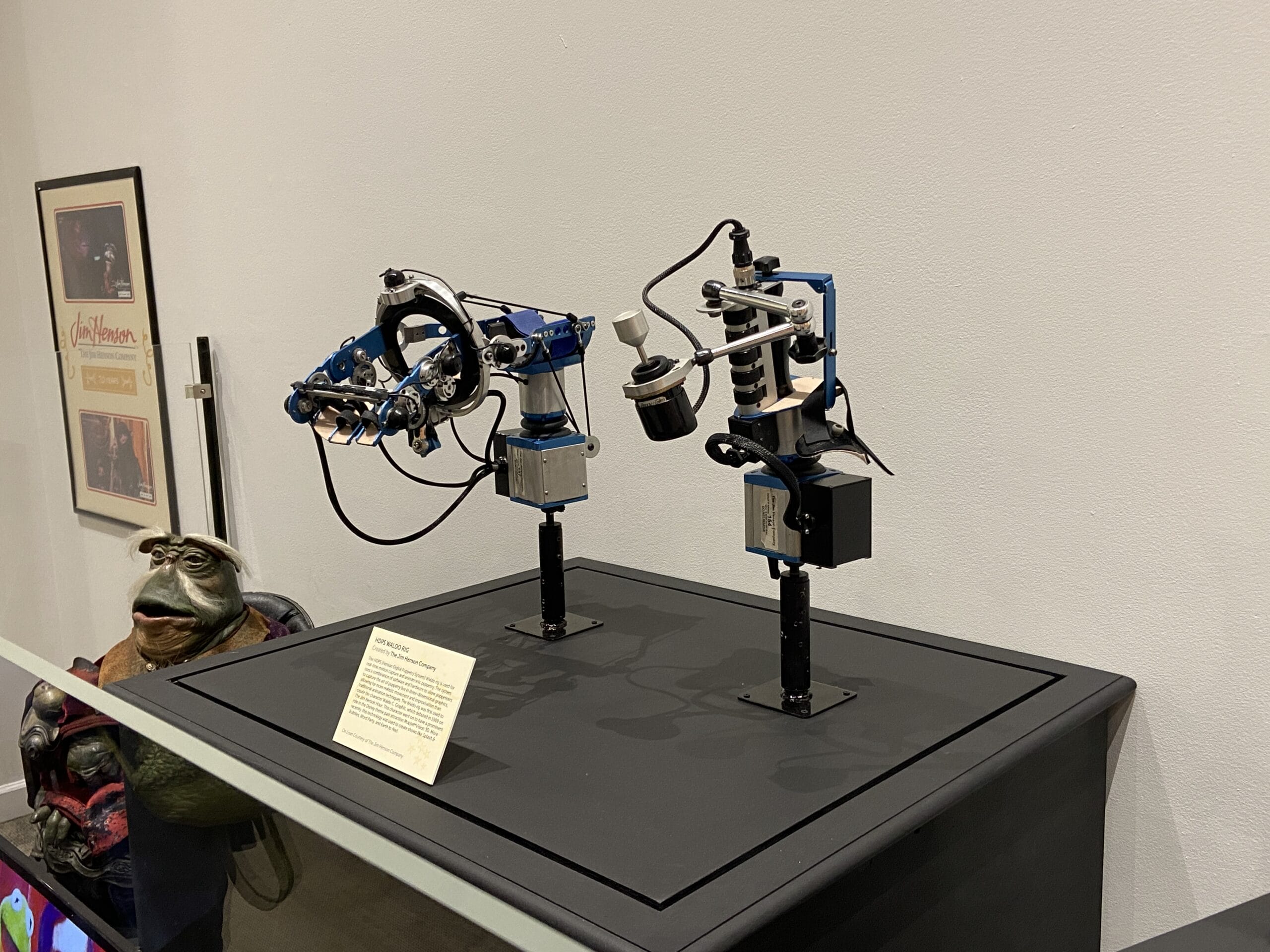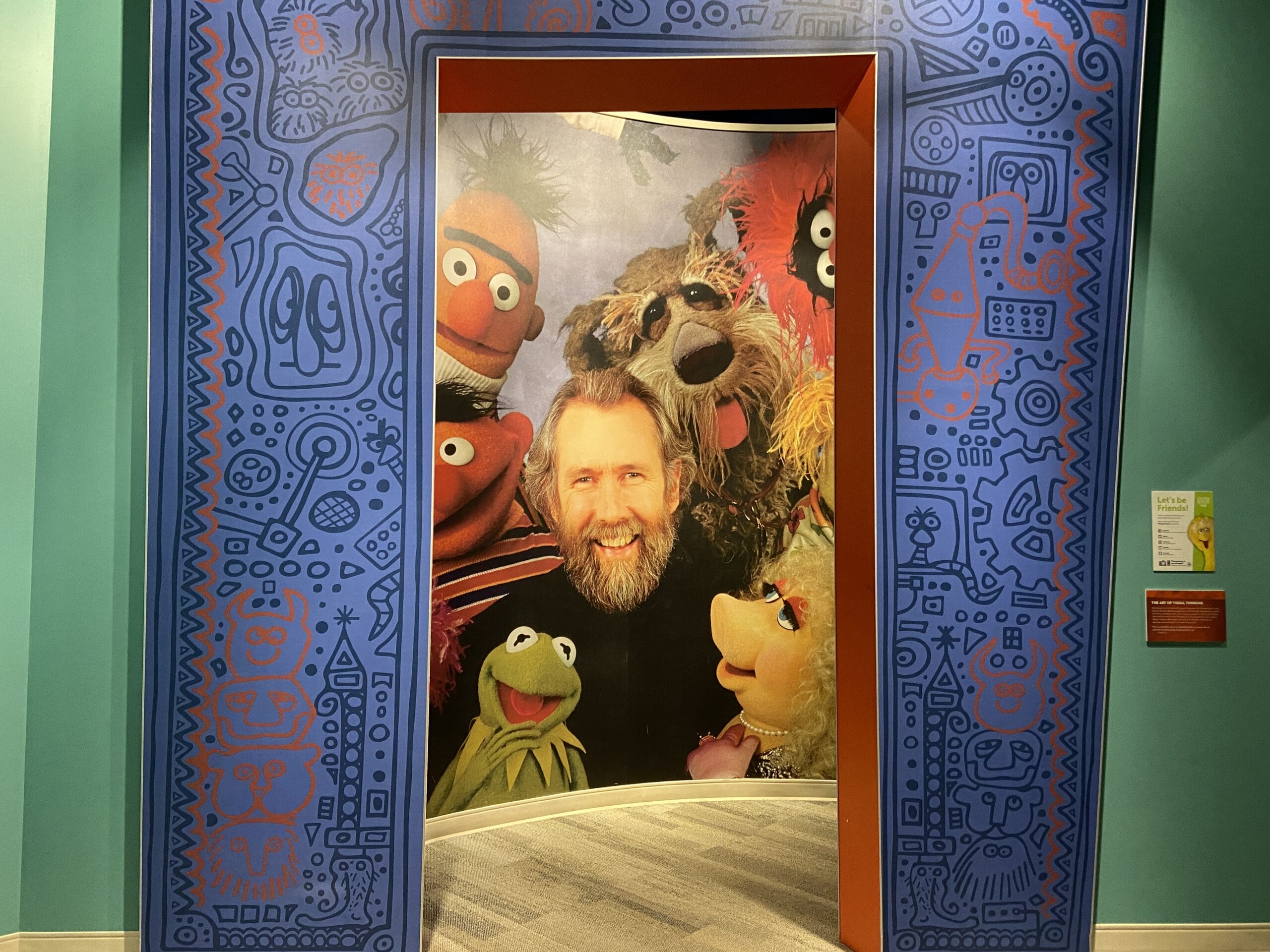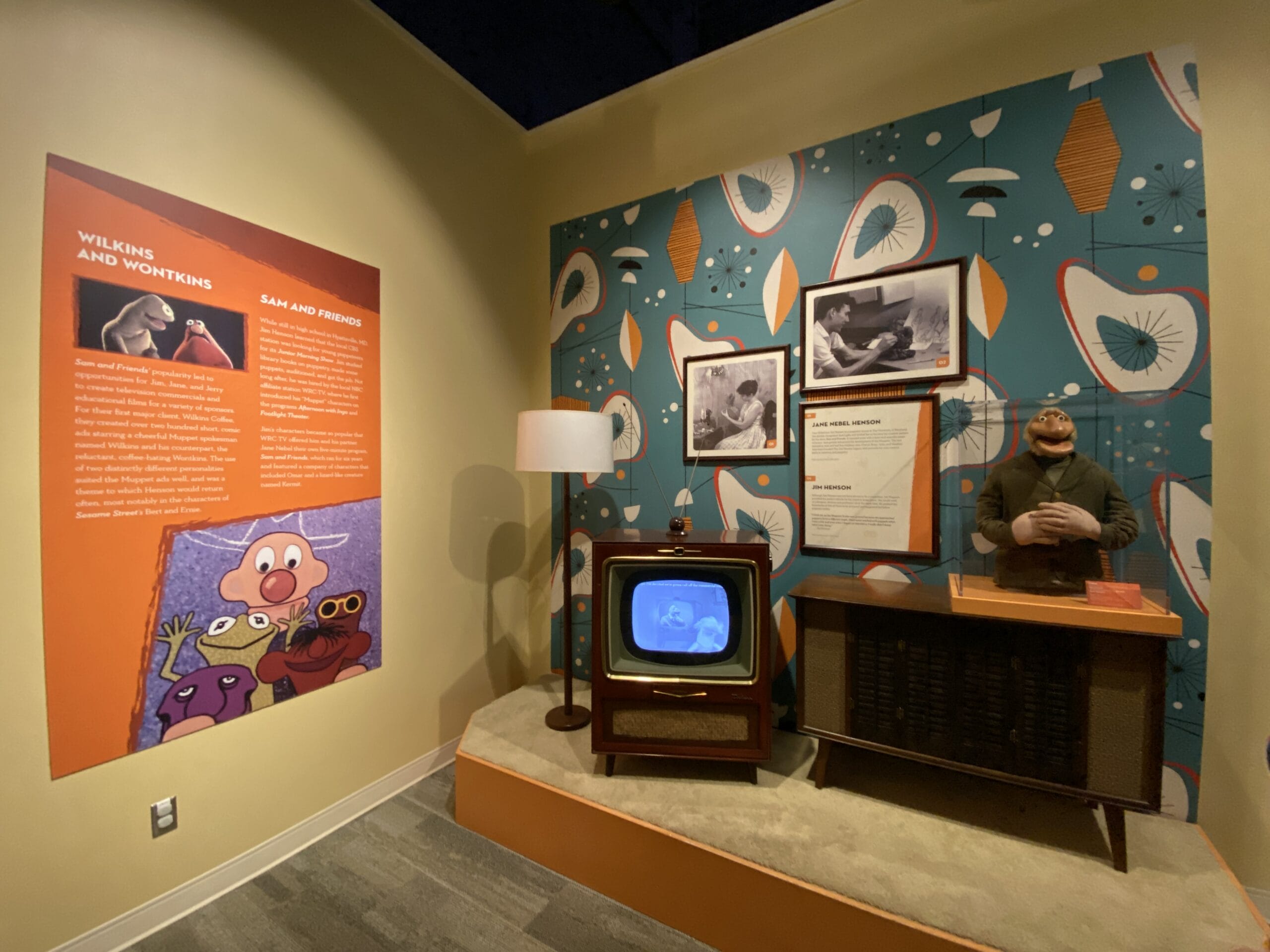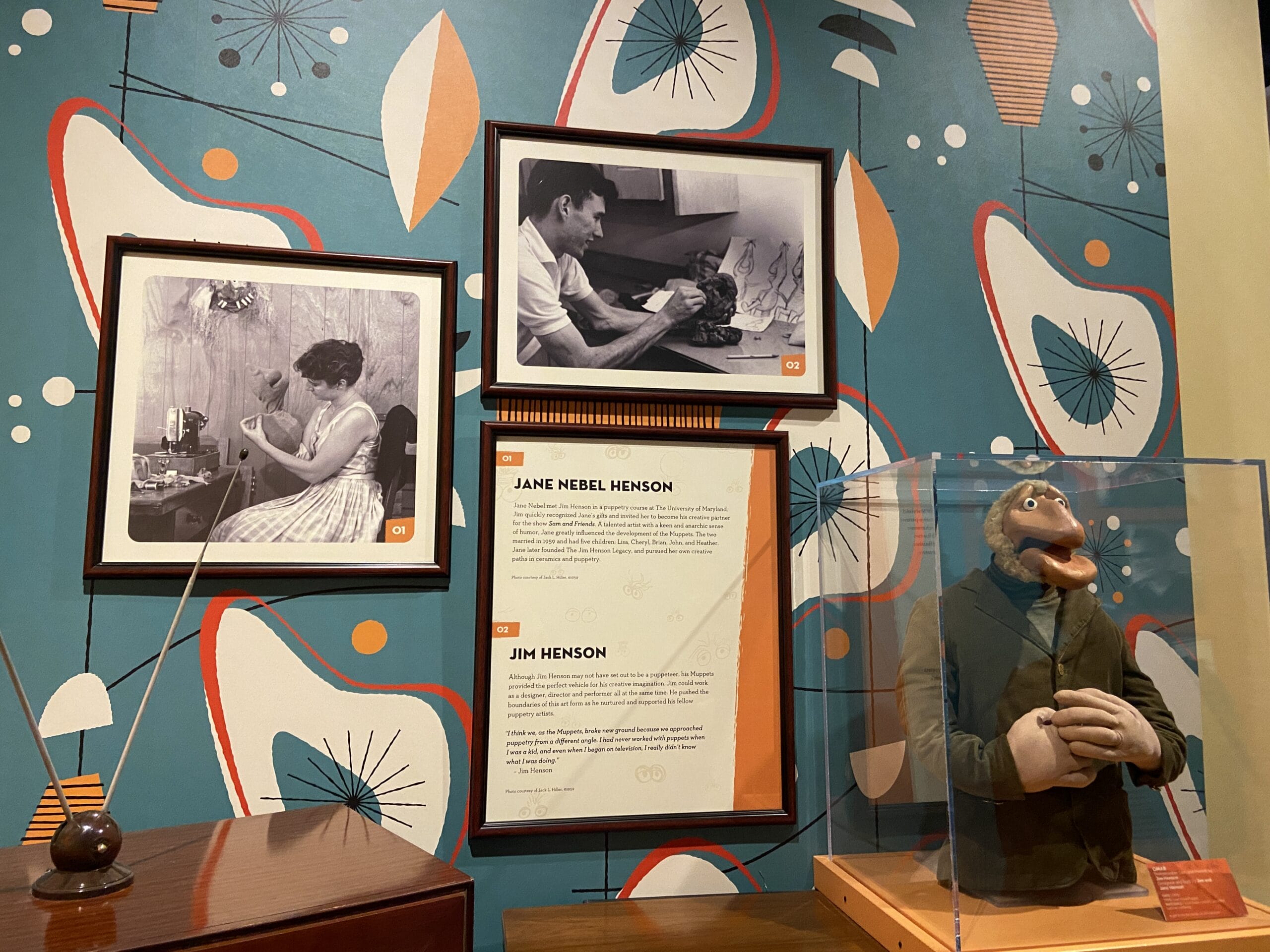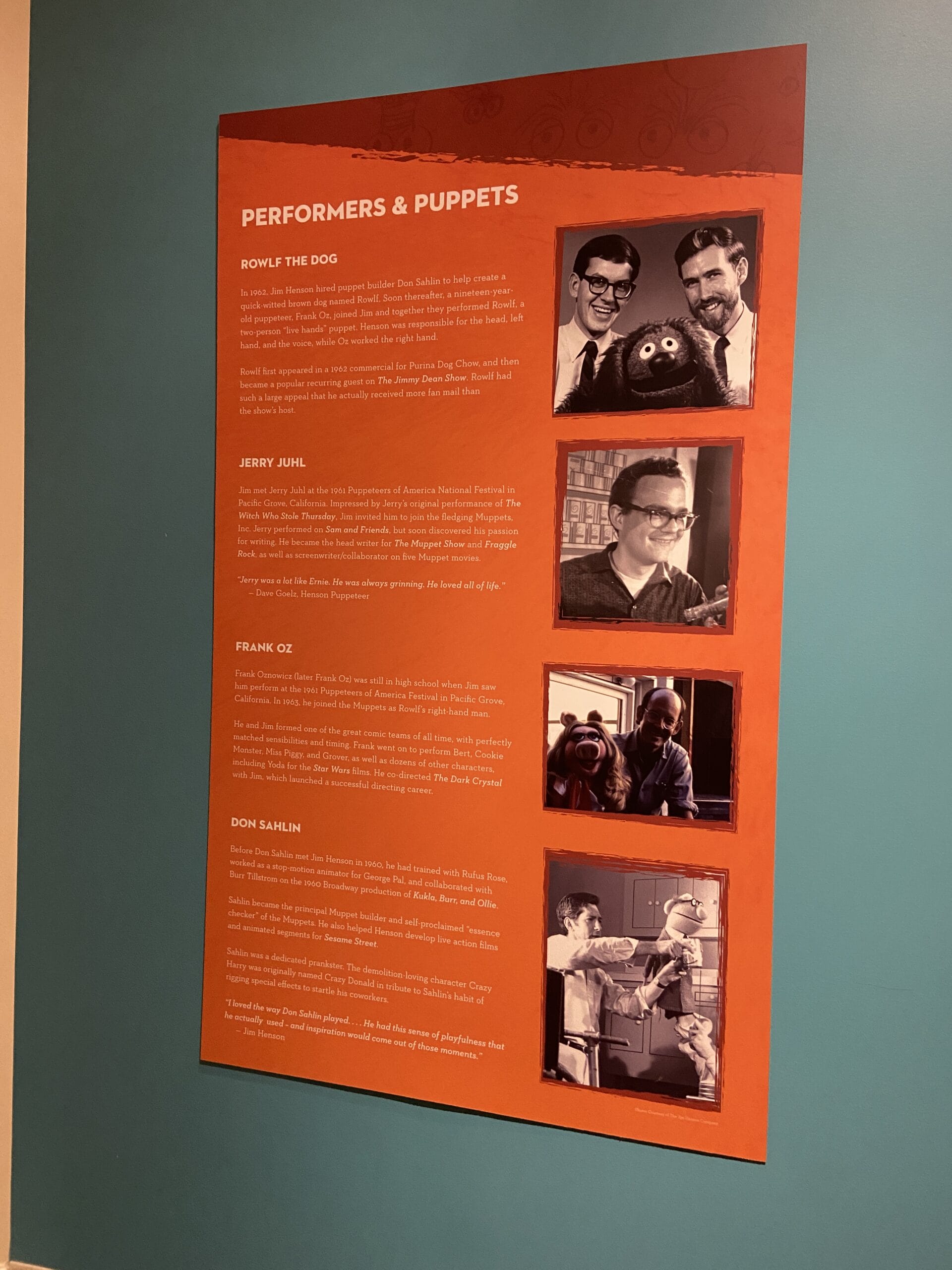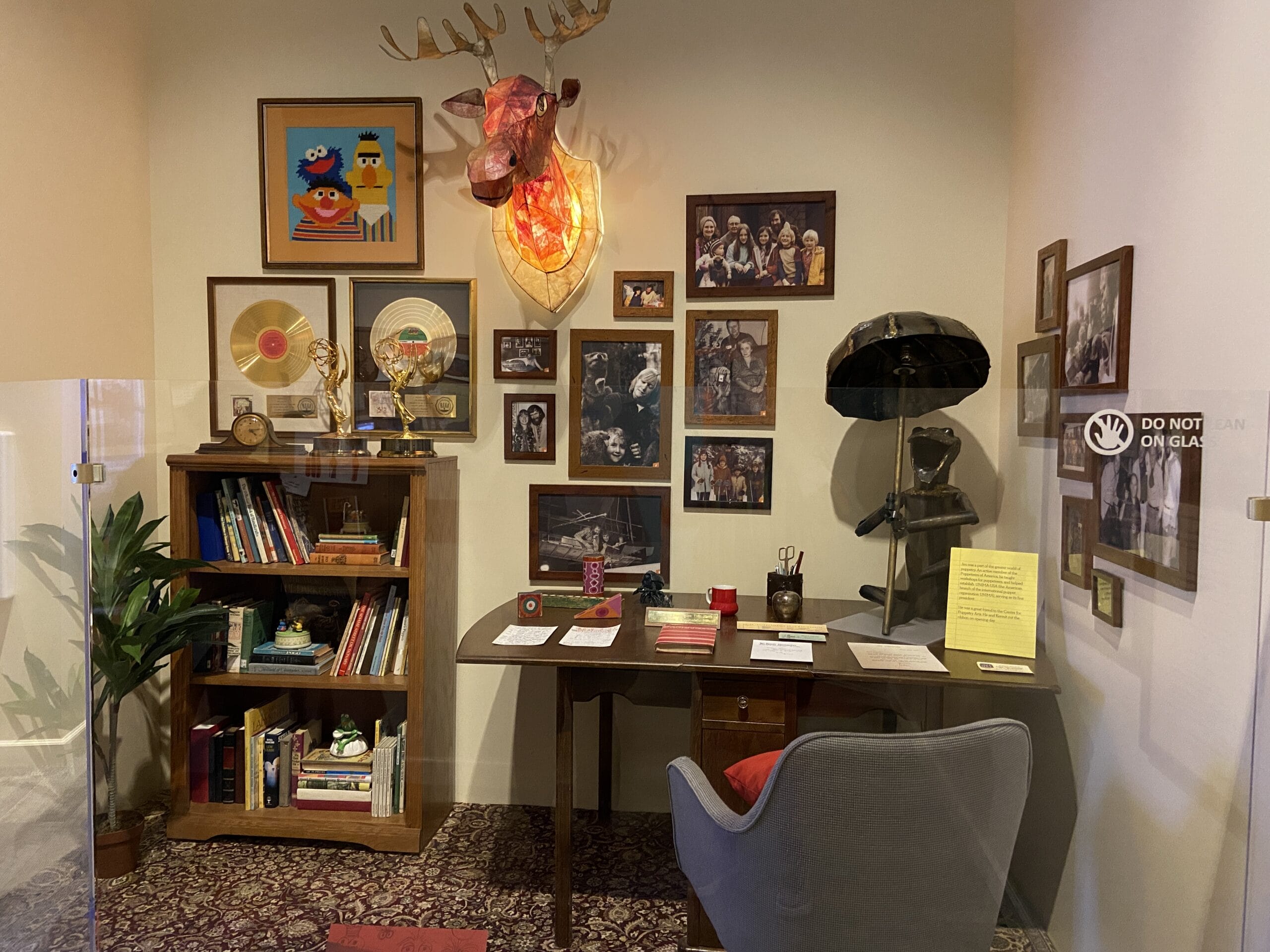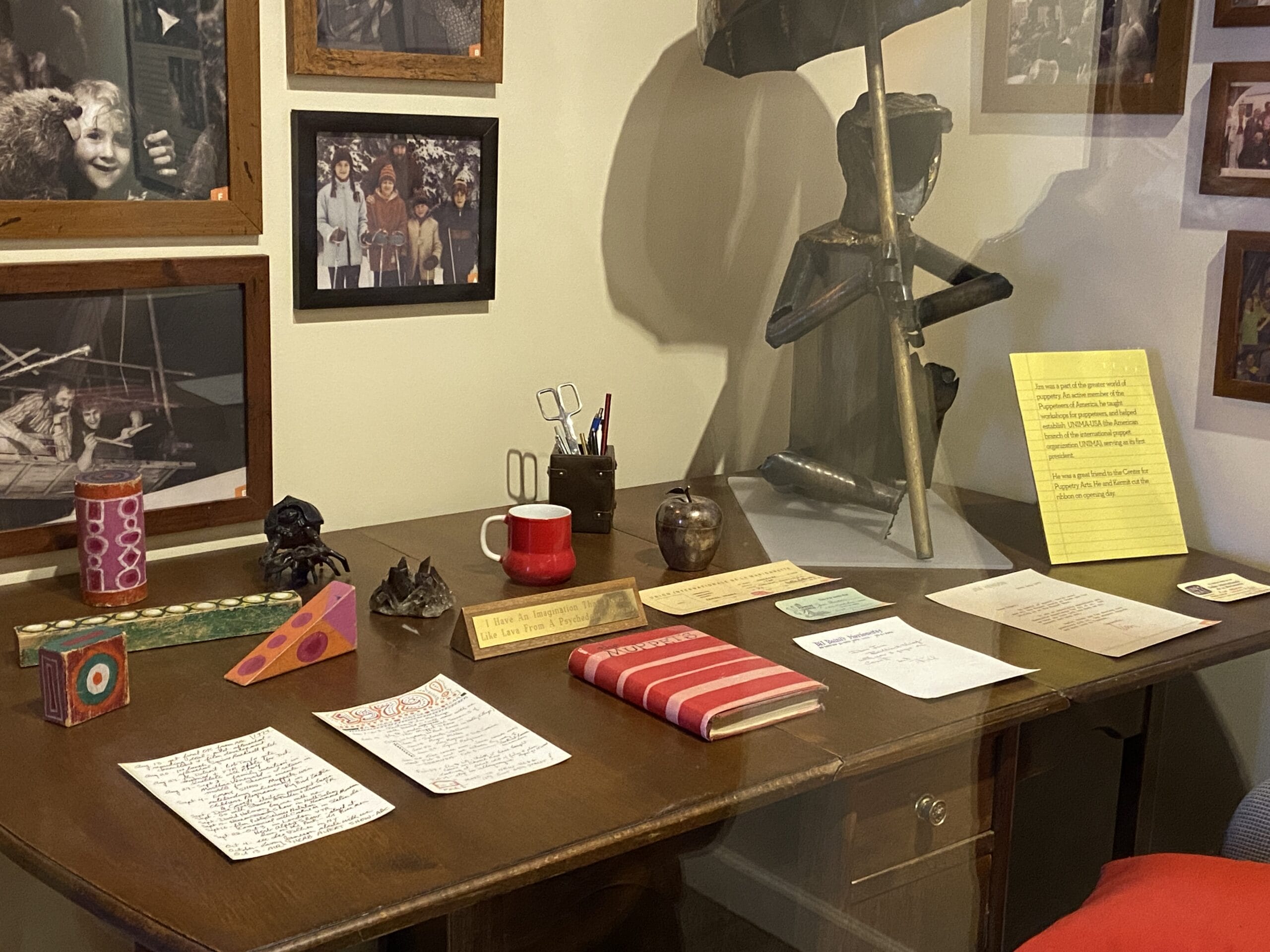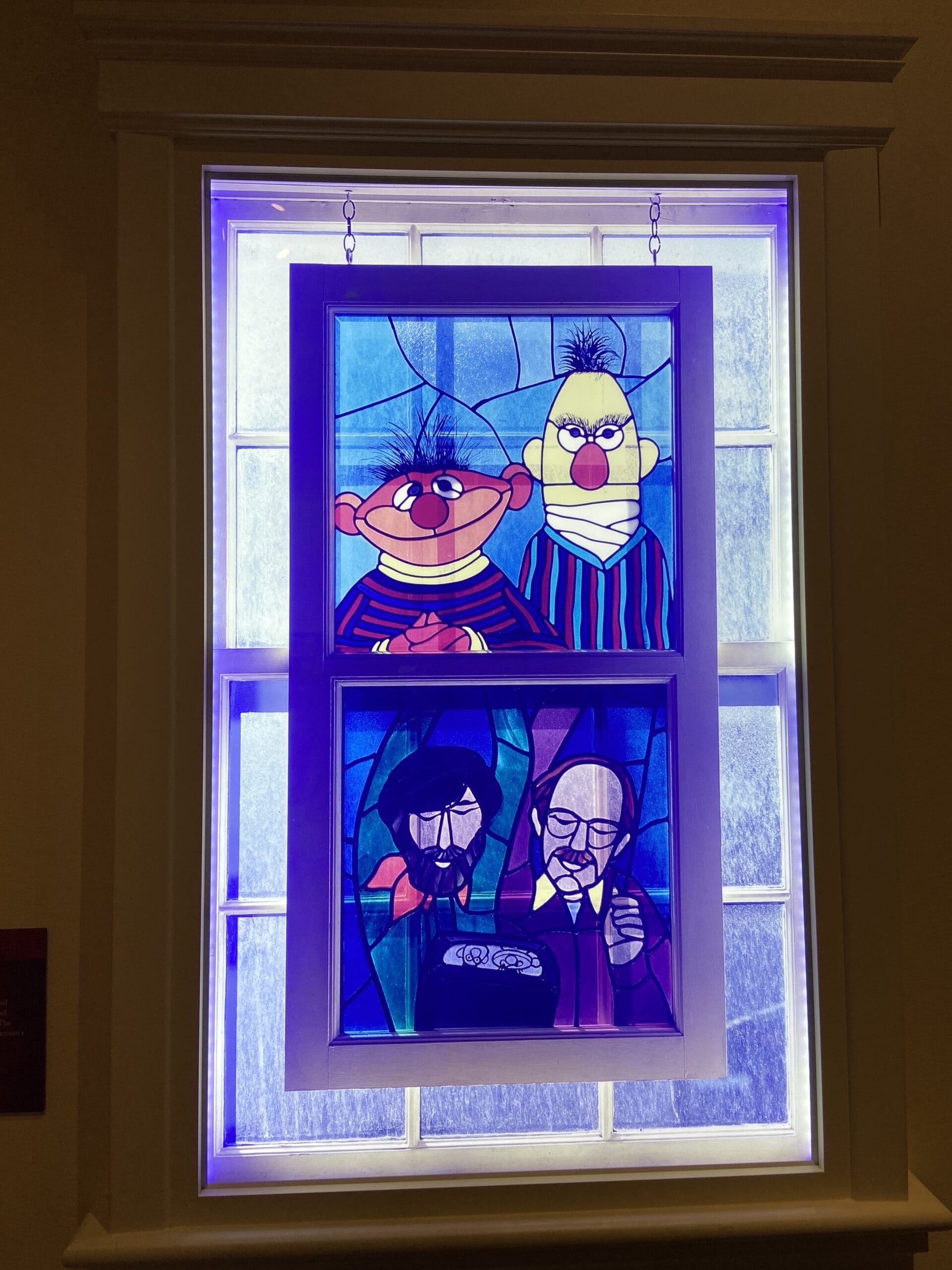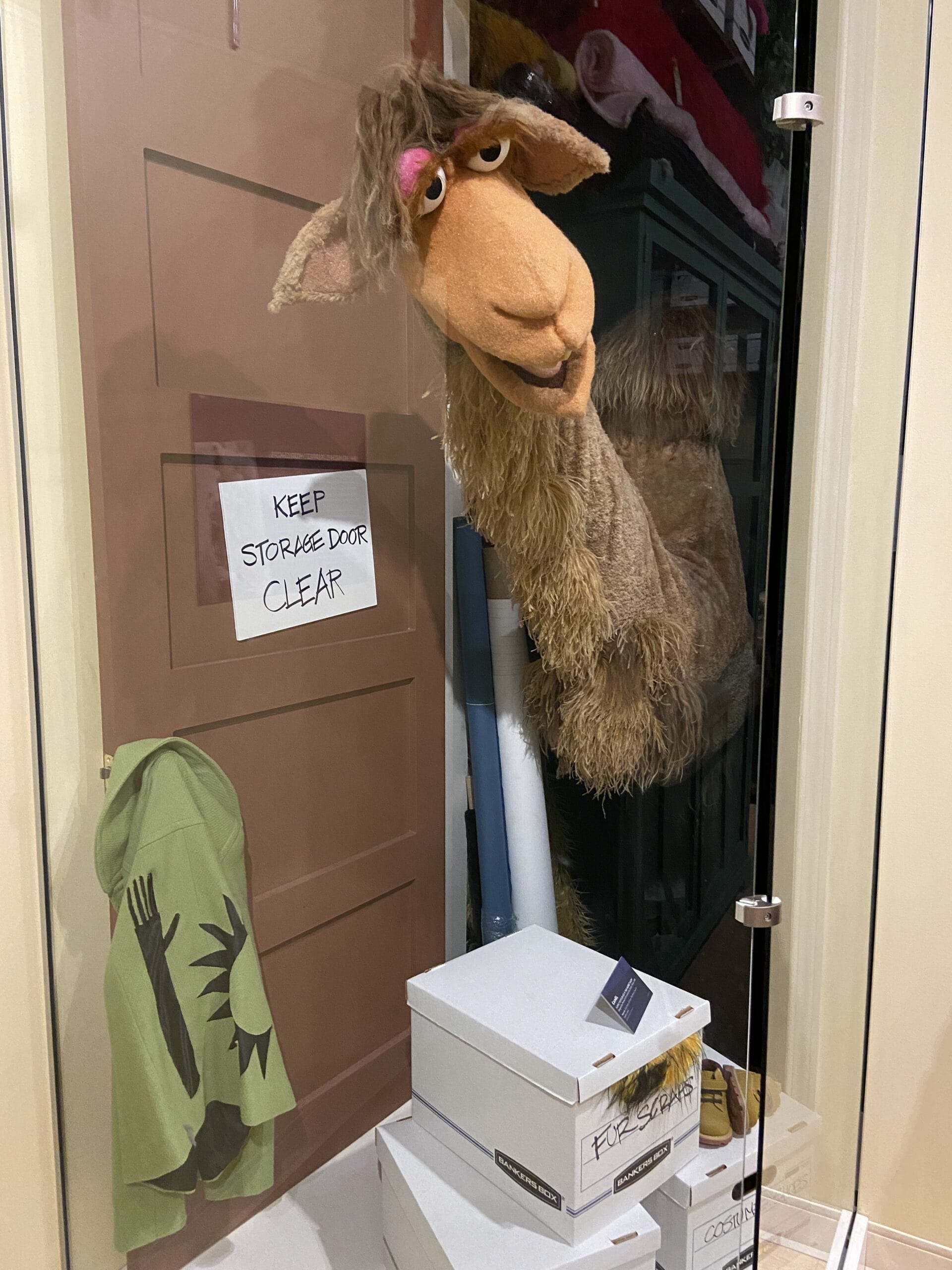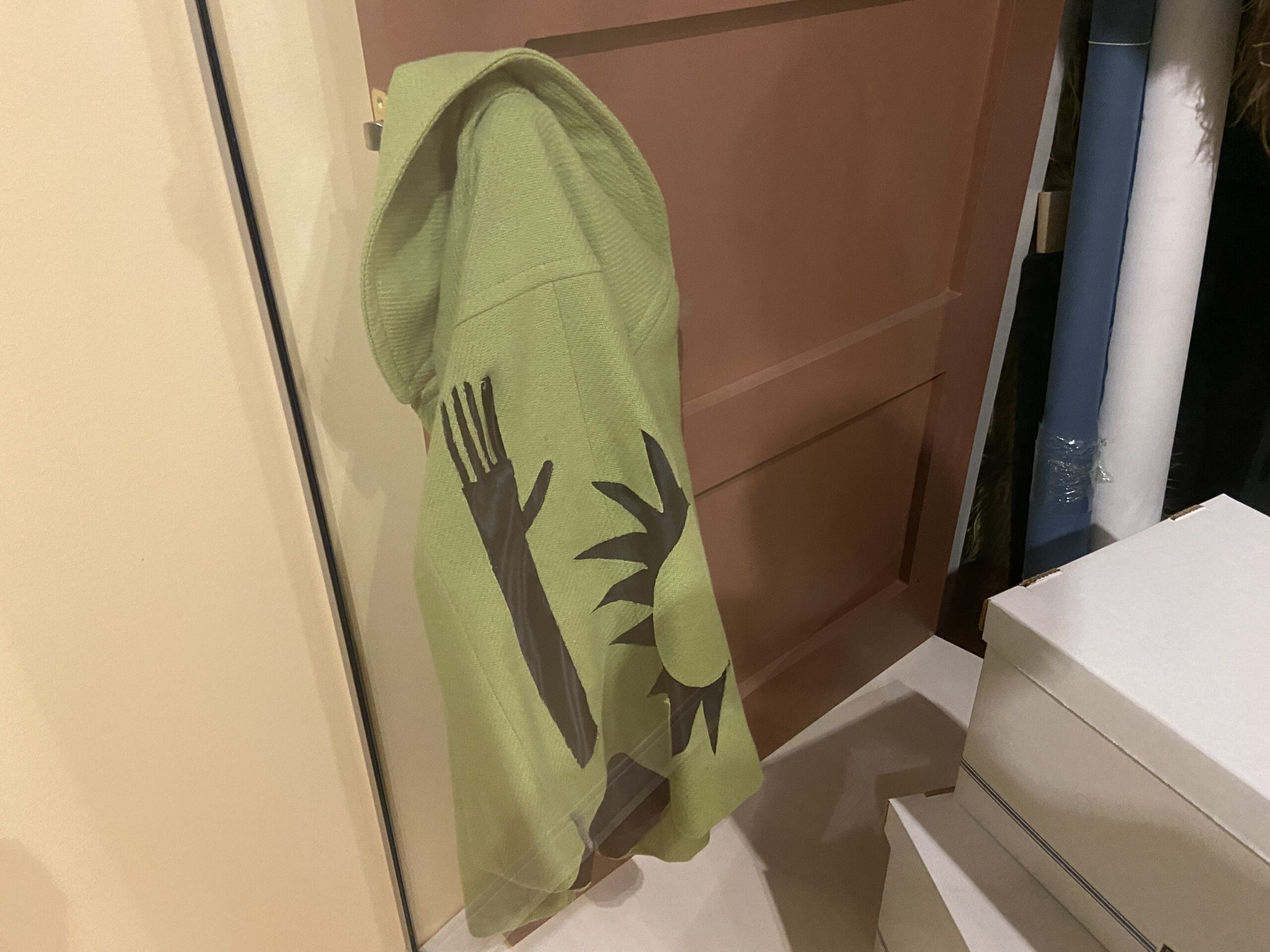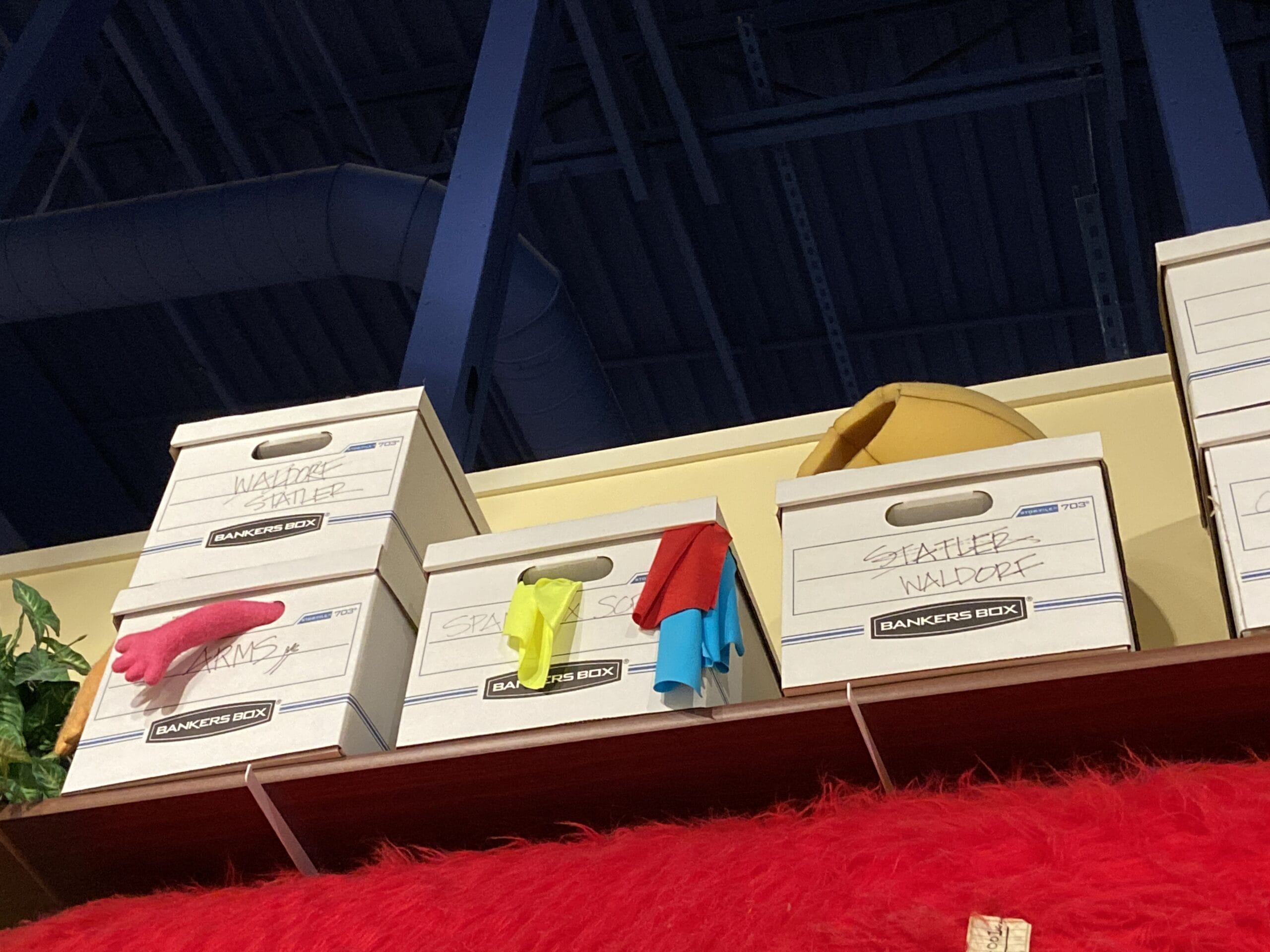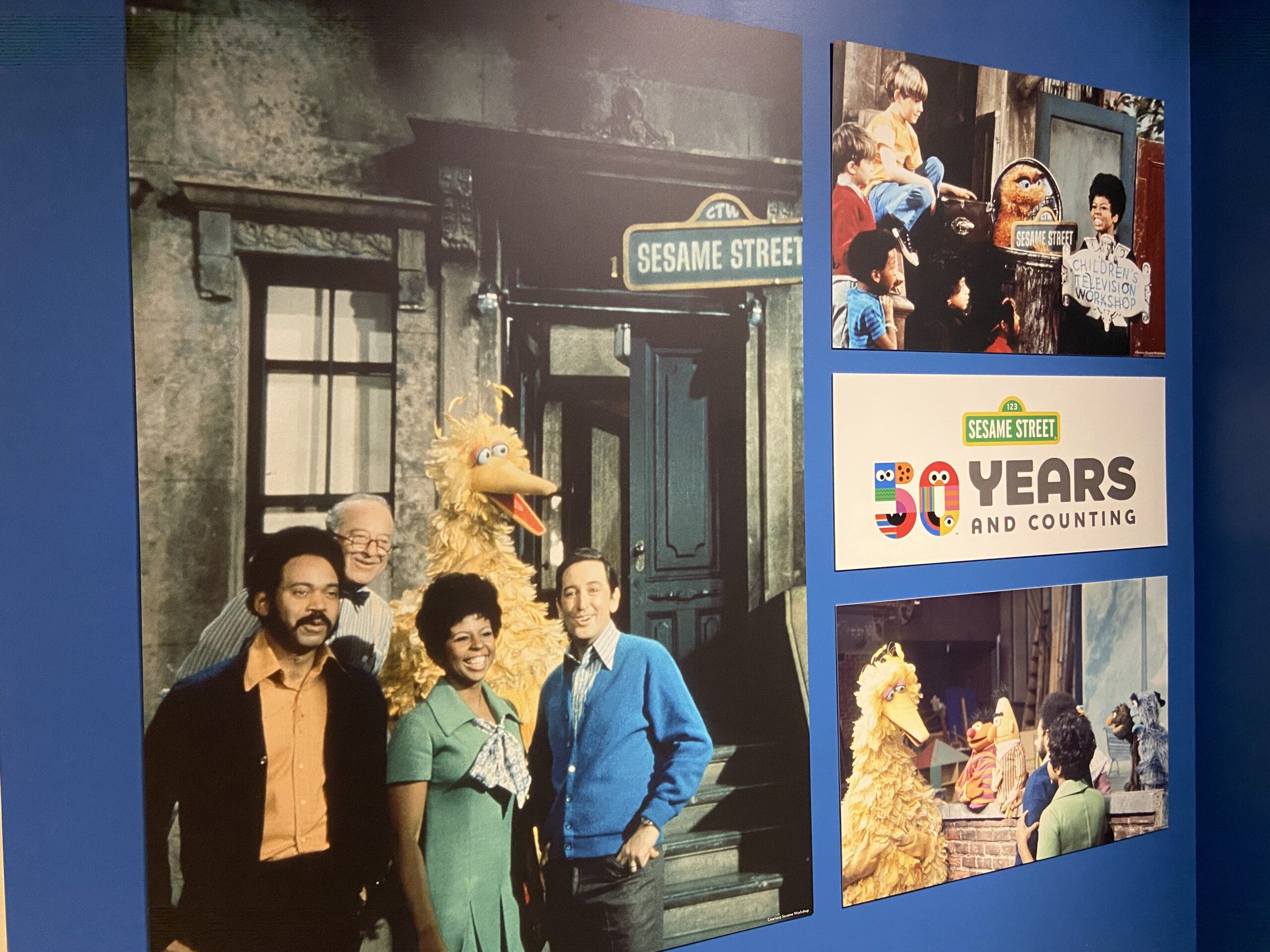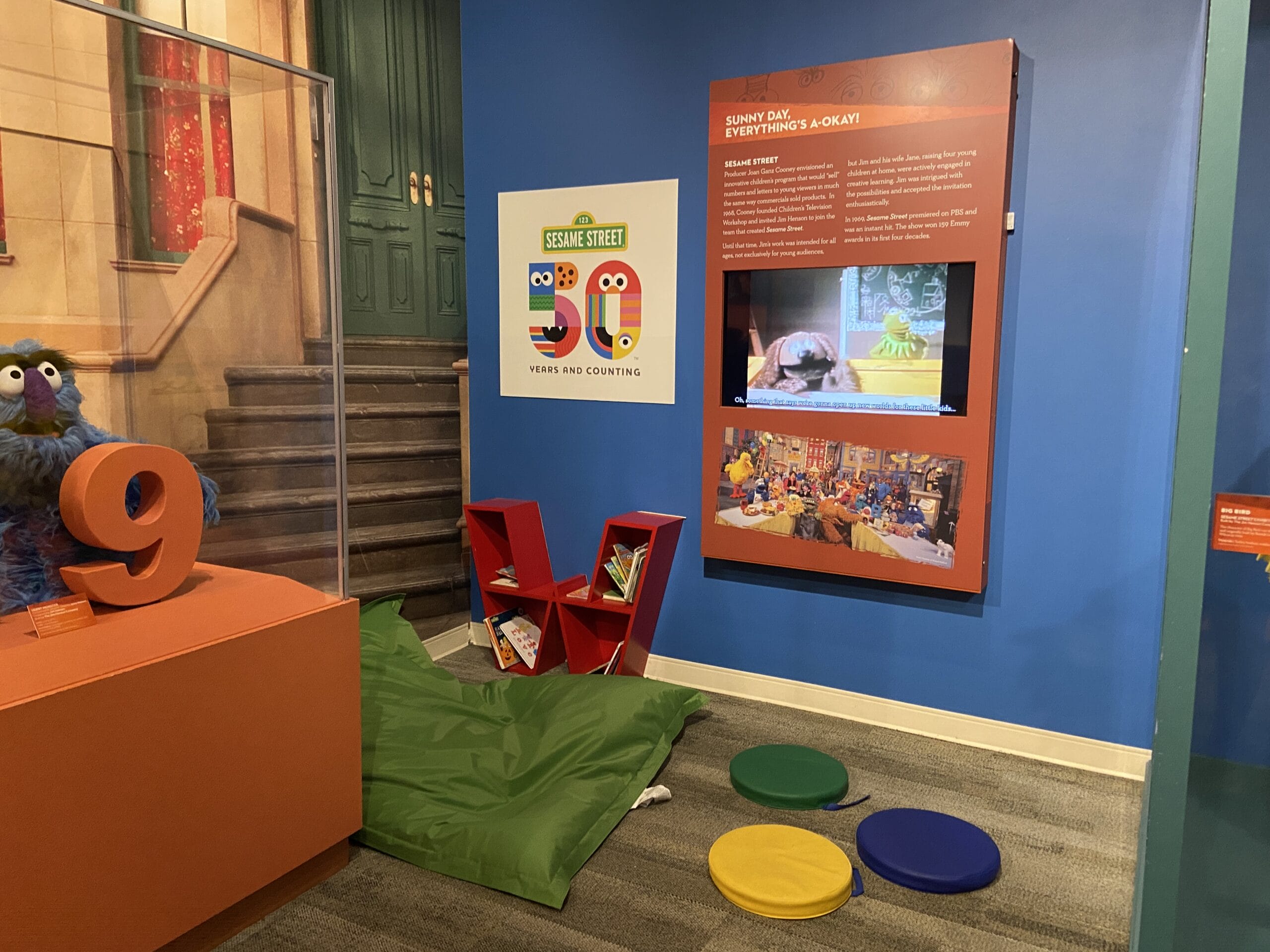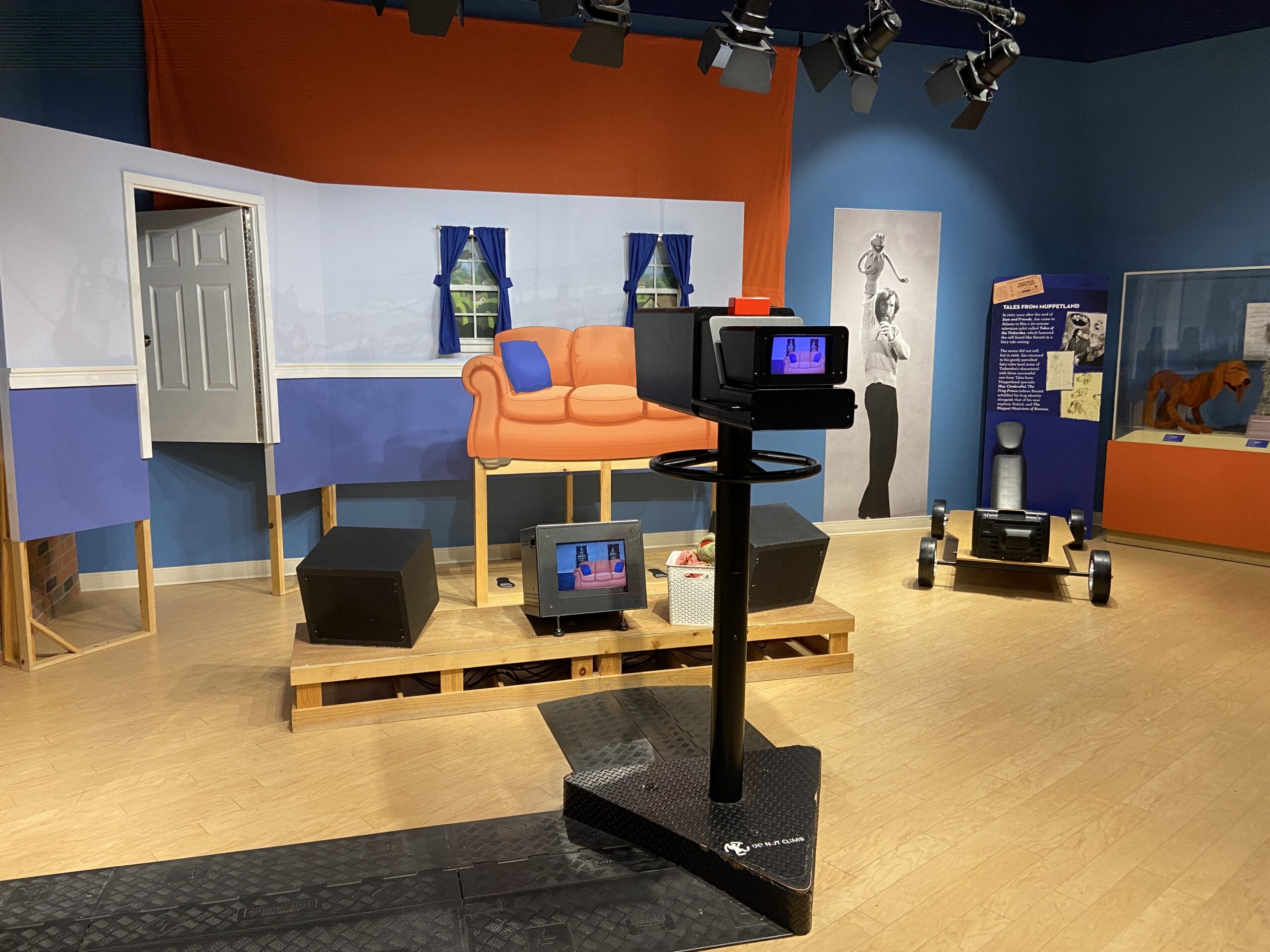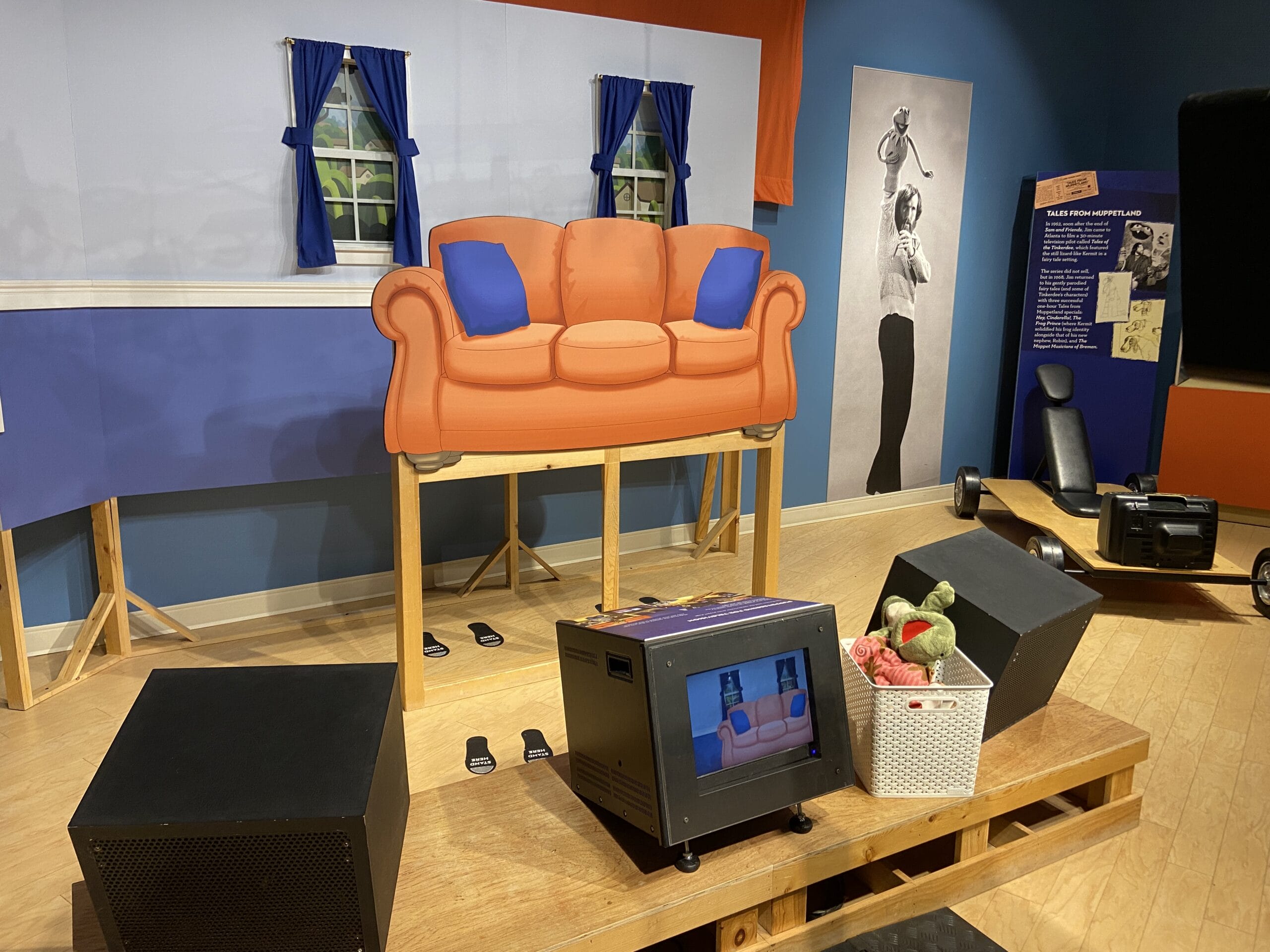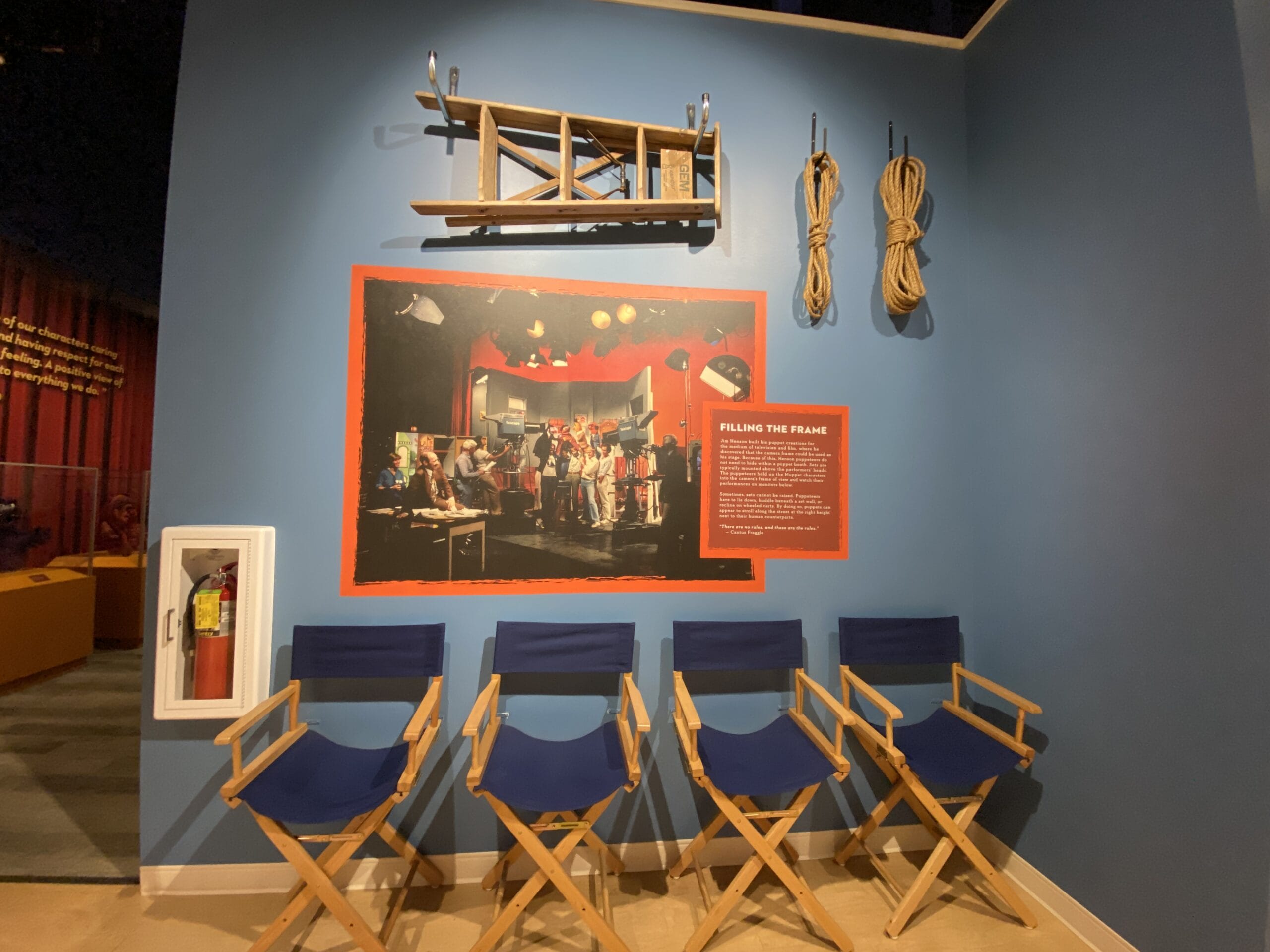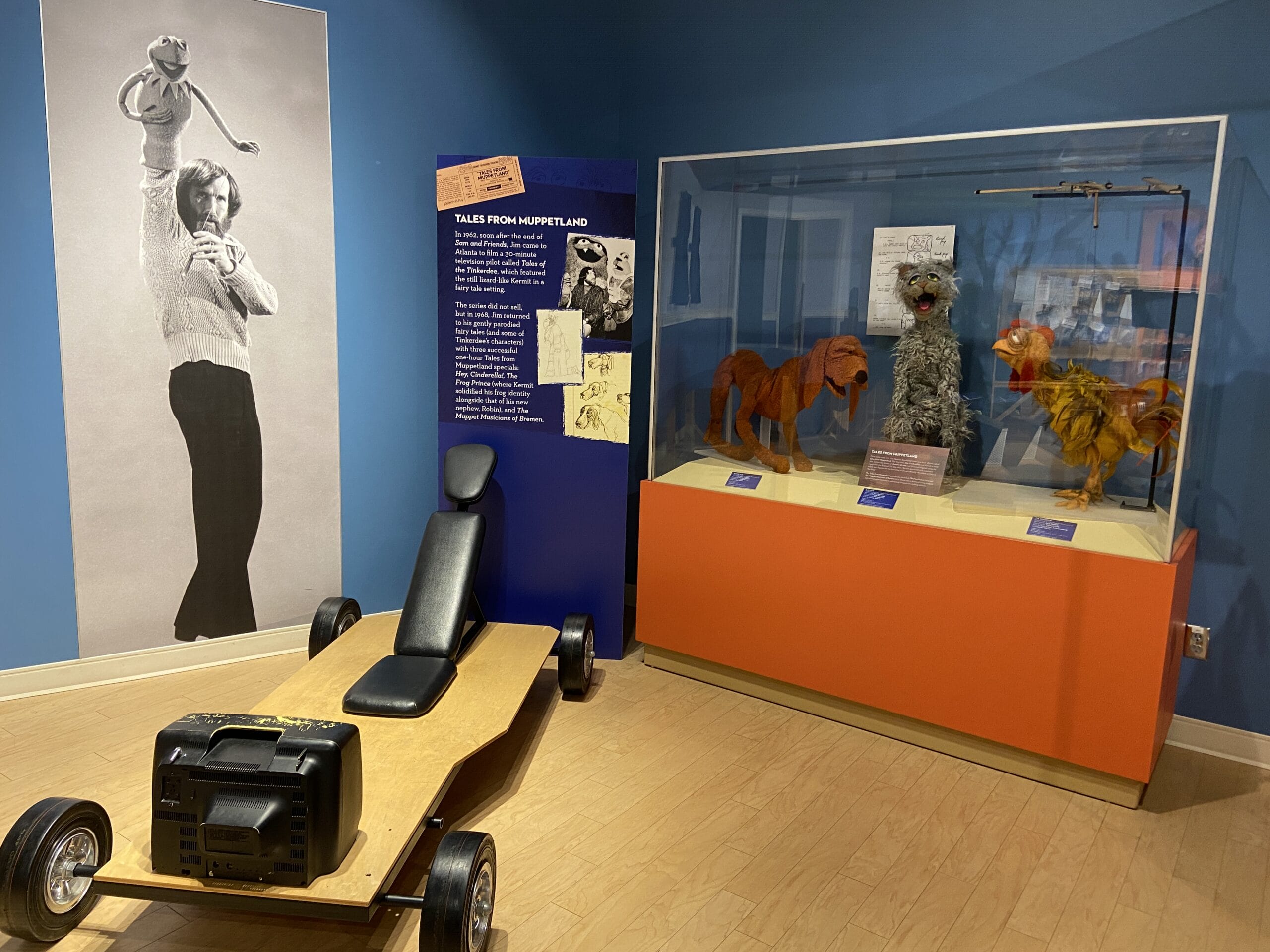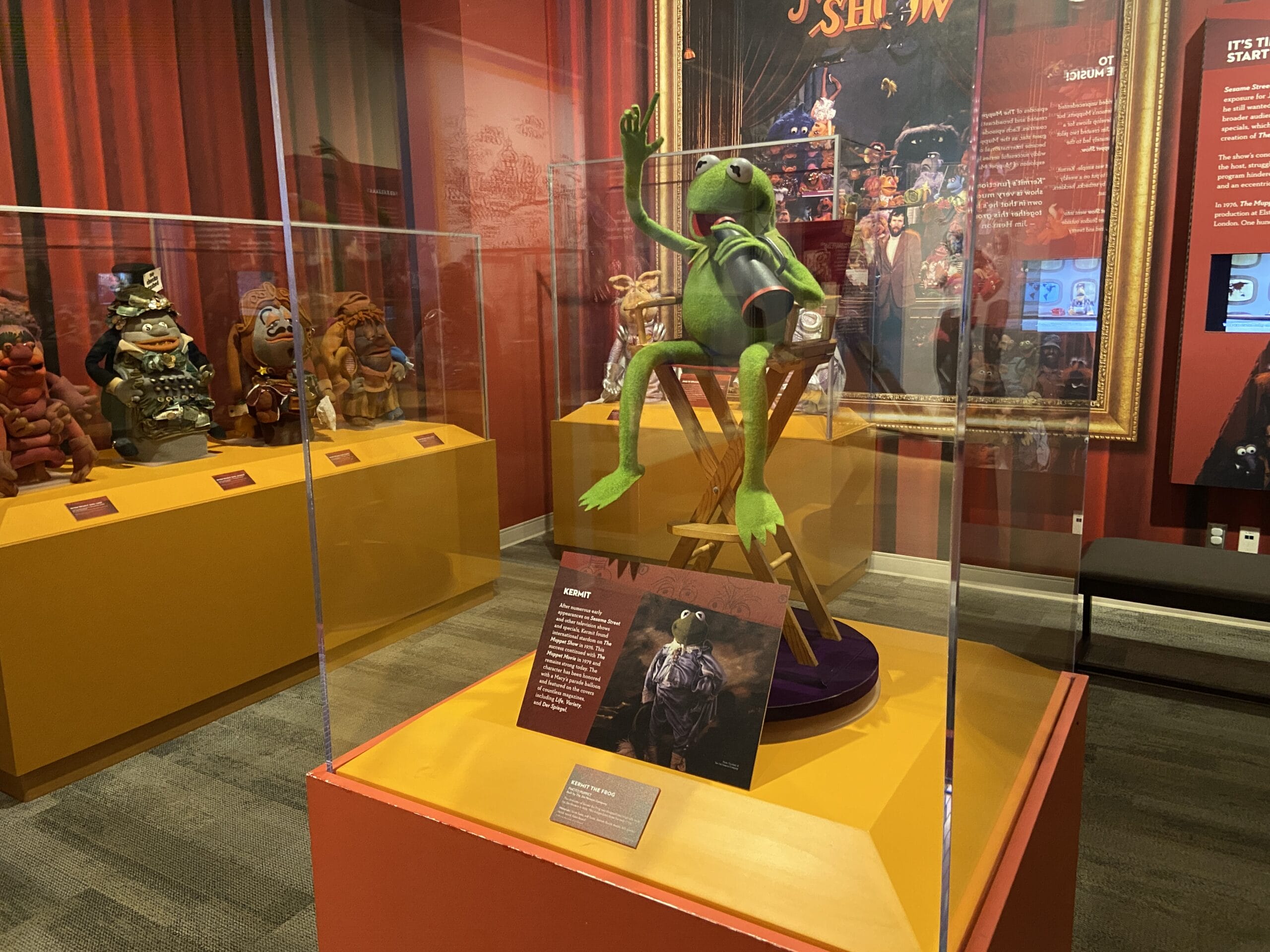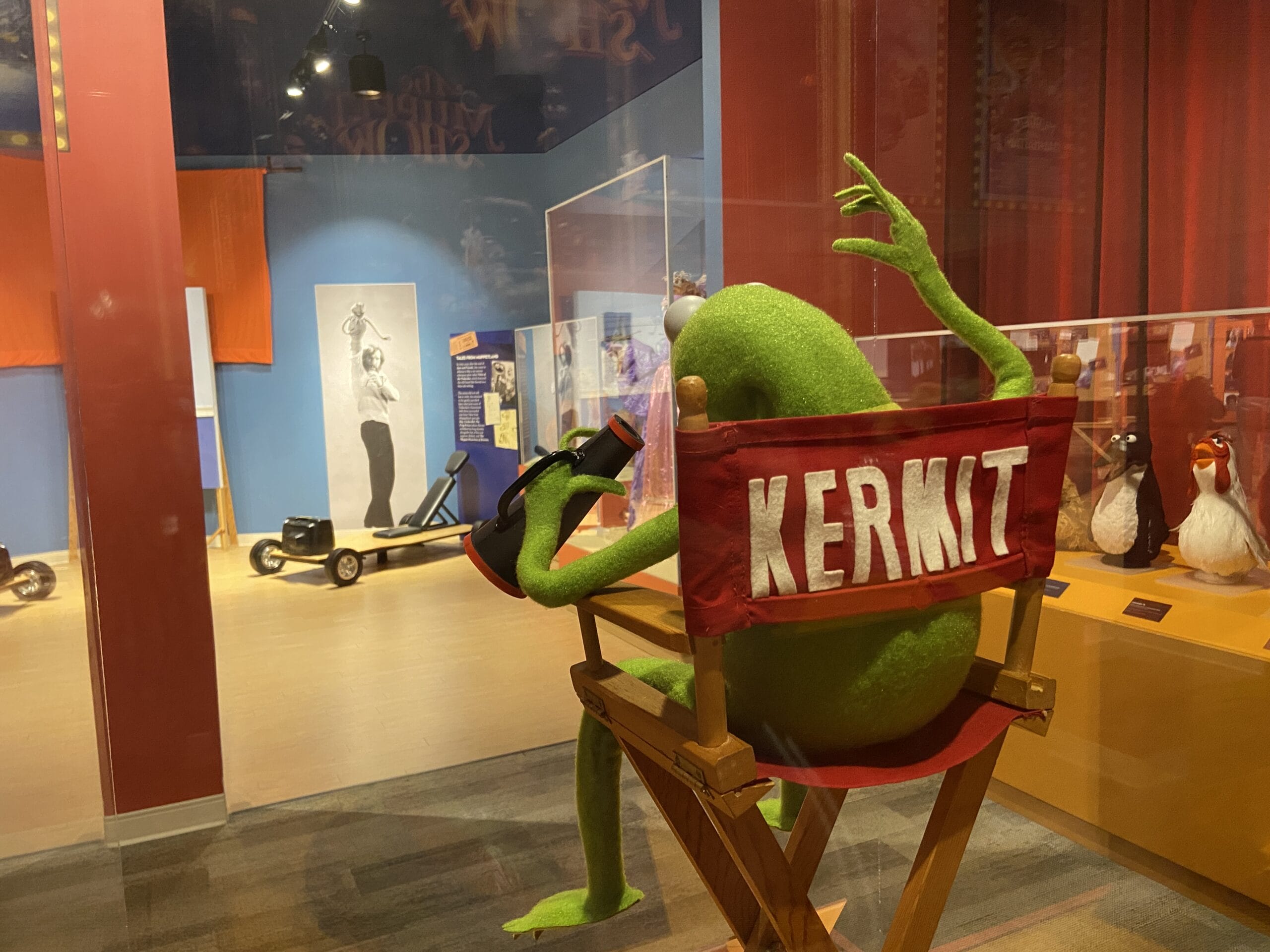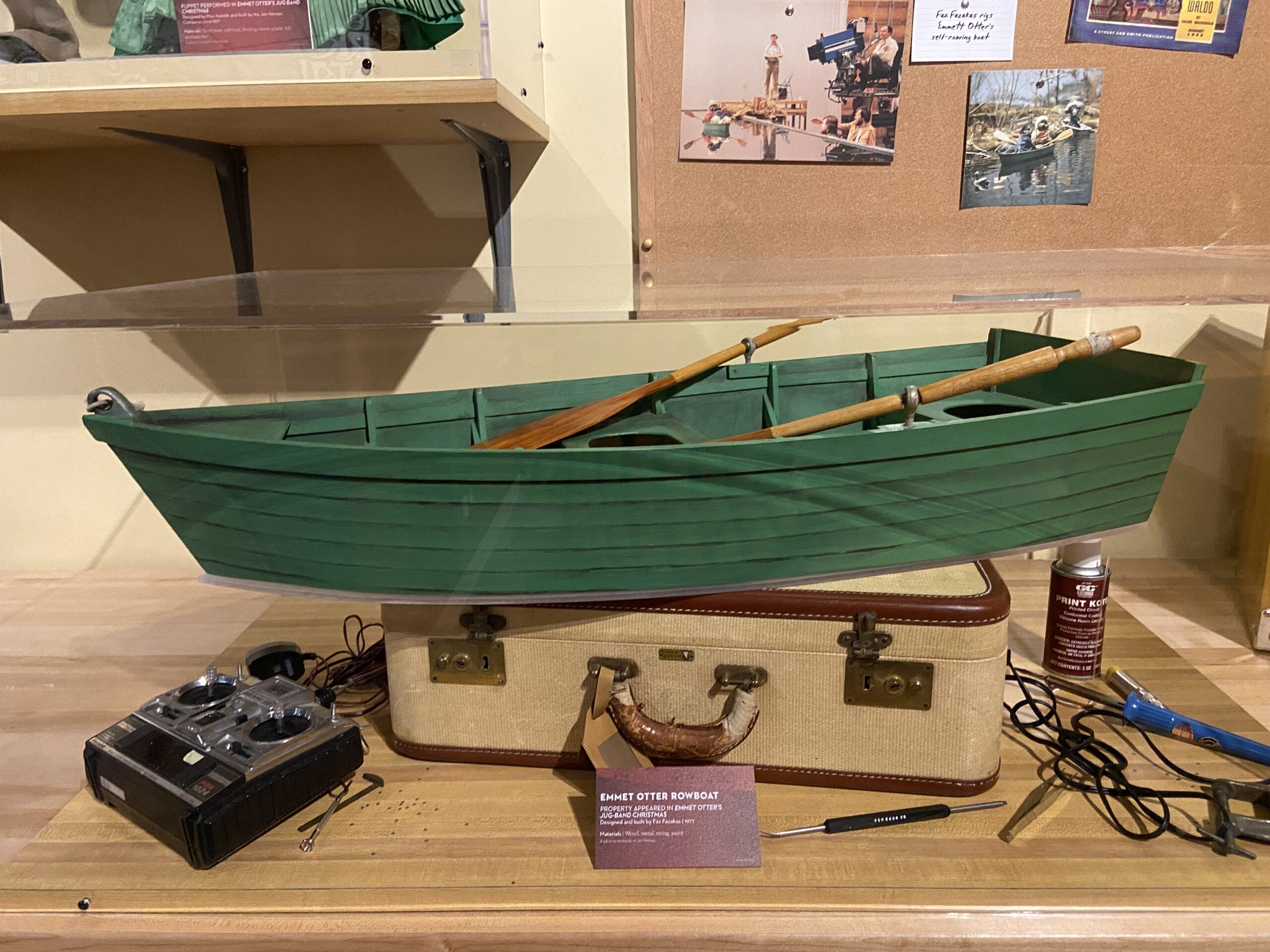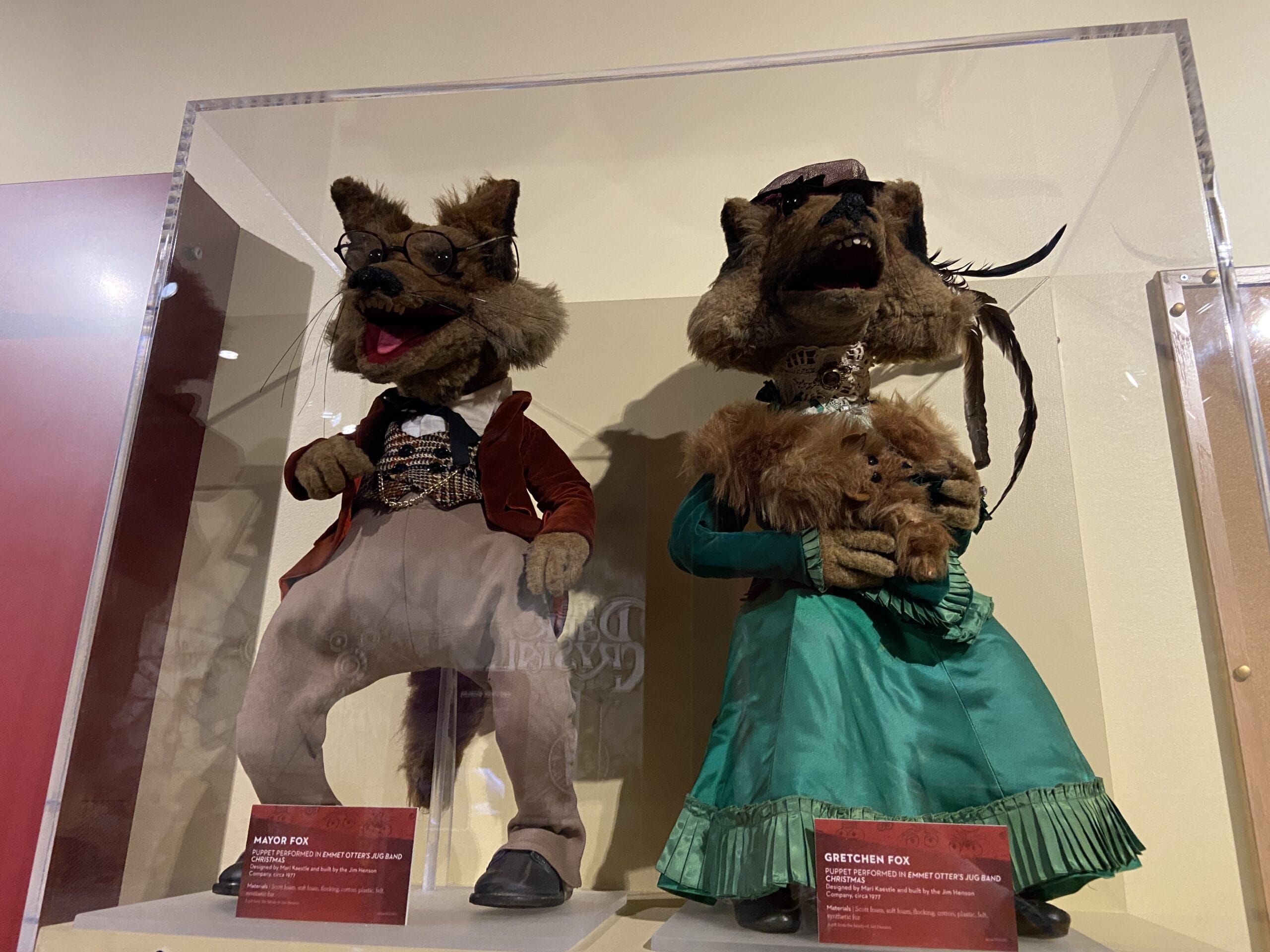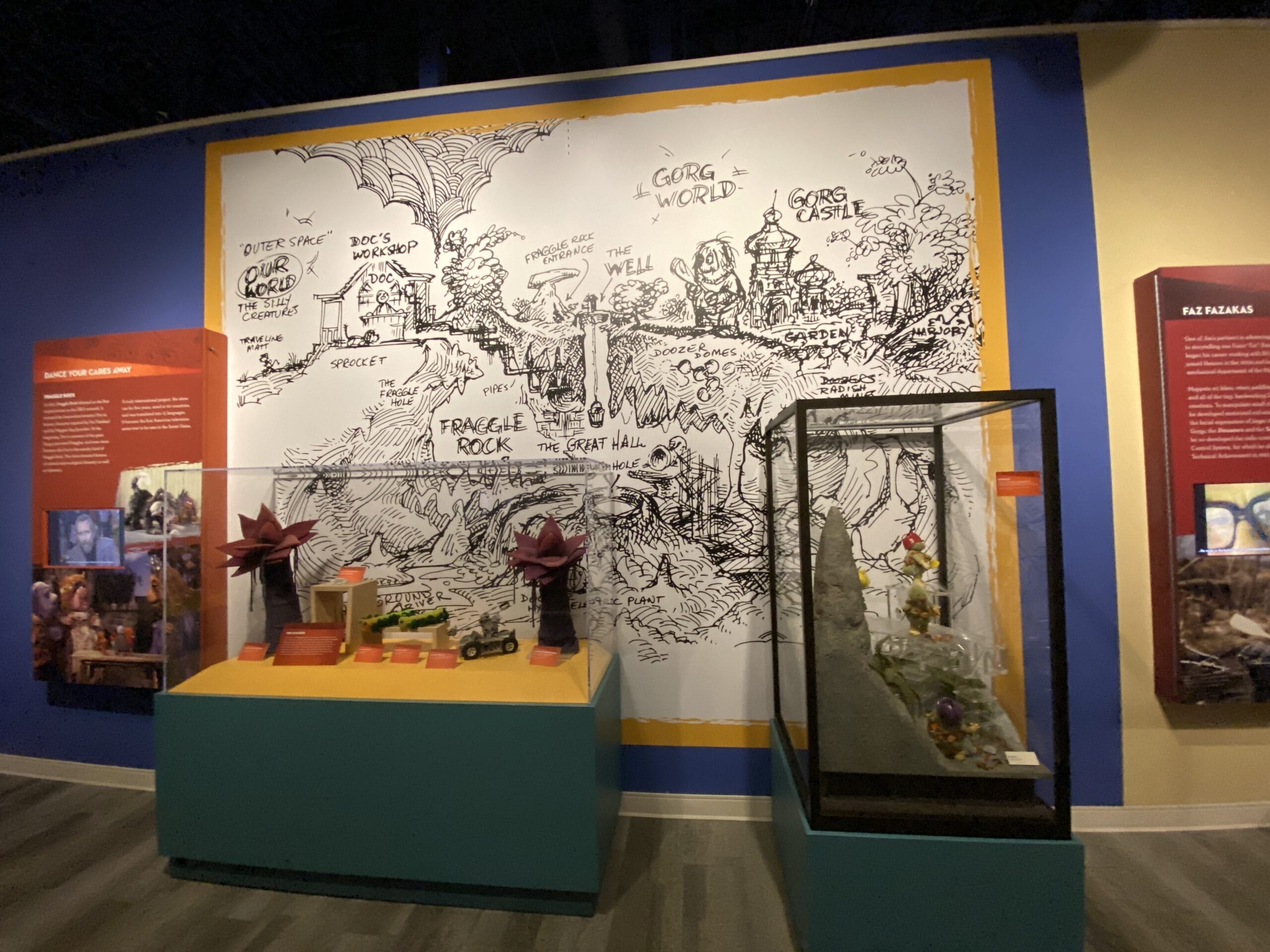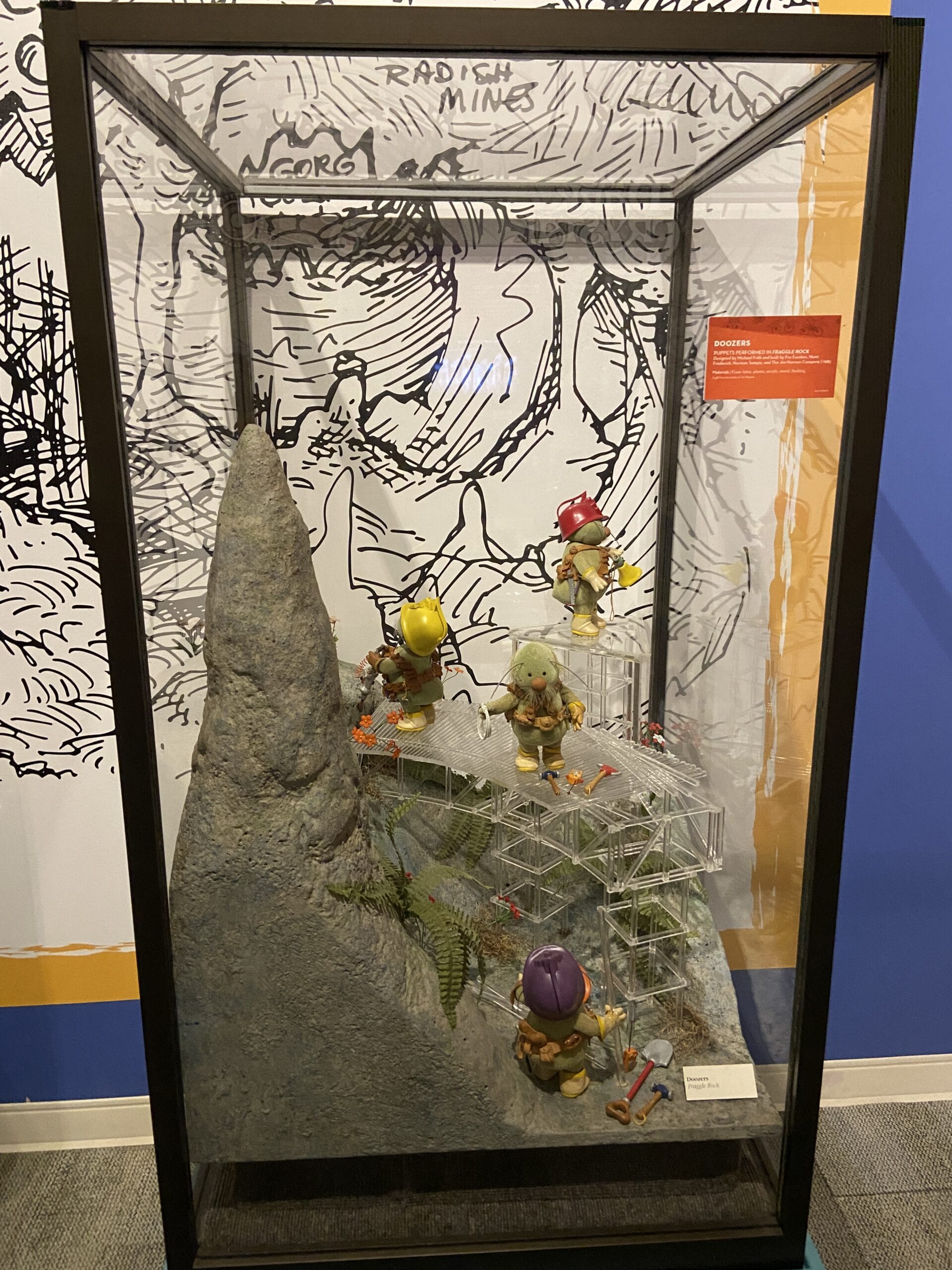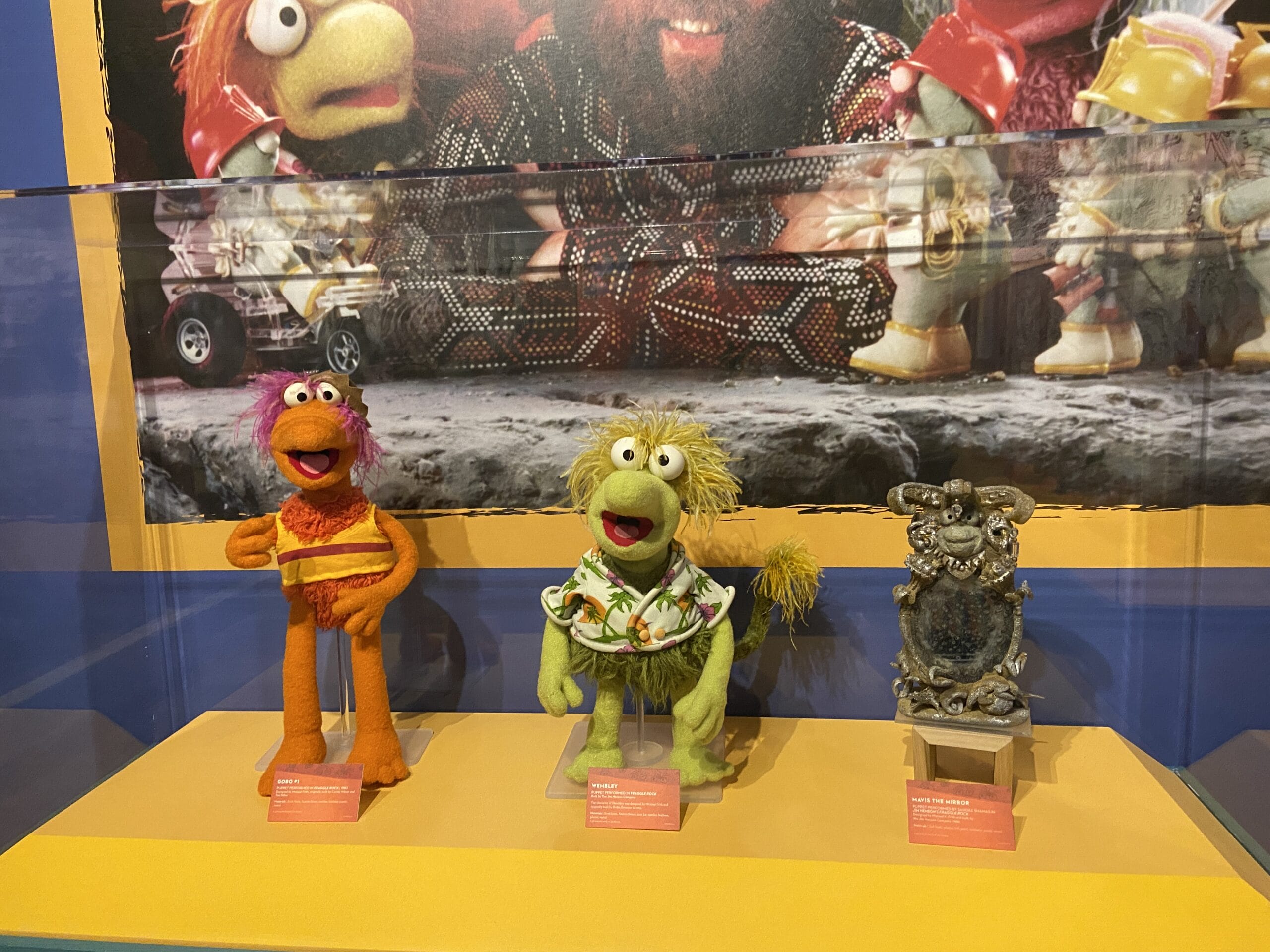If you’re a Muppet fan, we highly recommend visiting the Worlds of Puppetry Museum at the Center for Puppetry Arts in Atlanta, Georgia. The center celebrates the history of puppetry with shows, workshops, and exhibits, including Muppet displays.
Worlds of Puppetry Museum
The Jim Henson Collection is up year-round, rotating some of the items seasonally. But the 70 Years of The Jim Henson Company exhibit and Affectionate Anarchy: Creating with Jim Henson exhibit are only on display through October 26. The Global Gallery celebrates the history of puppetry as a whole and features some familiar non-Muppet faces.
70 Years of The Jim Henson Company
This year marks the 70th anniversary of The Jim Henson Company, and the Center is celebrating with a special pop-up exhibition highlighting the company’s enduring creativity and iconic brands with pieces from “Farscape,” “Dark Crystal: Age of Resistance,” “Sid the Science Kid” and more.
This exhibit is a small display outside of the main museum. A sign explains the history of The Jim Henson Company, which Jim and his wife Jane Henson founded in 1955. It’s headquartered in Los Angeles with additional locations in New York and London, and is also home to Jim Henson’s Creature Shop.
A TV at the front of this display (guarded by glass, of course) shows clips from various Jim Henson projects over the years. Along with the TV were a few interesting artifacts. On the far left is Dominar Rygel XVI from Farscape.
On the right are Clod from Earth to Ned, the hot dog puppet from Brian Henson Presents: Puppet Up! – Uncensored, Fizzgig #3 from The Dark Crystal: Age of Resistance, and Aughra from The Dark Crystal: Age of Resistance.
If you’re a fan of the original The Dark Crystal, more from the original 1982 film is in the museum. We’ll get to that later.
In the center of the display is a set of robotic gear — a glove and a joystick. These may not look familiar, but they are an important piece of Disney Parks history. This is the HDPS Waldo Rig, used to bring to life Waldo C. Graphic in Muppet*Vision 3D.
As the plaque reads:
The HDPS (Henson Digital Puppetry System) Waldo rig is used for real-time motion capture and animatronic puppetry. The system uses a combination of software and hardware to allow puppeteers to capture the art of puppetry live in three-dimensional graphics, allowing for more realistic movement and improvisation than traditional animation techniques. The Waldo rig was first used to create the character Waldo C. Graphic, which debuted in 1989 on The Jim Henson Hour. This character went on to have a prominent role in the Disney theme park attraction Muppet*Vision 3D. More recently, this technology was used to create shows like Splash & Bubbles, Word Party, and Earth To Ned.
Muppet*Vision 3D closed permanently this summer.
The Jim Henson Collection
Now on to the proper museum. The Jim Henson Collection is through an archway of cartoons, past a mural of Jim Henson and some of his most famous Muppets.
The gallery follows Jim Henson’s career, beginning with “Sam and Friends” and Wilkins and Wontkins. Jim Henson became a puppeteer in high school in Hyatsville, MD, and worked for the local CBS station’s Junior Morning Show. Soon after, he was hired by NBC affiliate WRC-TV where he first introduced his Muppet characters on the programs Afternoon with Inga and Footlight Theater.
But the Muppets really began with Sam and Friends, a five-minute program created by Jim and his partner (future wife) Jane Nebel. Sam and Friends ran on WRC-TV for six years and introduced Kermit. The Muppet on display in this room is Omar, another Sam and Friends character.
Following the success of Sam and Friends, Jim and Jane created over two hundred short, comic ads for Wilkins Coffee starring Muppets Wilkins and coffee-hating Wontkins.
Another sign highlights some of the famous performers and puppets that came to the Hensons early in their career. Jim Henson met Jerry Juhl in 1961 and Juhl joined the Muppets team on Sam and Friends, initially as a puppeteer. He later shifted to writing, becoming the head writer for The Muppet Show and Fraggle Rock.
In 1962, Jim Henson hired Don Sahlin to create a dog puppet named Rowlf, who starred in a commercial for Purina Dog Chow before becoming a regular recurring guest on “The Jimmy Dean Show.” Sahlin became the principal Muppet builder and “essence checker.”
Around this time, Henson hired Frank Oz, who co-puppeteered Rowlf with Henson. Oz would go on to become a frequent partner with Henson and famously puppeteered Bert, Miss Piggy, Grover, and Yoda in Star Wars.
The next room features a recreation of Jim Henson’s office. There are framed photographs, a shelf of books, Emmy awards, and a Kermit the Frog statue. The photos include pictures of Jim, Jane, and Kermit at the opening of the Center for Puppetry Arts in 1978.
The papier-mâché light-up moose head on the wall was crafted by John D. Richards and displayed prominently in Henson’s New York offices. The Bert, Ernie, and Cookie Monster needlepoint was created by Jim’s Aunt bobby, Barbara Miltenberger Henson.
Jim Henson used to keep track of his work projects, family milestones, arrivals of puppeteers, collaborators, and more in a little red book, as seen on the desk. The hand-painted blocks were made by Jim for his children in the 1960s.
This replica of a famous window hangs near the office display.
This is a reproduction of a stained glass window that hung in Jim Henson’s New York City office. Head writer Jerry Juhl commissioned the top half of the window to give to Jim as a Christmas present, and the following year provided the lower half to complete the image. The original window currently hangs in the New York location of Jim Henson’s Creature Shop.
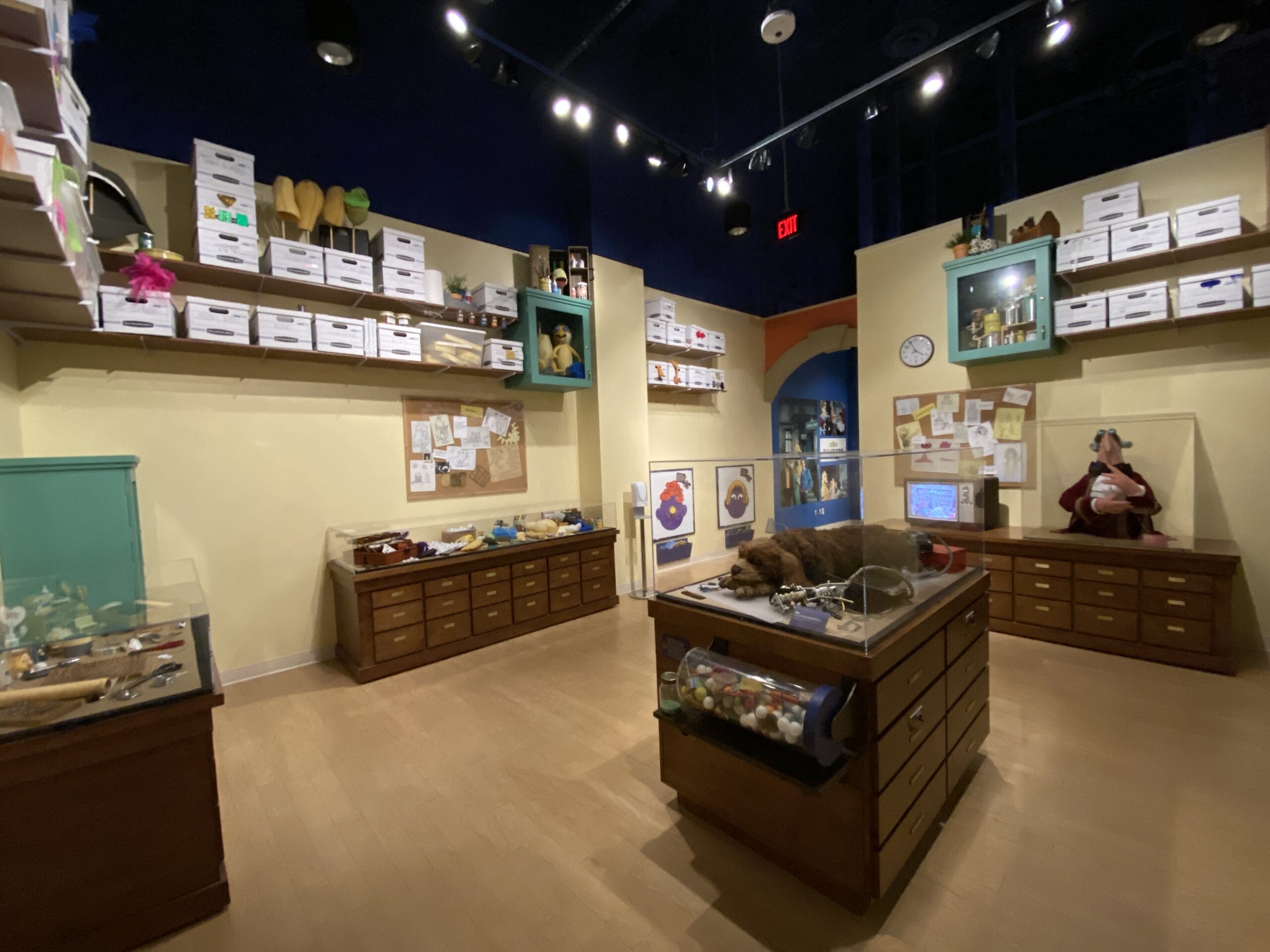
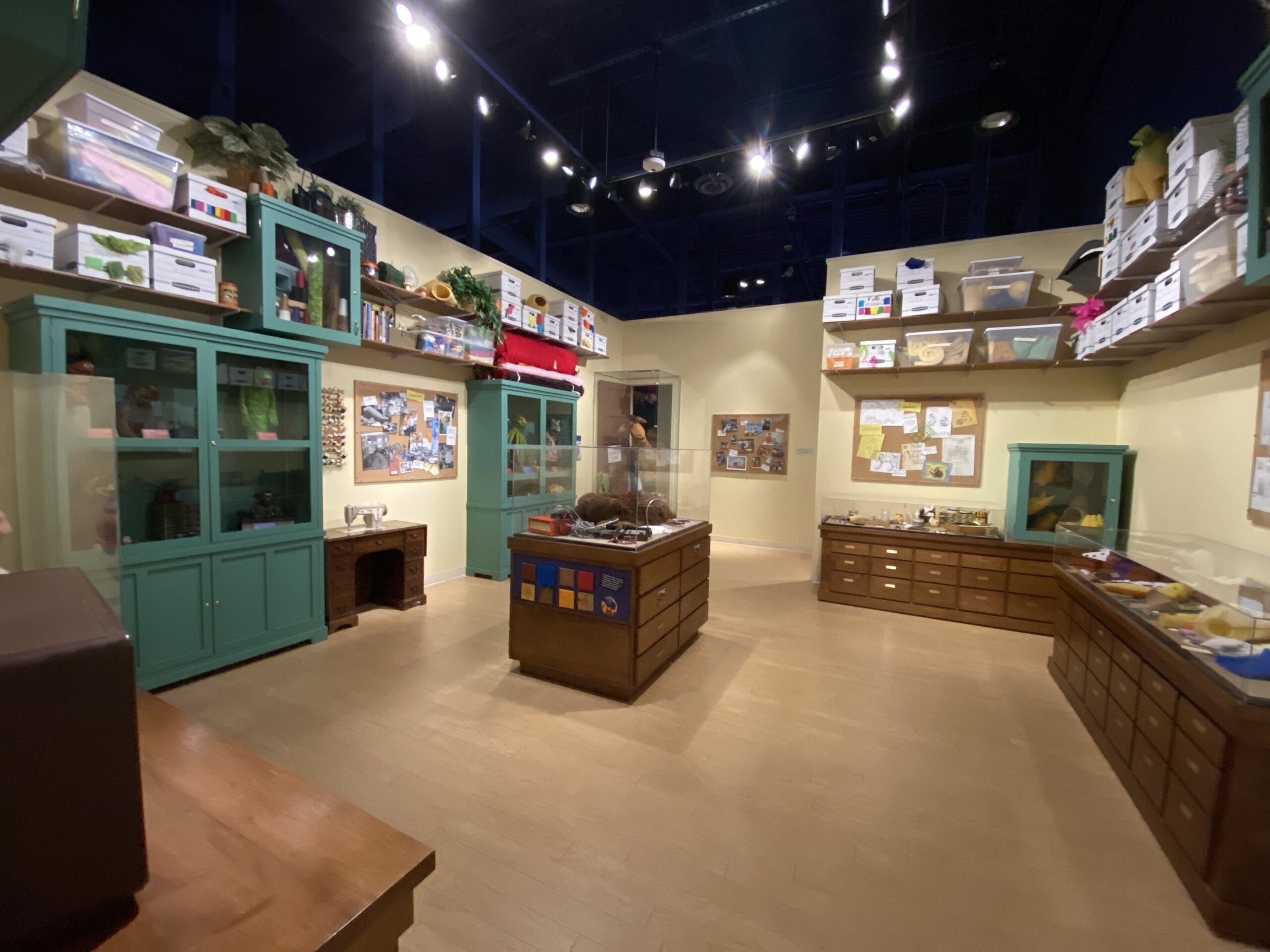
The next room looks like a workshop where you might put together some Muppets. The boxes on the wall shelves are labeled with different puppet supplies, character names, accessories, and more. The drawers are similarly labeled.
A Muppet camel leans out of a storage closet behind glass. This is Sopwith, who made various appearances in The Muppet Show and other Muppet projects.
Hanging on the closet door is a green jacket with two familiar cutouts. This is an homage to the coat that Jim Henson’s mother discarded. Jim picked it up and turned it into Kermit (with the help of a ping pong ball). This depiction of the coat, however, is apocryphal as Kermit did not have his signature frill around his neck when first created.
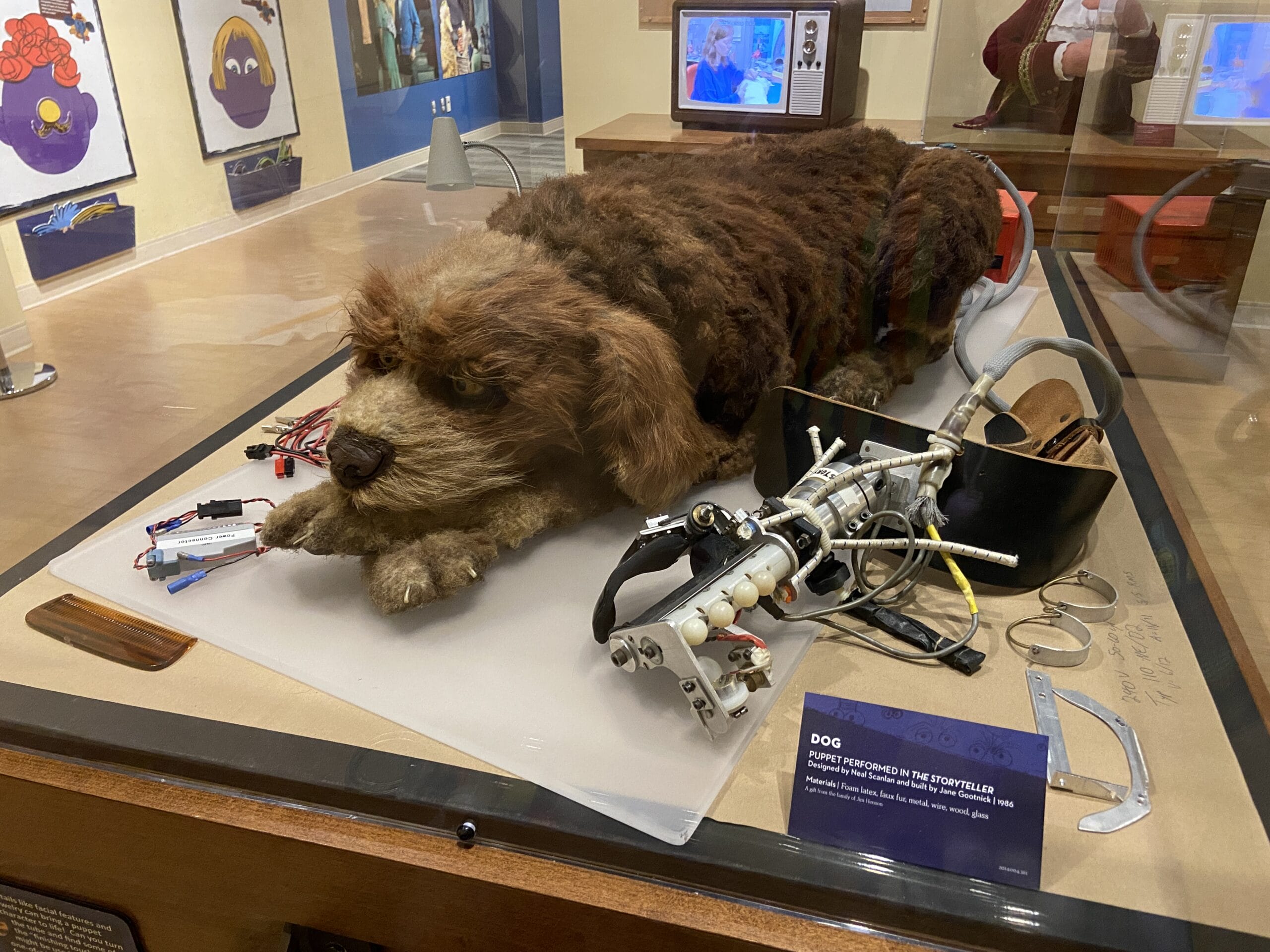
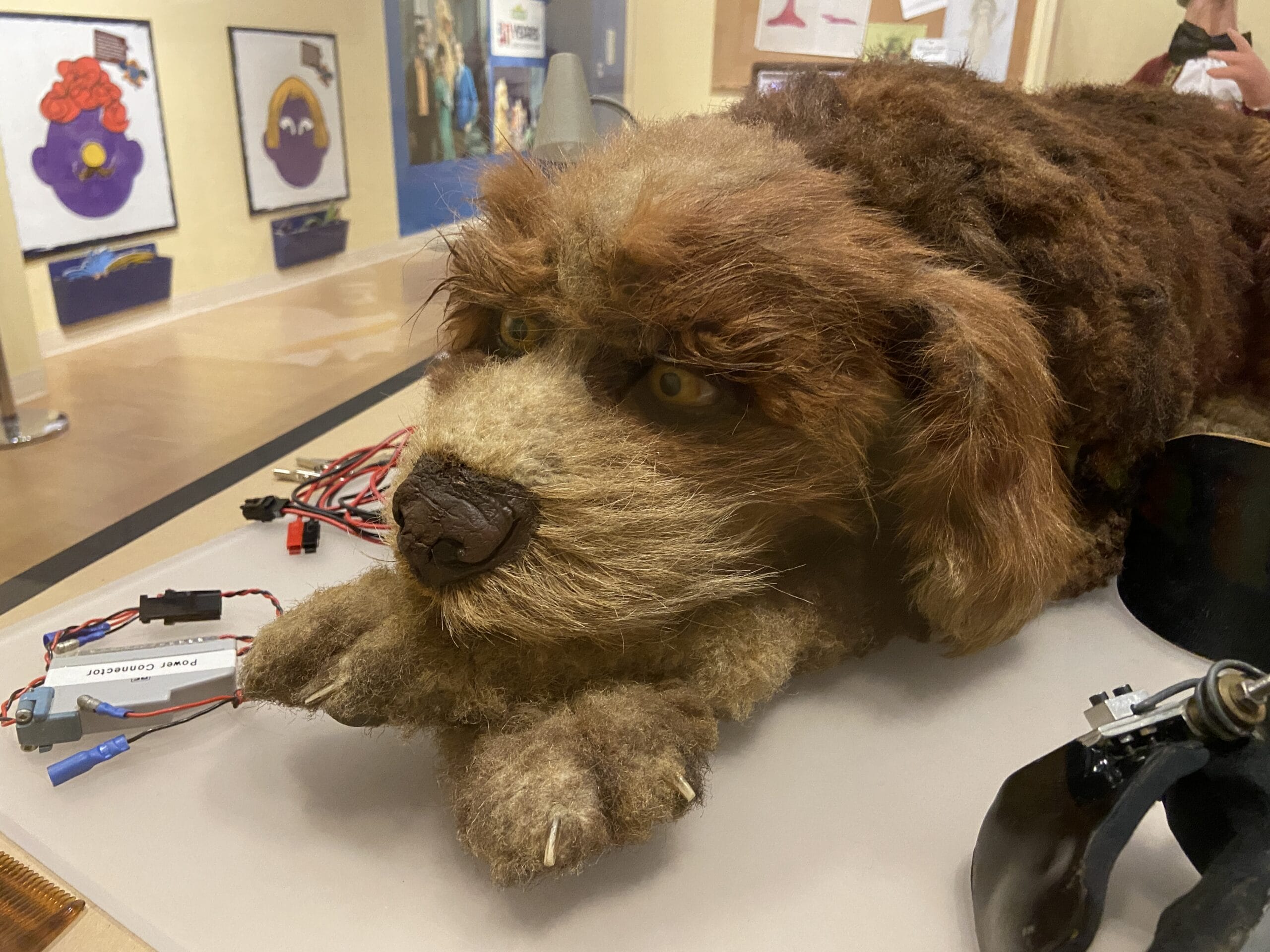
The dog from The StoryTeller is in the center display case. This puppet was designed by Neal Scanlan and built by Jane Gootnick in 1986. Materials listed on the sign are foam latex, faux fur, metal, wire, wood, and glass.
Boxes are overflowing with scraps of fabric and Muppet pieces — like a pink arm sticking out of one box. There are boxes labeled Waldorf Statler and Statler Waldorf.
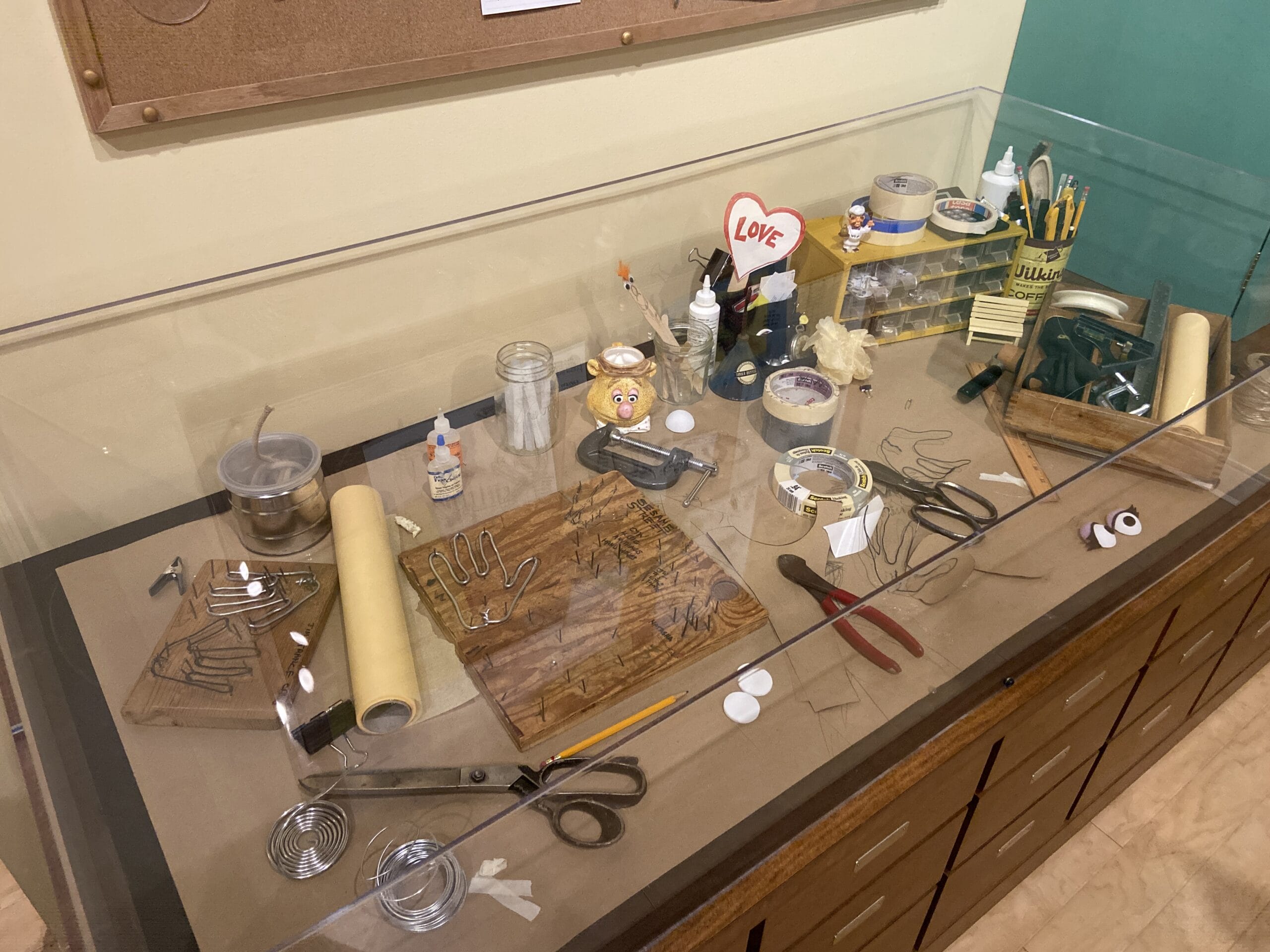
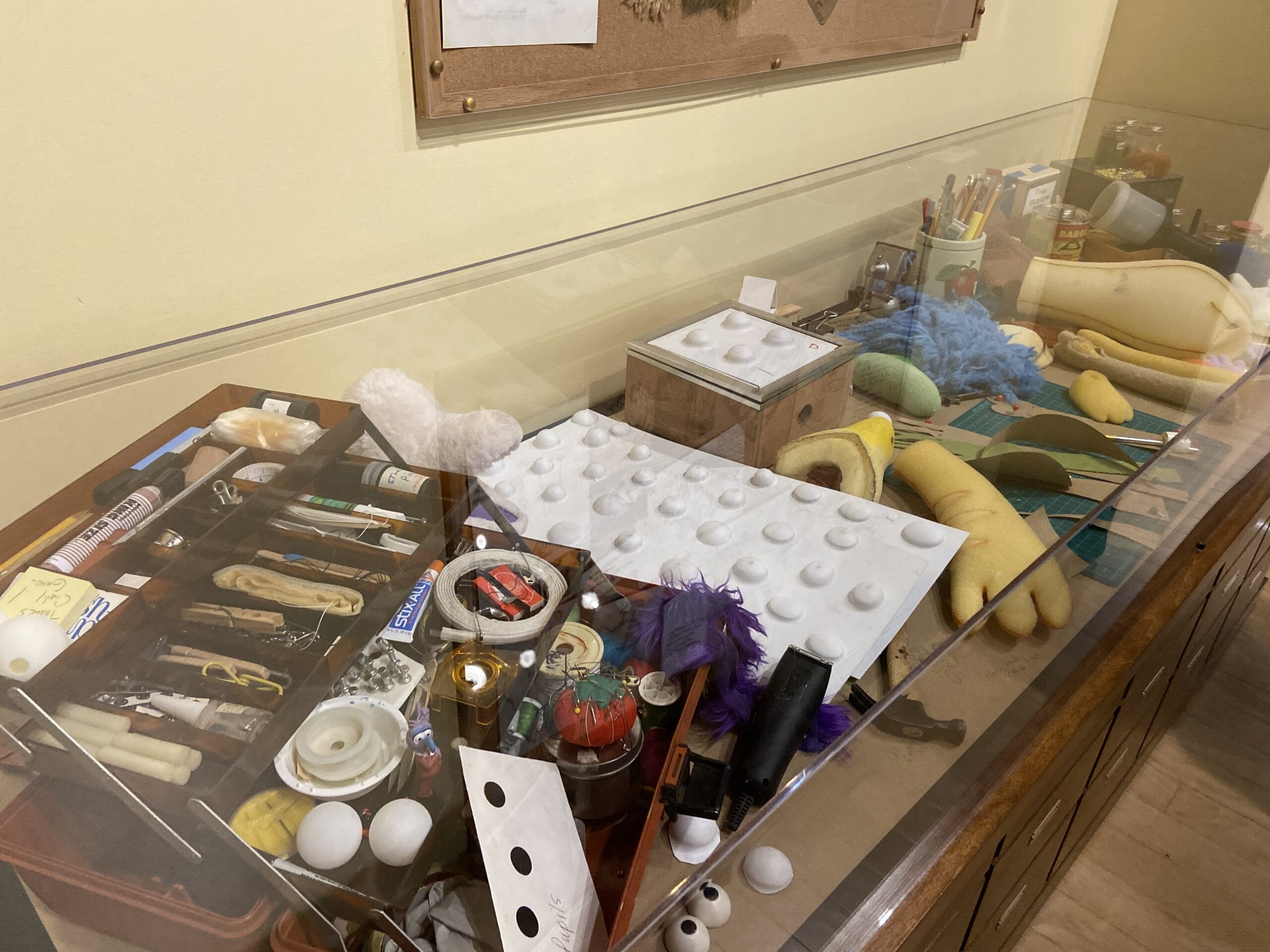
Muppet creation tools are in other glass cases. Boards with nails in them are used to shape the wire of puppet hands. Of course, there’s a stocked sewing kit.
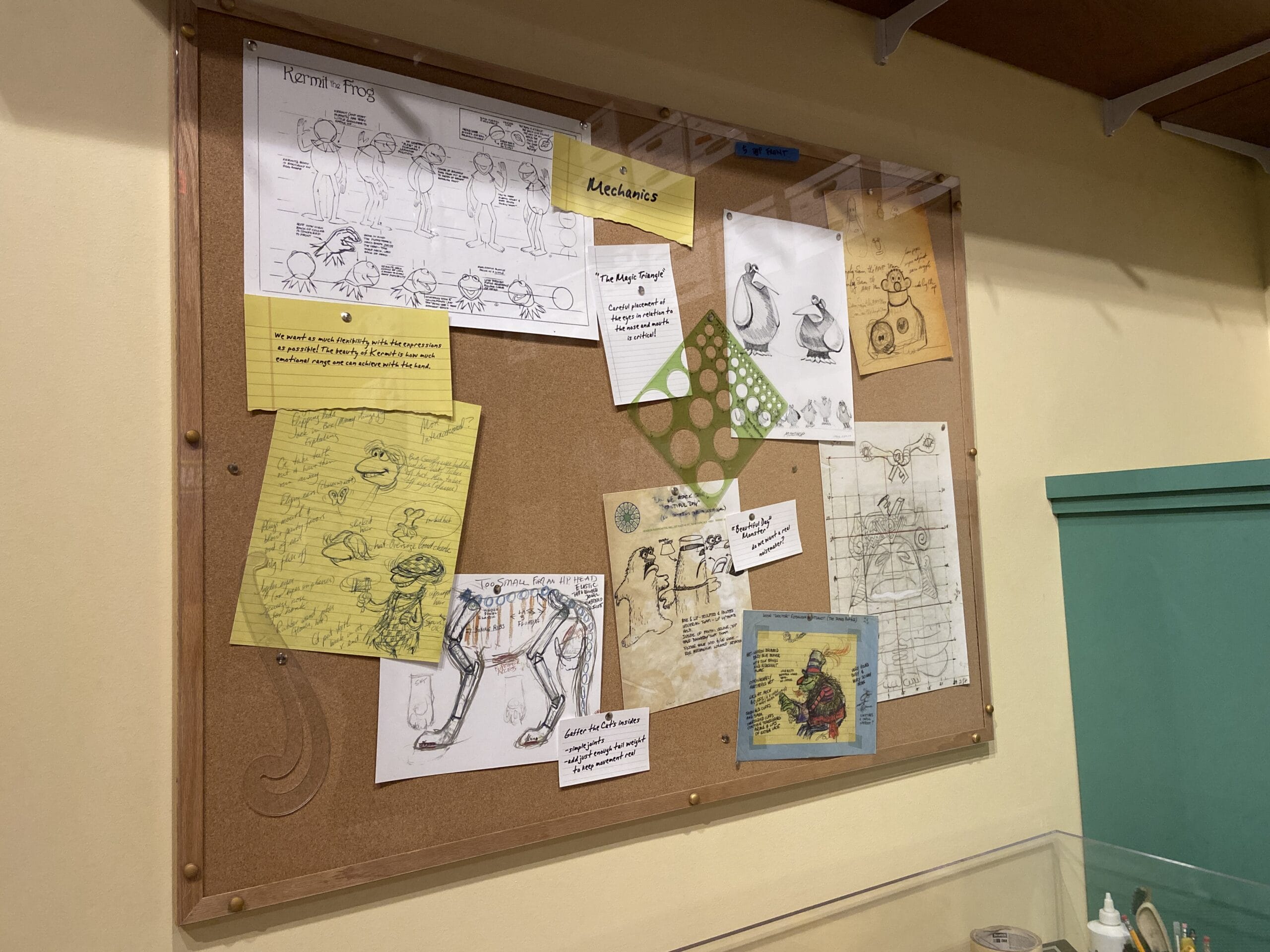
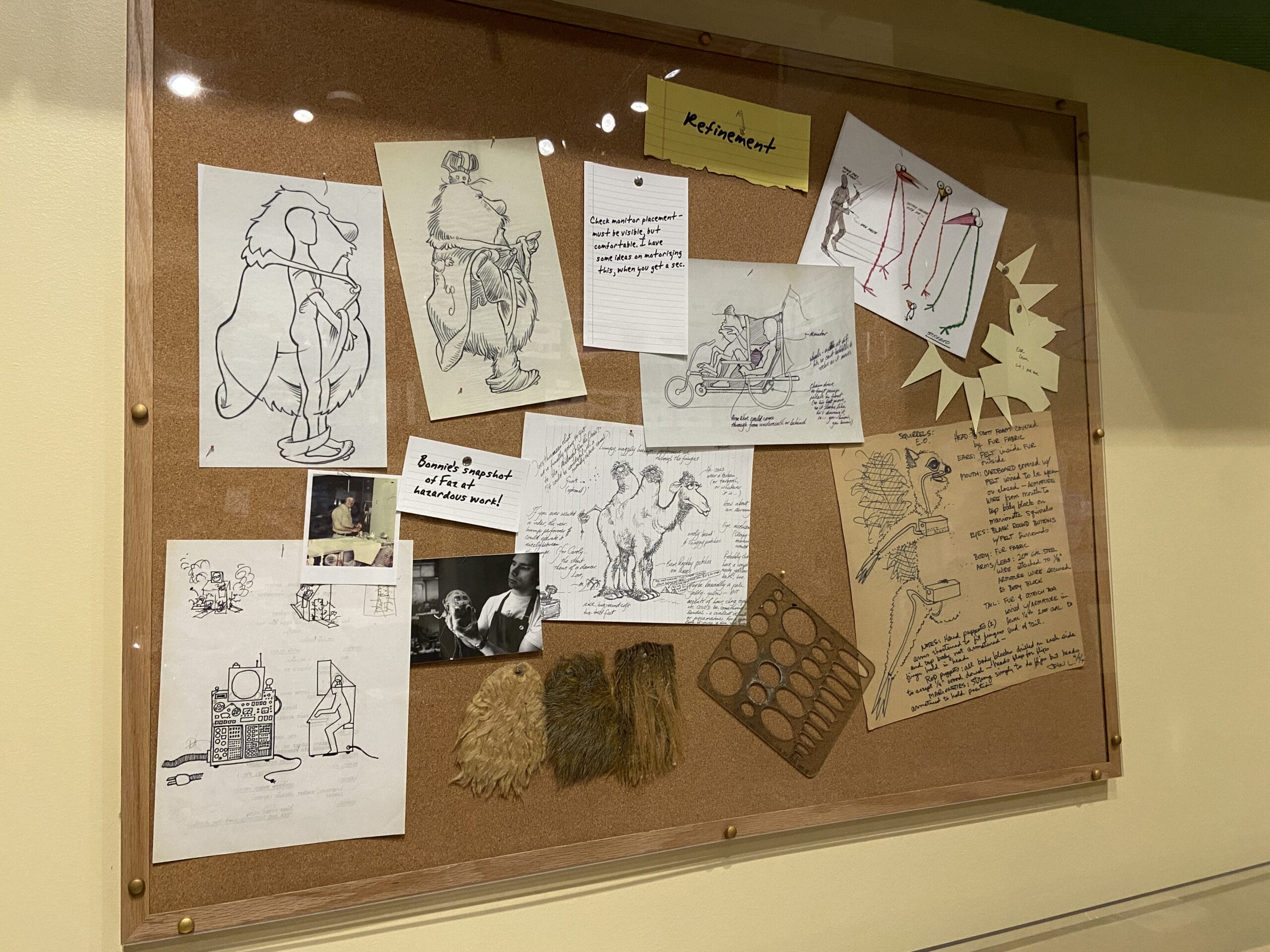
Cork boards display Muppet concept sketches, fabric swatches, stencils, and more elements from the design process.
The next section is dedicated to “Sesame Street,” which turned 50 in 2019.
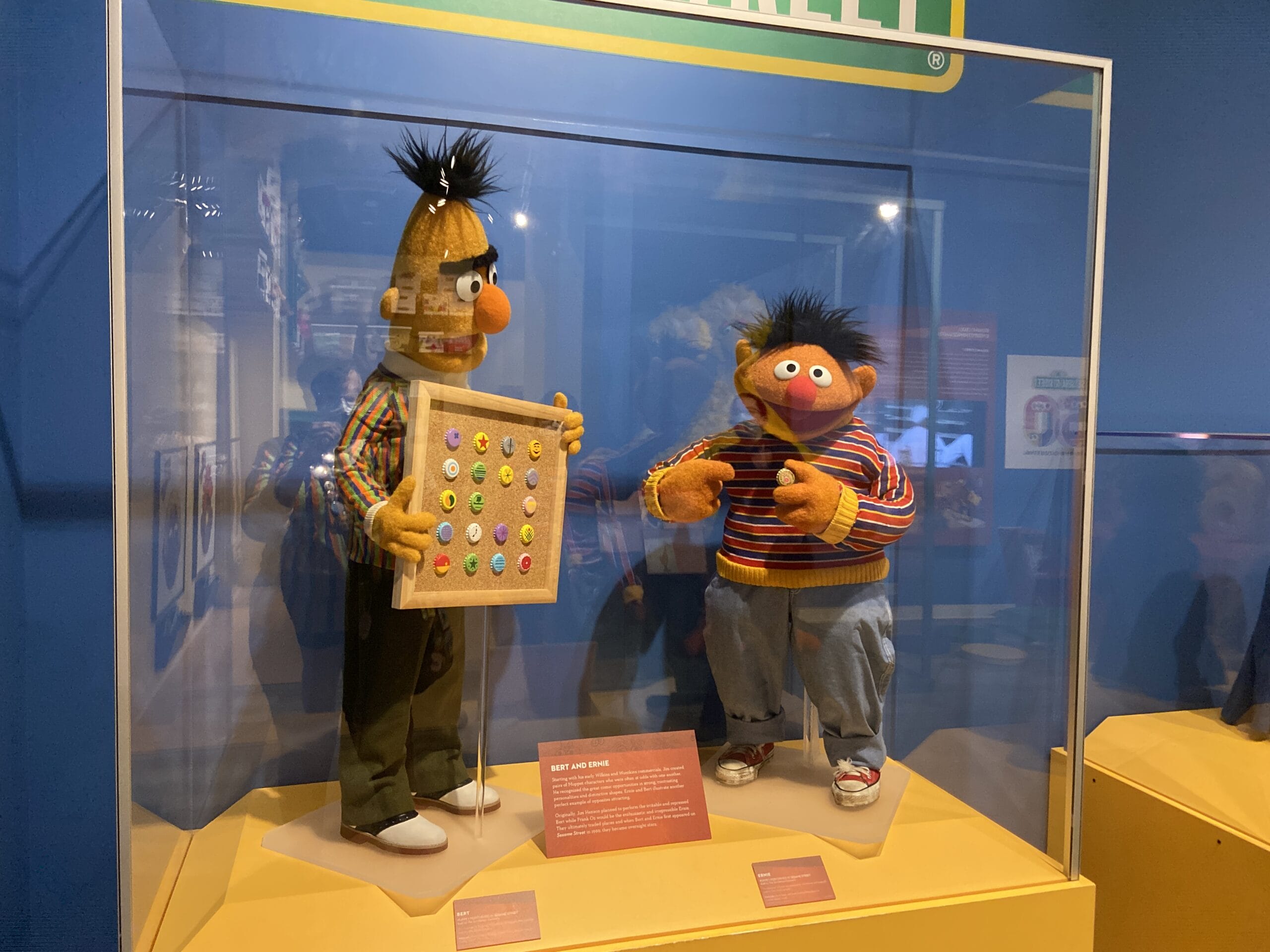
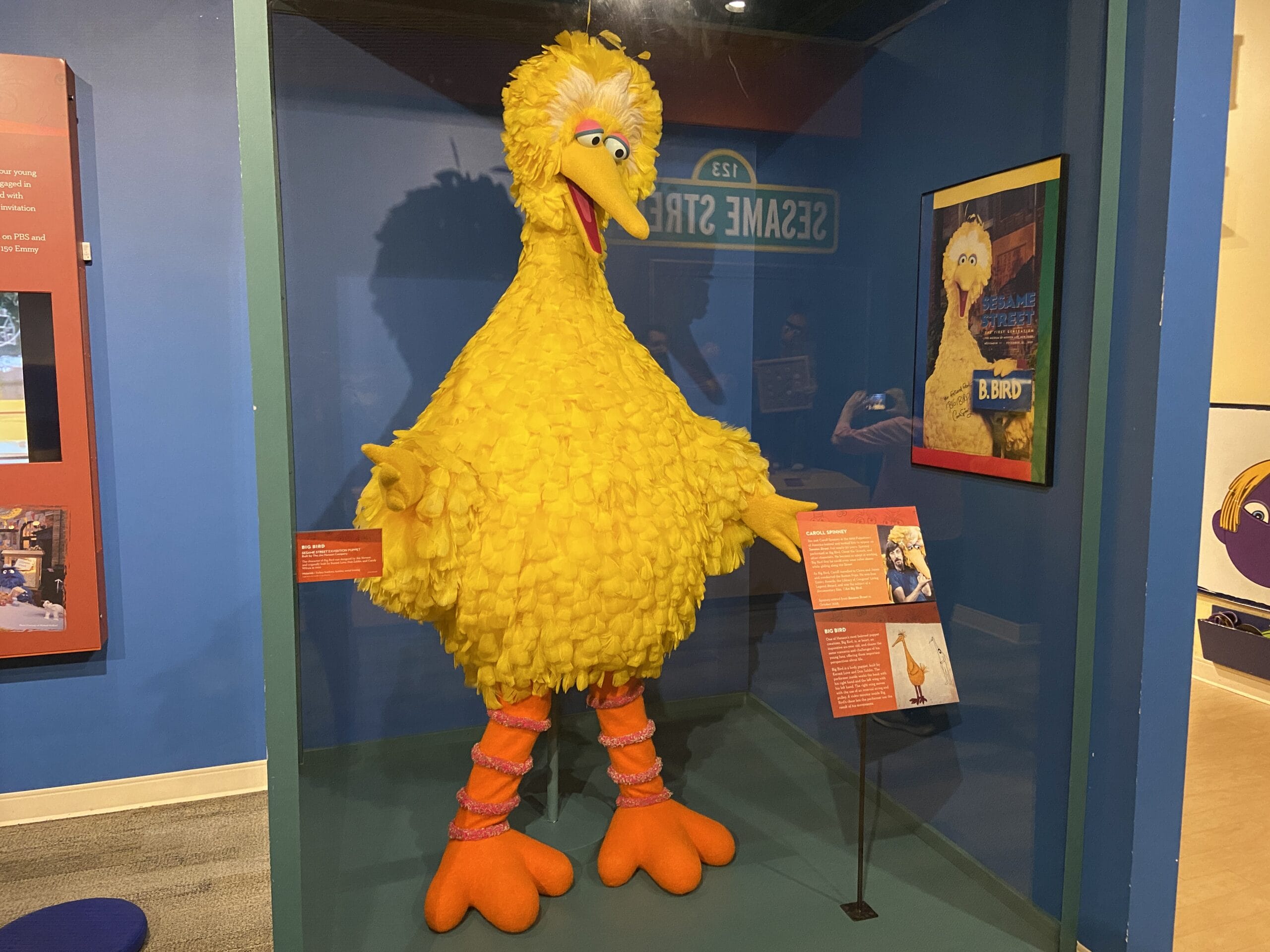
Guests are greeted by puppets of Bert and Ernie. Around the corner is Big Bird and a plaque dedicated to performer Caroll Spinney.
This space has some books and floor mats for kids to sit and read.
There’s a fake set so you can experience puppetry yourself. Note that all the furniture and flats are raised, so puppeteers can stand while the puppets are on camera.
There’s a live feed and monitors so you can view yourself as you puppeteer.
There are also directors’ chairs at the back of the room.
Filling the Frame
Jim Henson built his puppet creations for the medium of television and film, where discovered that the camera frame could be used as his stage. Because of this, Henson puppeteers do not need to hide within a puppet booth. Sets are typically mounted above the performers’ heads. The puppeteers hold up the Muppet characters into the camera’s frame of view and watch their performances on monitors below.
Sometimes, sets cannot be raised. Puppeteers have to lie down, huddle beneath a set wall, or recline on wheeled carts. By doing so, puppets can appear to stroll along the street at the right height next to their human counterparts.
One such cart is mounted to the floor. Guests can also recline on this and practice keeping their arm raised.
In the next room is Kermit the Frog himself. He sits in a display case of honor in front of a giant The Muppet Show poster.
He’s positioned so he is waving at the portrait of Jim Henson in the previous room.
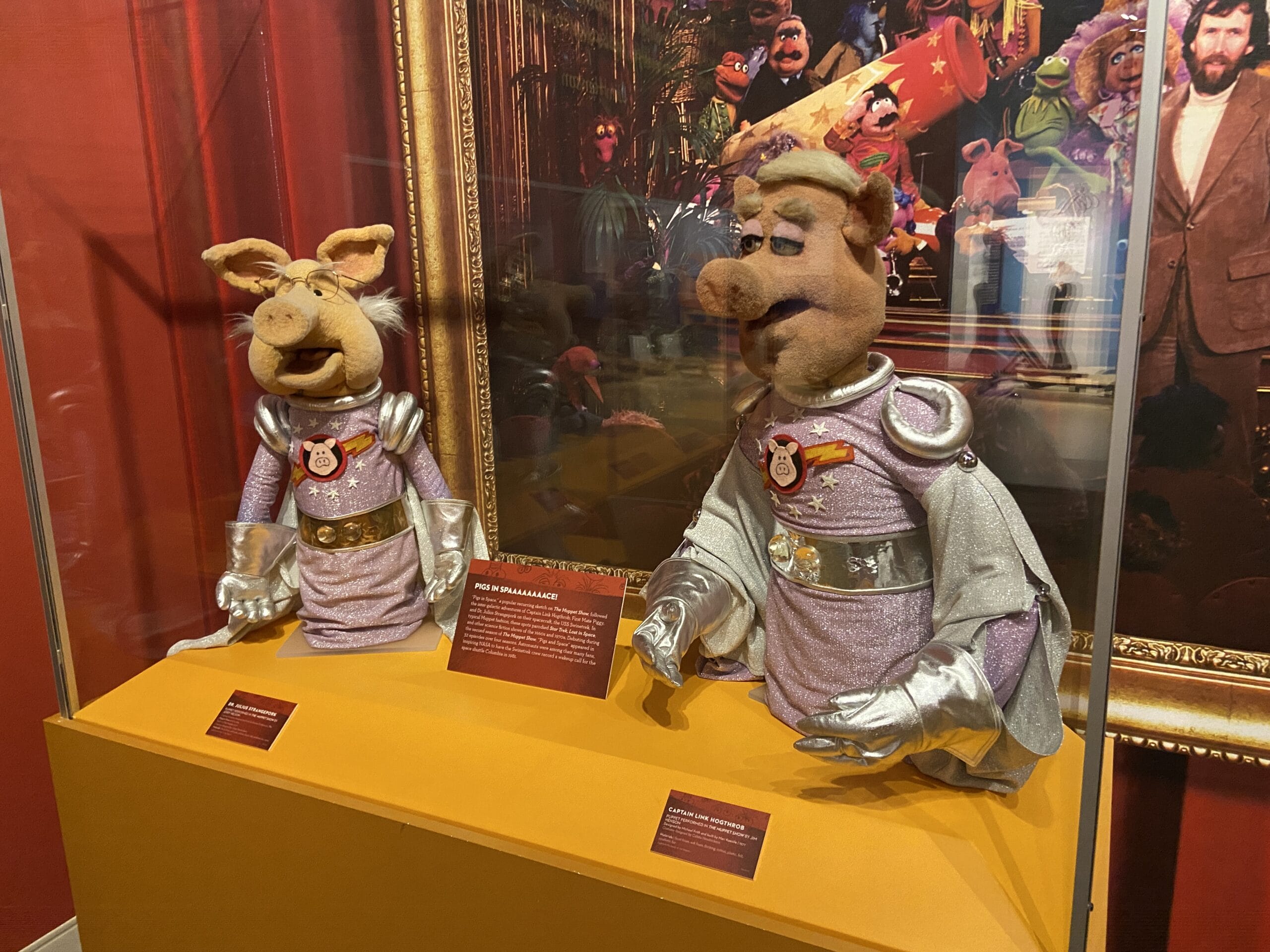
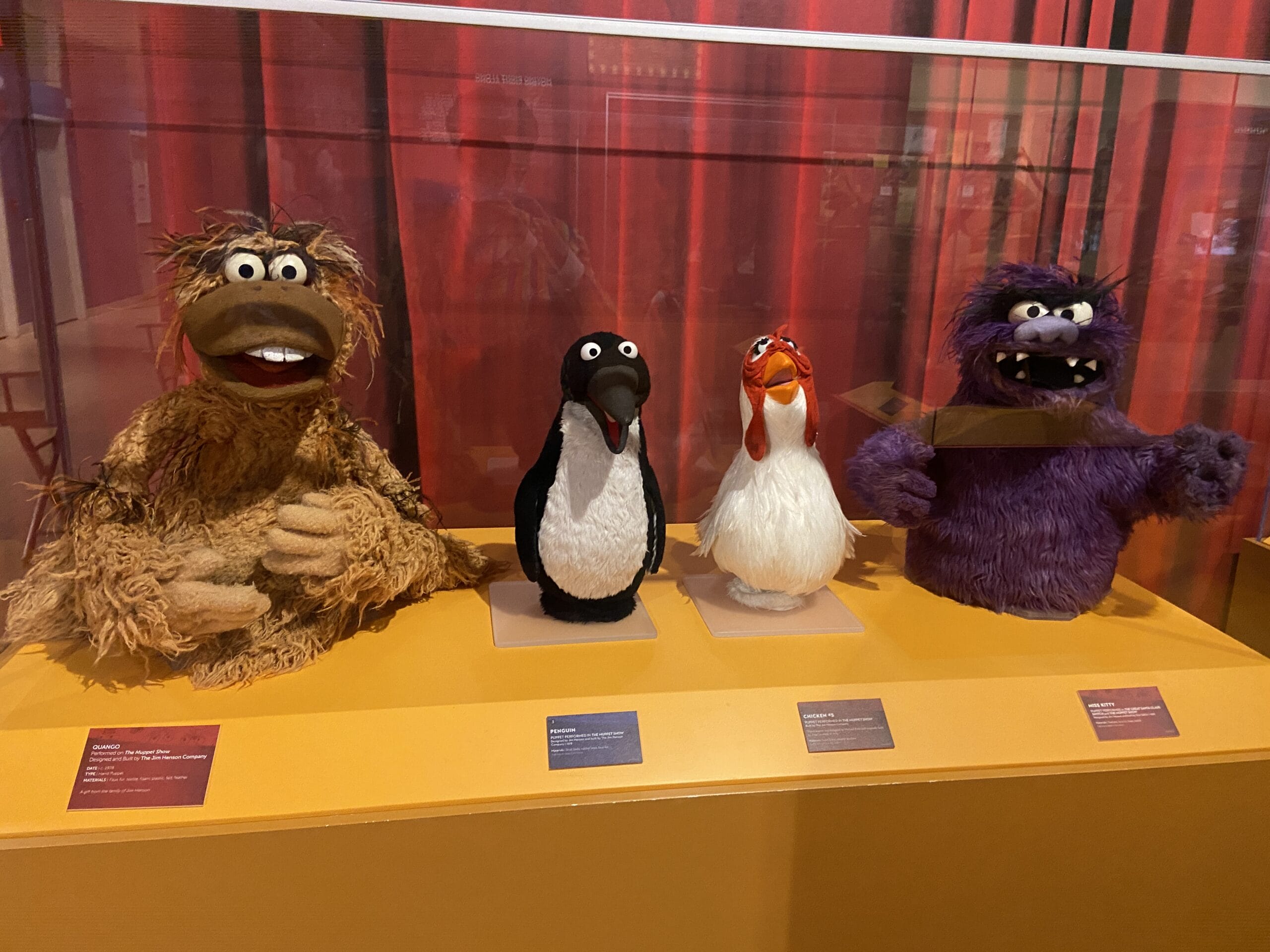
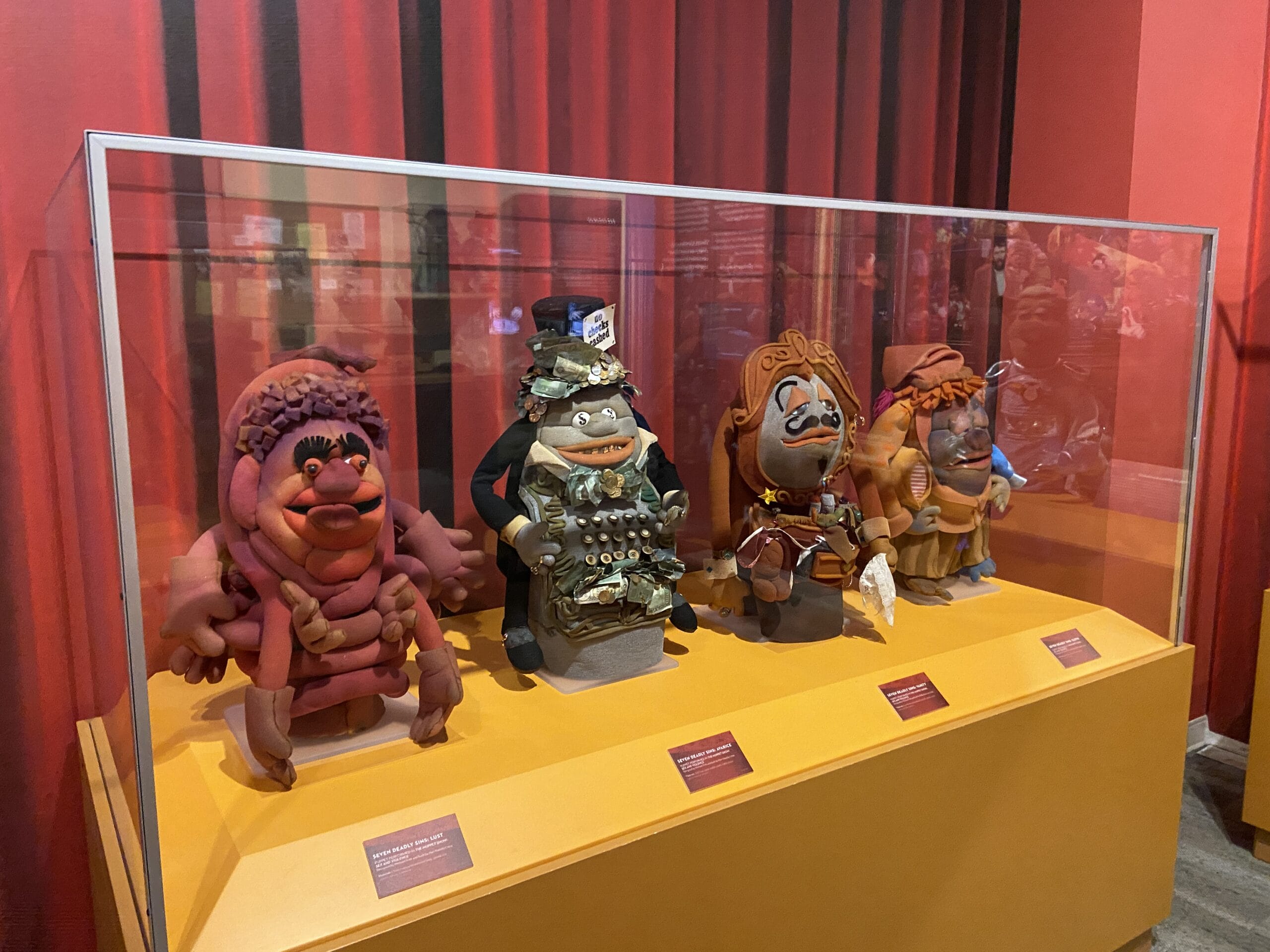
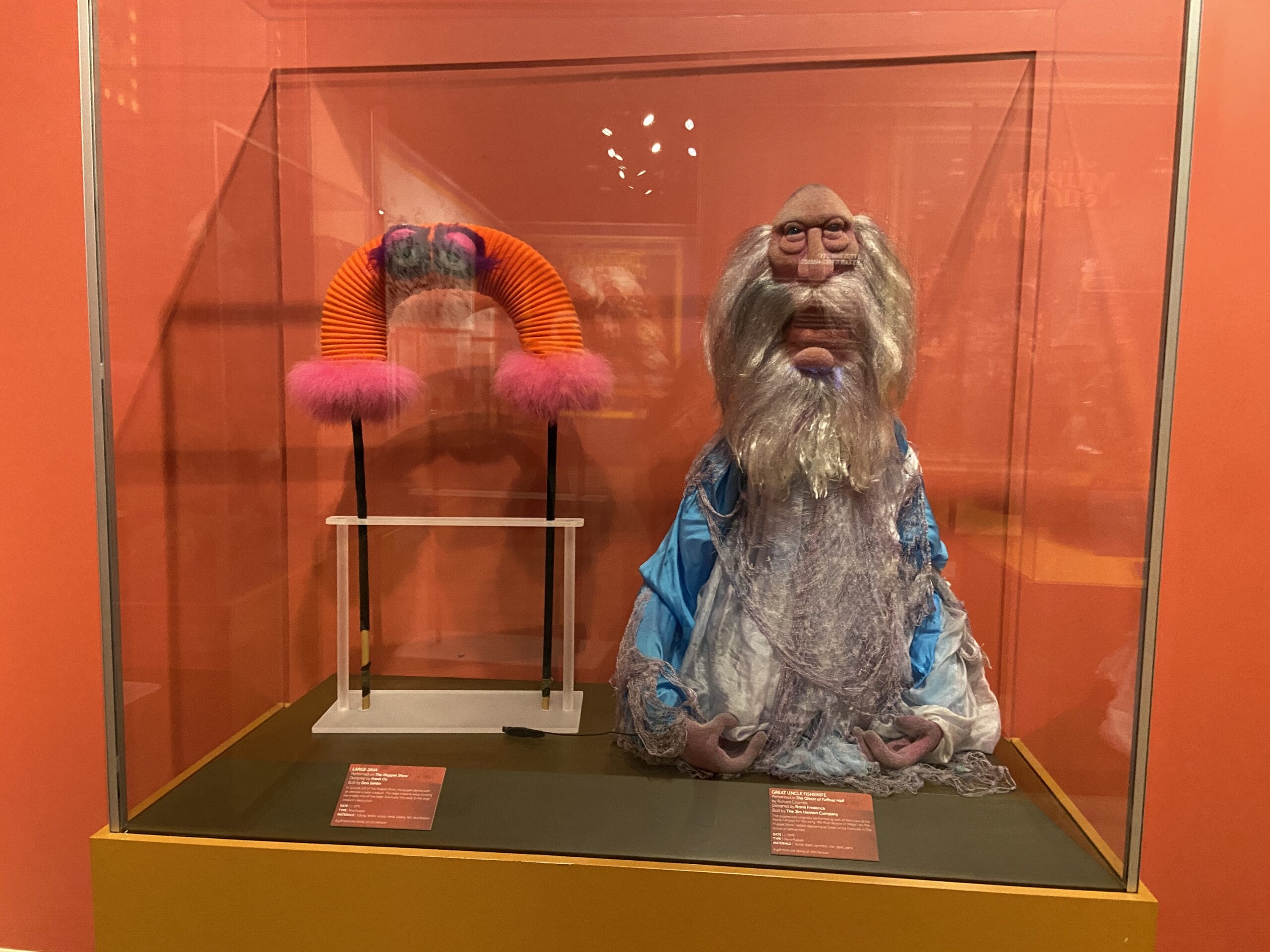
In display cases around Kermit are more famous Muppet characters, including some pigs in space! The Seven Deadly Sins puppets are straight out of The Muppet Show: Sex and Violence, the pilot for The Muppet Show.
Moving on from the Muppets and Sesame Street, this display is dedicated to Emmet Otter’s Jug-Band Christmas. In one case is Emmet Otter’s rowboat, including its controls.
Mayor Fox and Gretchen Fox puppets are on display.
This wall is dedicated to Fraggle Rock, HBO’s first original series. Fraggle Rock ran from 1983 to 1987 but there have been some spin-offs and reboots since. Most recently was Fraggle Rock: Back to the Rock in 2022.
Some of Fraggle Rock‘s tiny Doozers are in a case building a bridge.
Larger puppets in the Fraggle Rock are are Gobo, Wembley, and Mavis the Mirror.
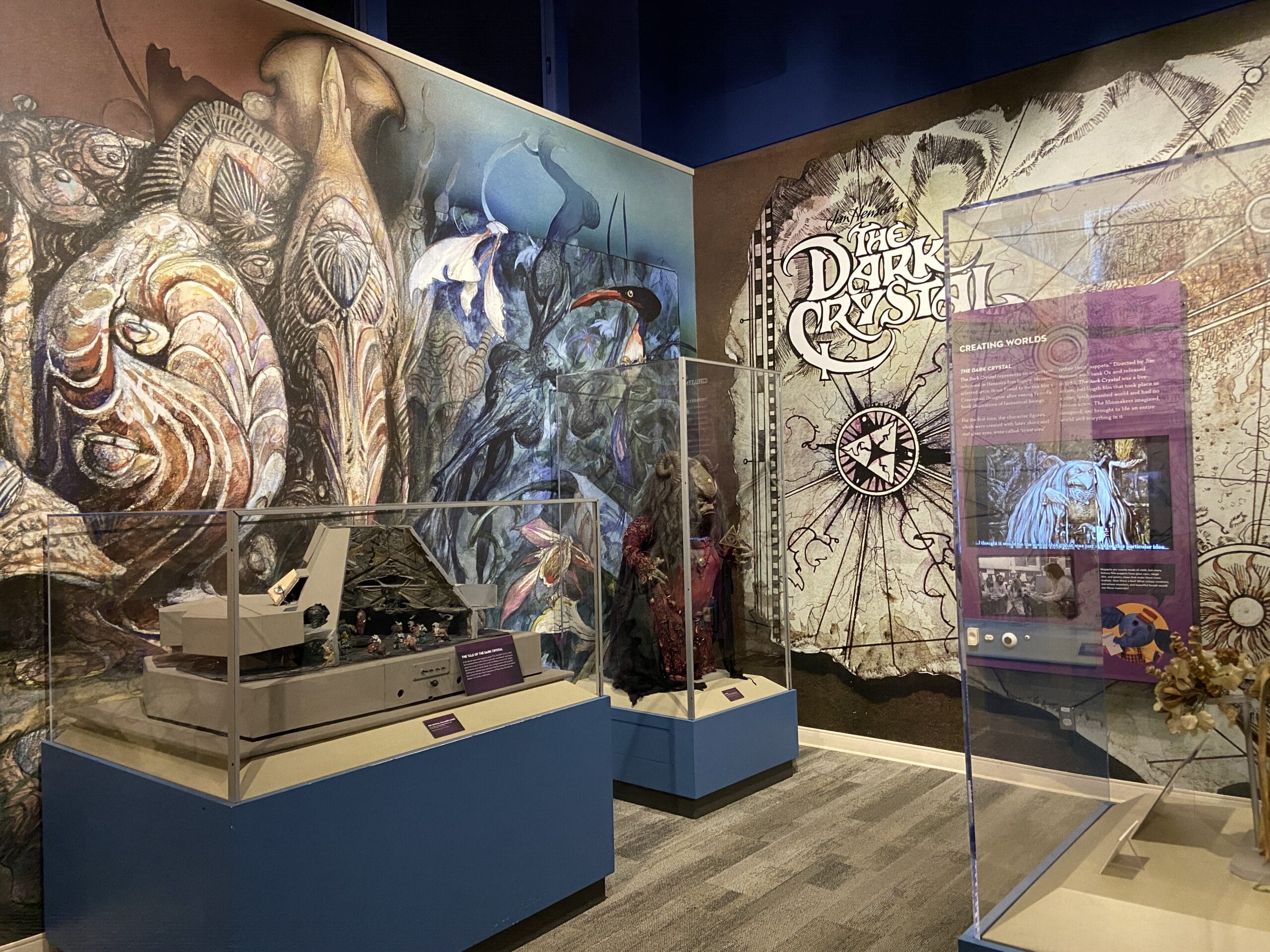
This section is dedicated to the 1982 fantasy film The Dark Crystal and the 1986 Labyrinth. The character figures used in The Dark Crystal, created with latex skins and real glass eyes, were called “creatures” instead of “puppets.” It was directed by Henson and Oz, with Brian Froud as Conceputal Designer.
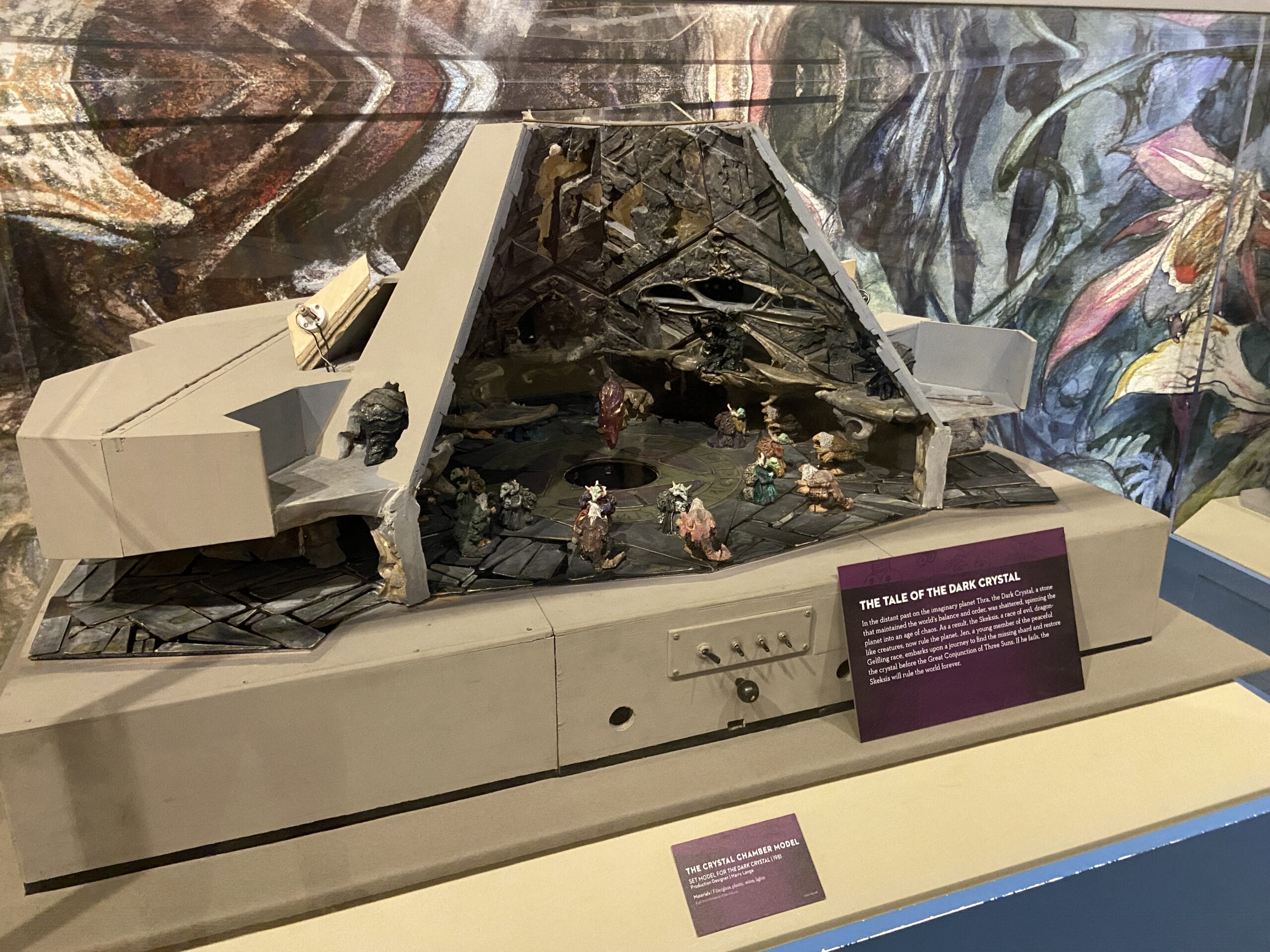
The special items on display include a model of the Crystal Chamber, complete with tiny figures and a tiny crystal.
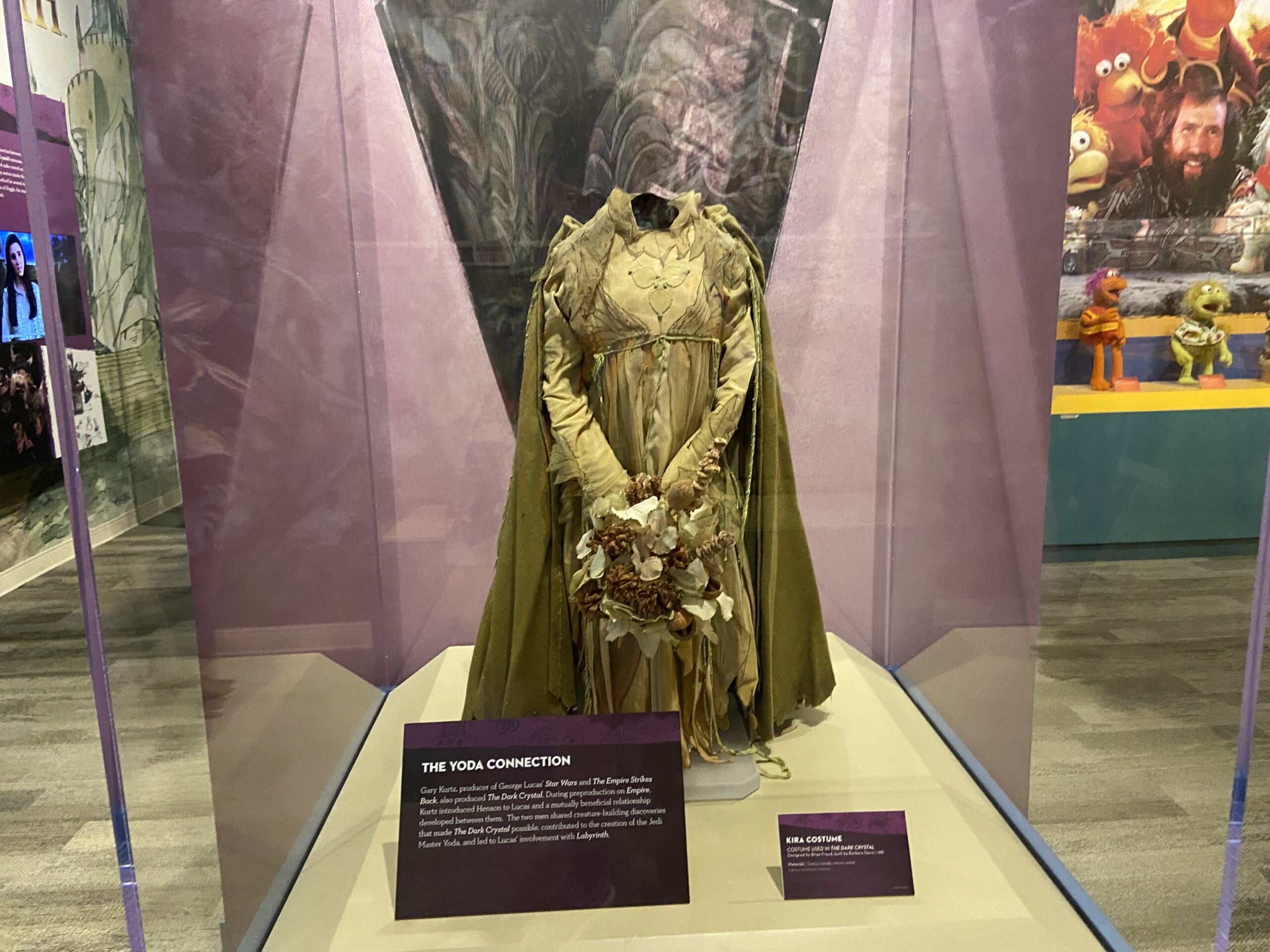
This intricate gown, cape, and bouquet is Kira’s costume. In this case is also a sign explaining how The Dark Crystal led to some other famous films…
The Yoda Connection
Gary Kurtz, producer of George Lucas’ Star Wars and The Empire Strikes Back, also produced The Dark Crystal. During preproduction on Empire, Kurtz introduced Henson to Lucas and a mutually beneficial relationship developed between them. The two men shared creature-building discoveries that made The Dark Crystal possible, contributed to the creation of the Jedi Master Yoda, and led to Lucas’ involvement with Labyrinth.
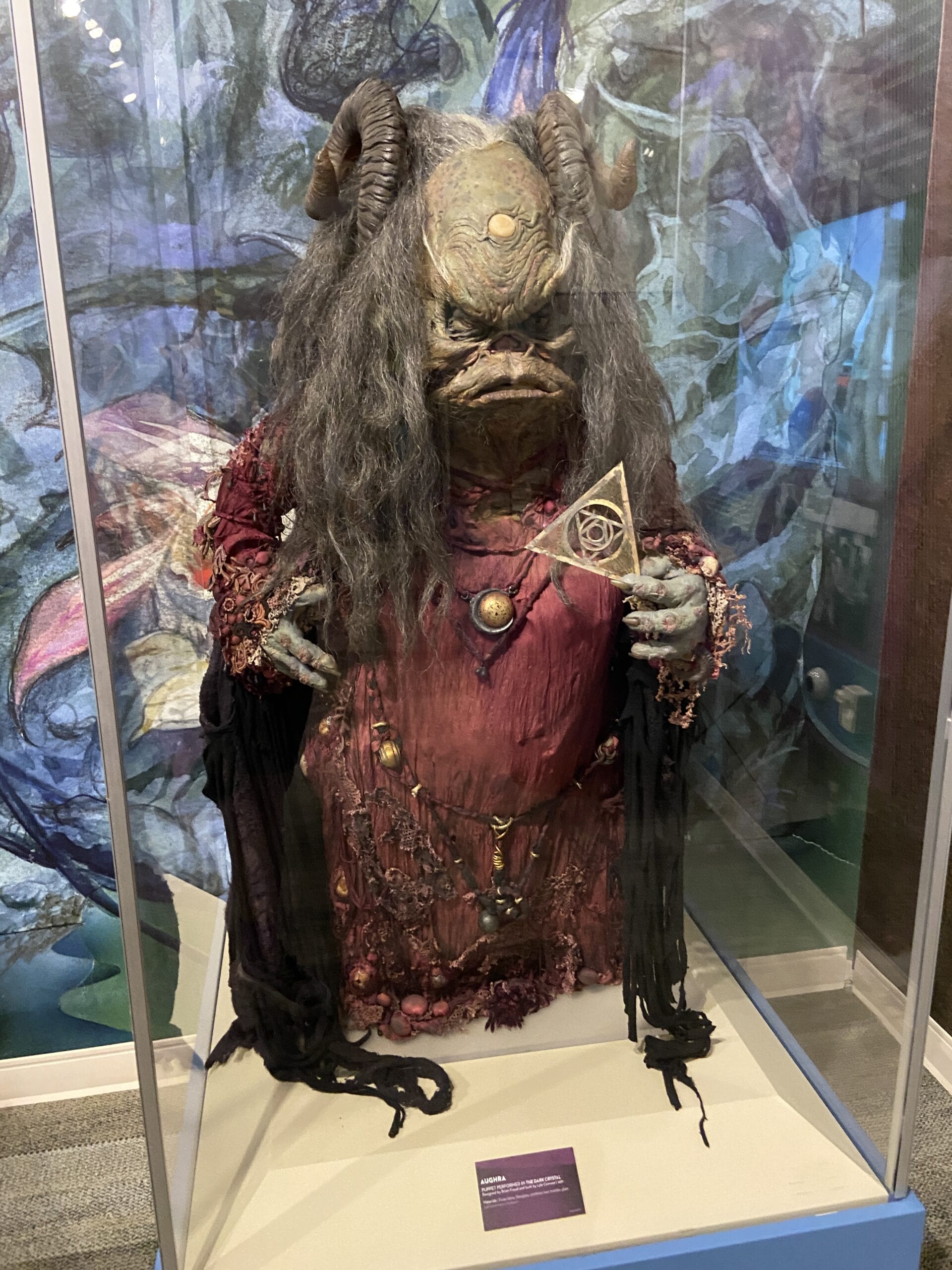
Here is a life-size puppet Aughra. Though these items were mostly designed by Froud, they were built by other artists. In this case, Aughra was constructed by Lyle Conway.
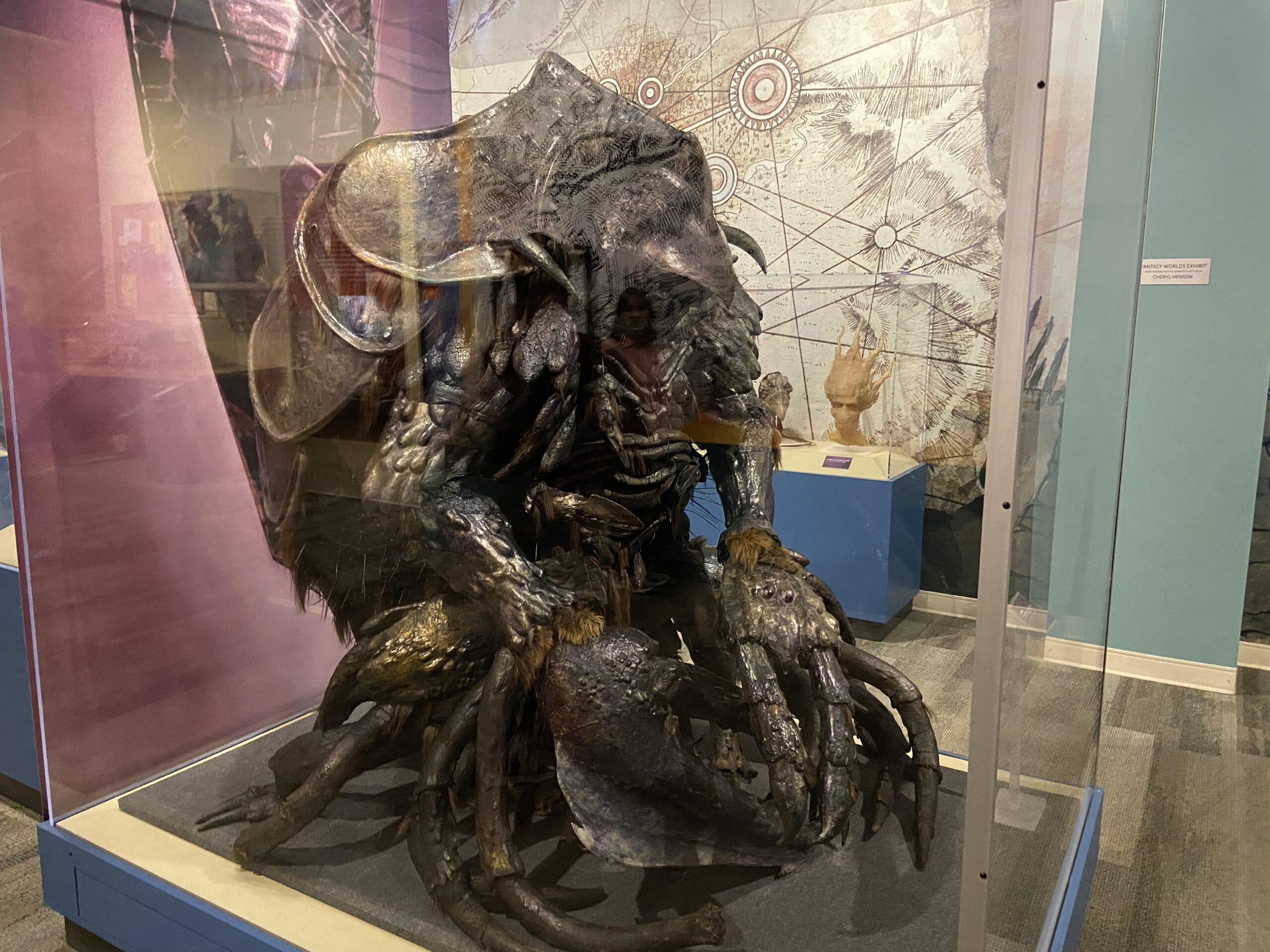
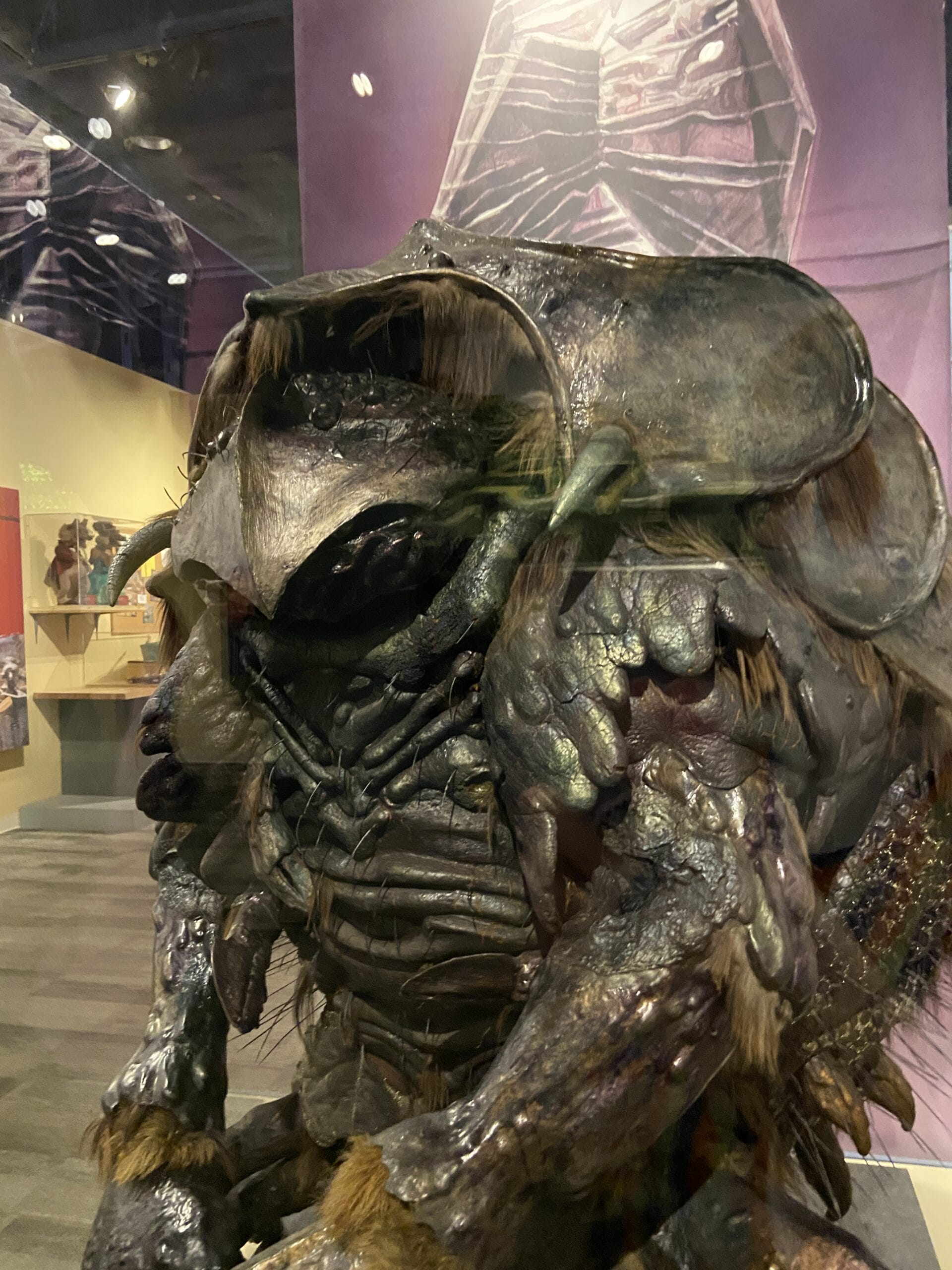
One of the largest items on display in the entire exhibit is the Garthim. This creature was built by Fred Nihda out of fiberglass, plastic, foam latex, hair, and metal.
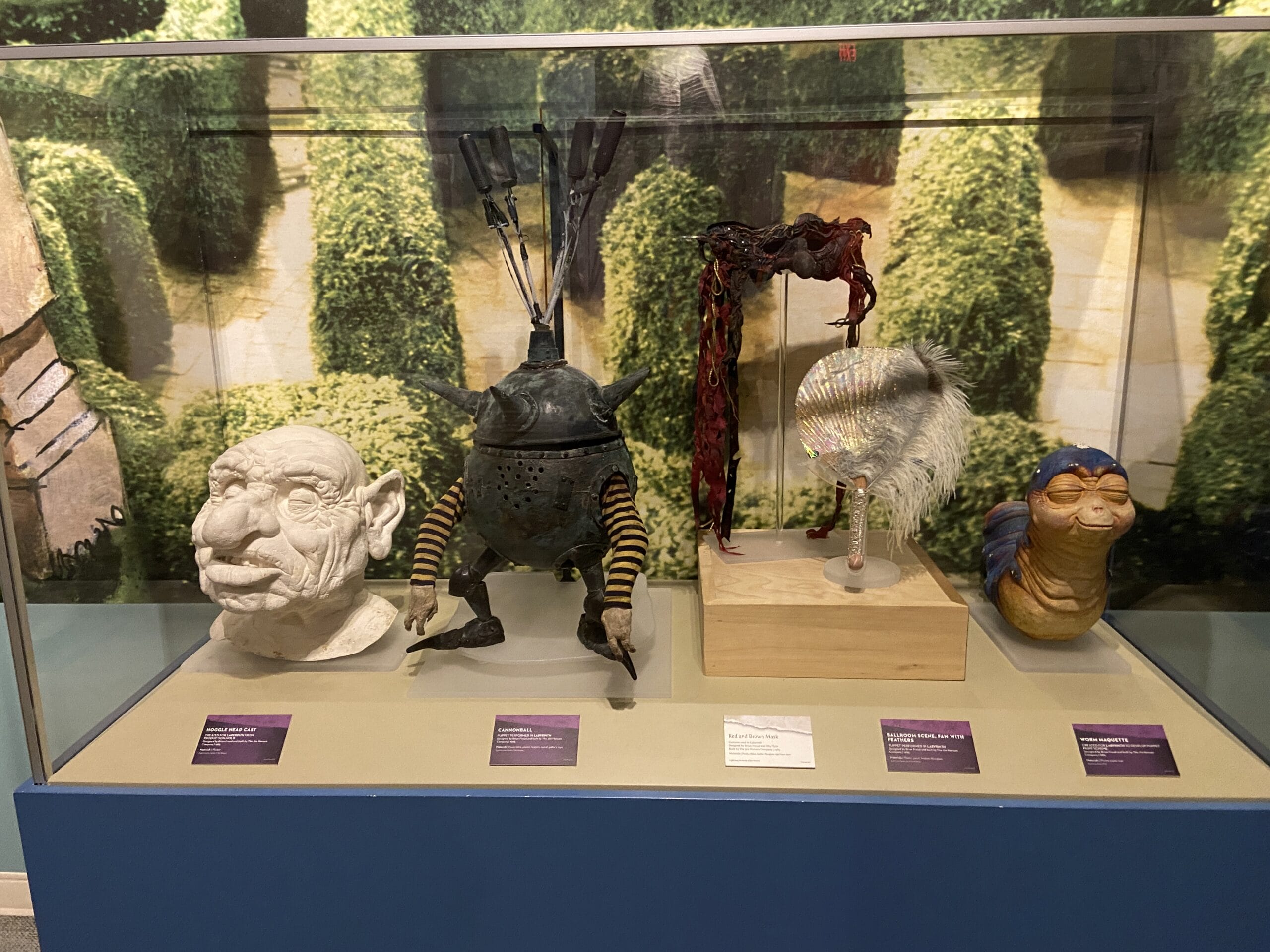
Because Labyrinth required extensive interaction between human actors and puppets, Henson and co. couldn’t use the same cable systems as they did on the The Dark Crystal. Instead, they used radio control. This helped them create minute facial features on the character of Hoggle.
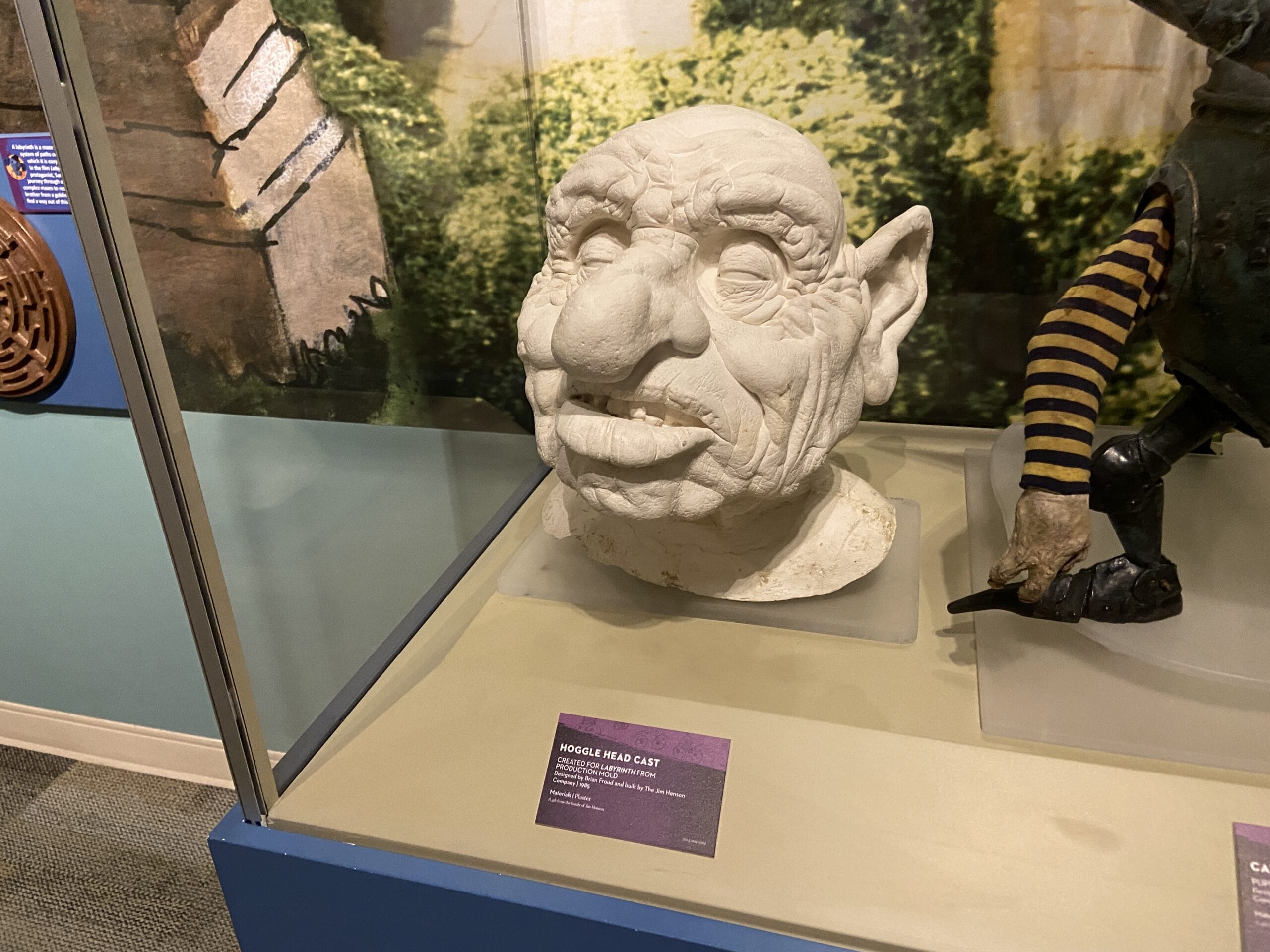
A plaster head cast of Hoggle is on display. Famously, the actual Hoggle puppet was lost in transit after filming was complete. The lost luggage was ultimately found, however, and Hoggle was restored. He’s on display at the Unclaimed Baggage Centre in Alabama.
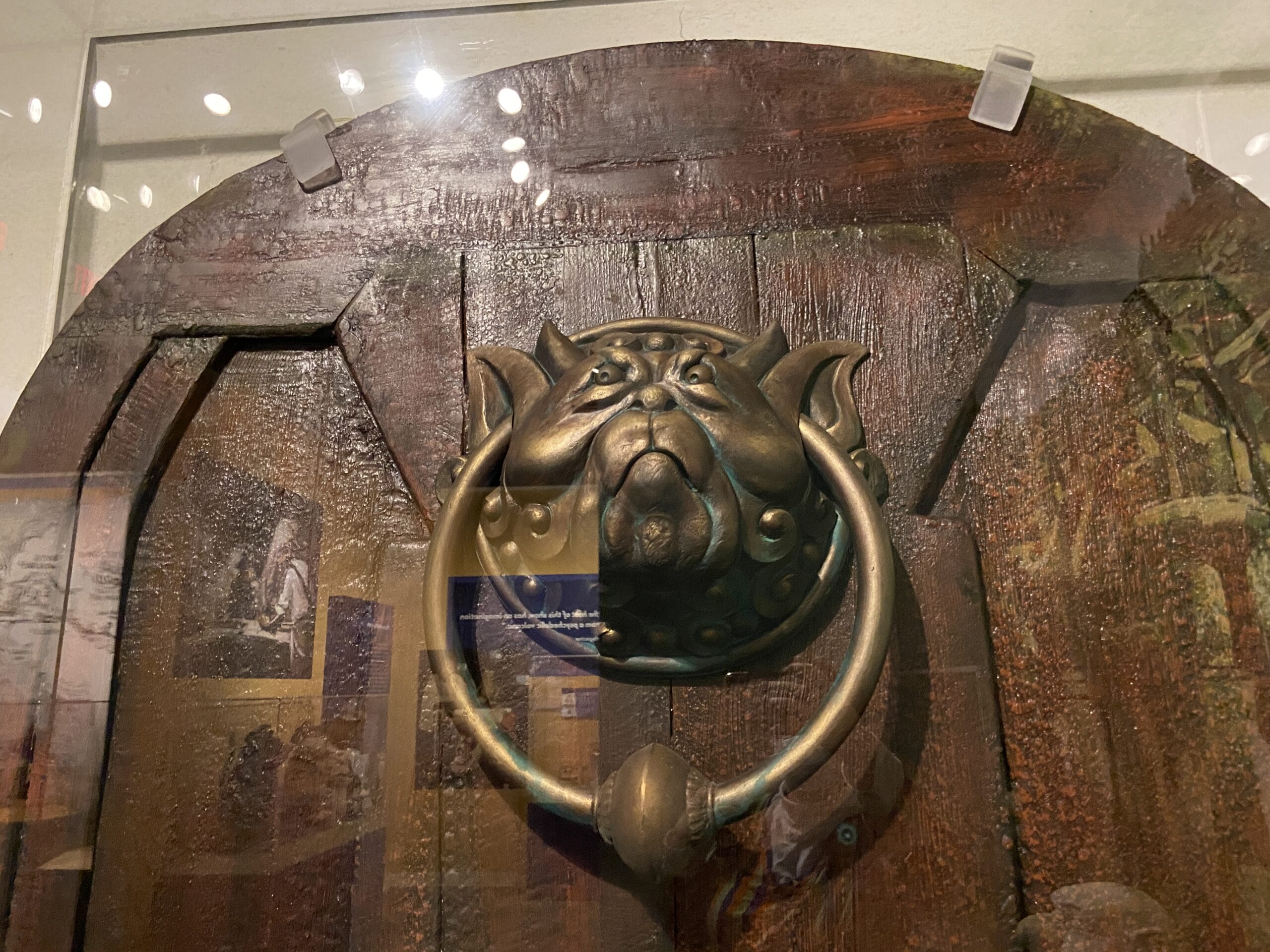
Here you’ll also find the Talking Door Knocker, which was performed by famous Muppet puppeteer Dave Goelz.
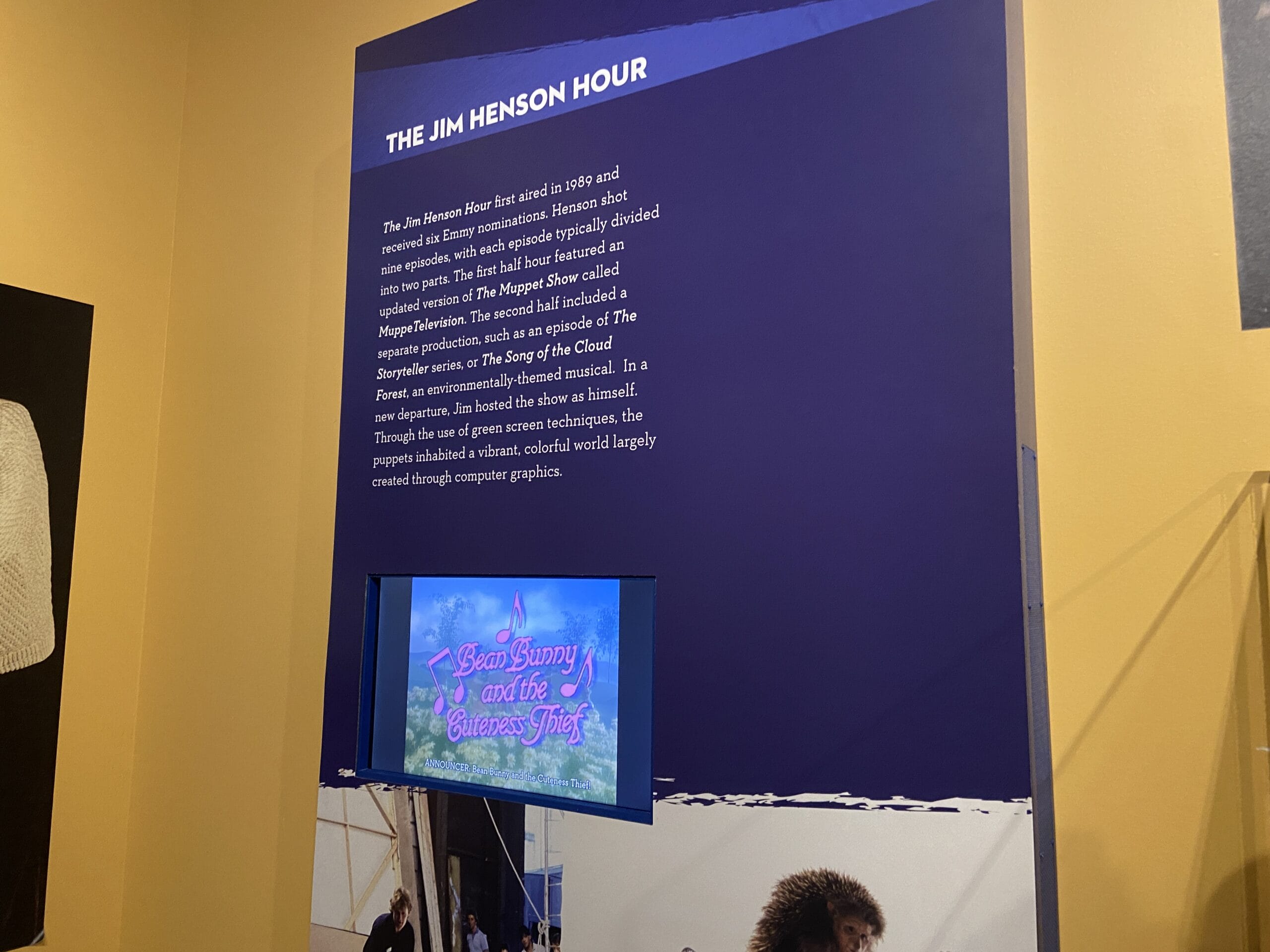
A TV in the final section plays clips from The Jim Henson Hour, which first aired in 1989. The show was nine episodes, each divided into two parts. The first half hour featured MuppeTelevision and the second half featured a separate production, such as an episode of The Storyteller series.
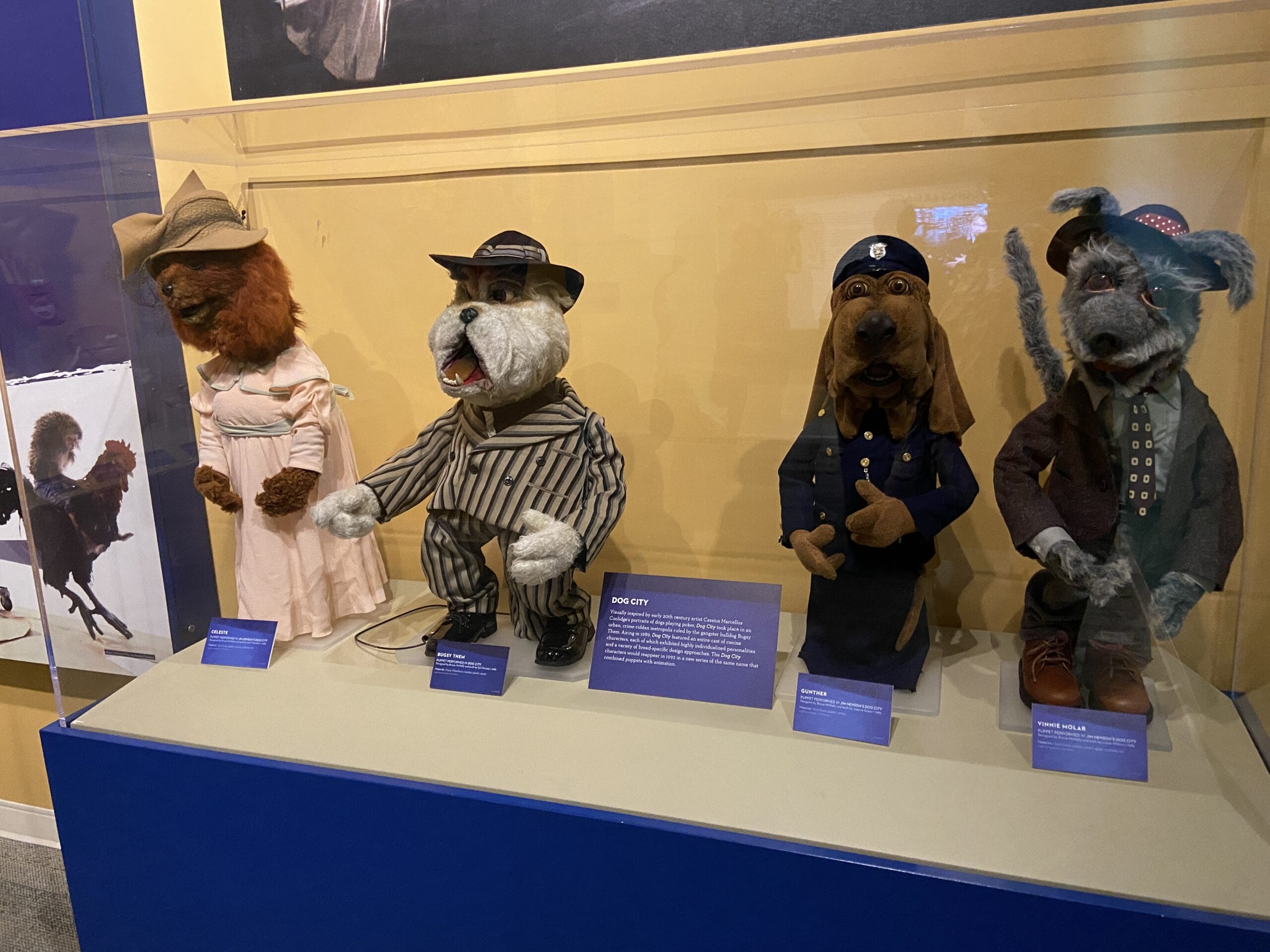
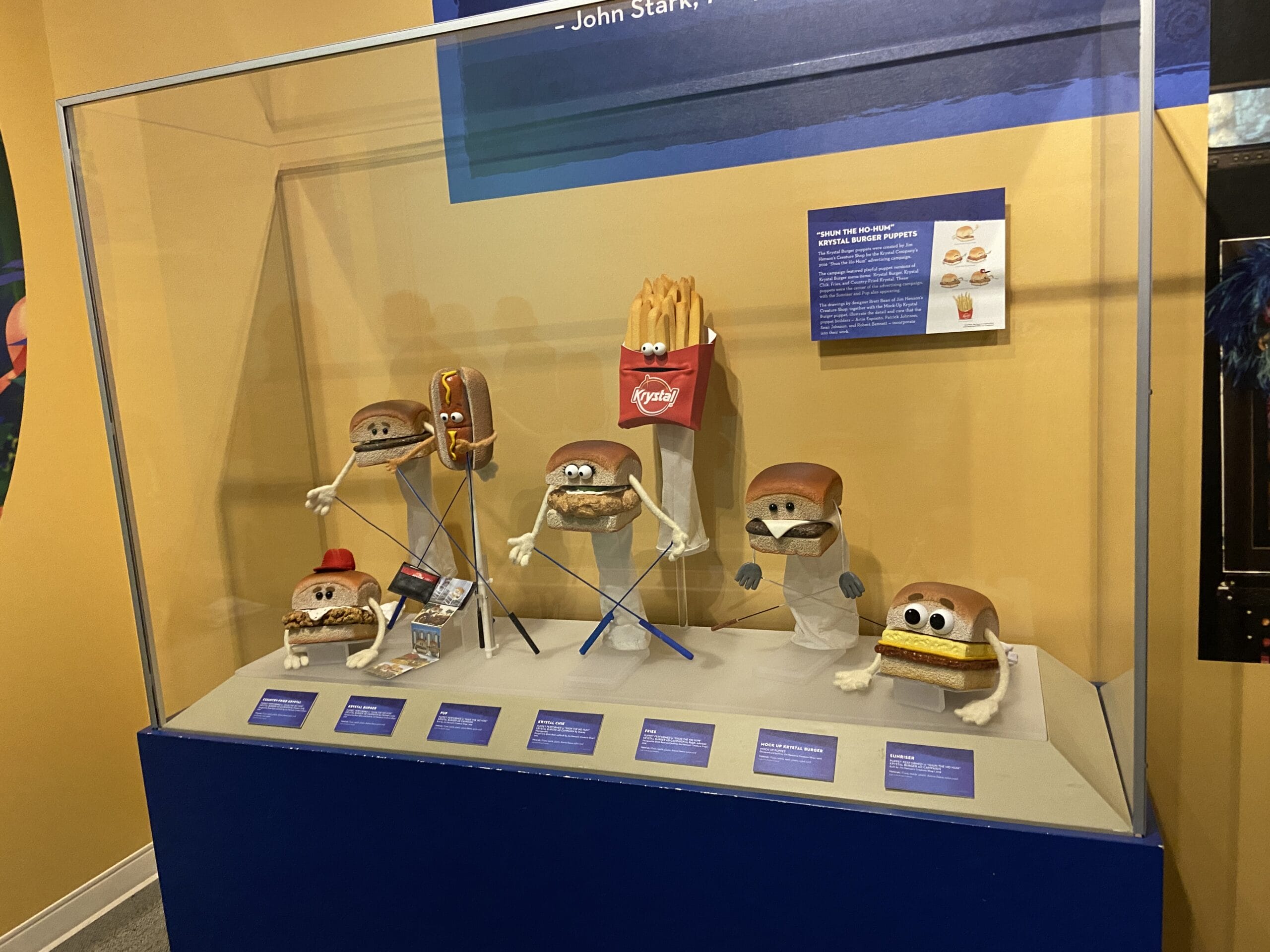
Other puppets on display in this area are from Dog City and Krystal Burger commercials.
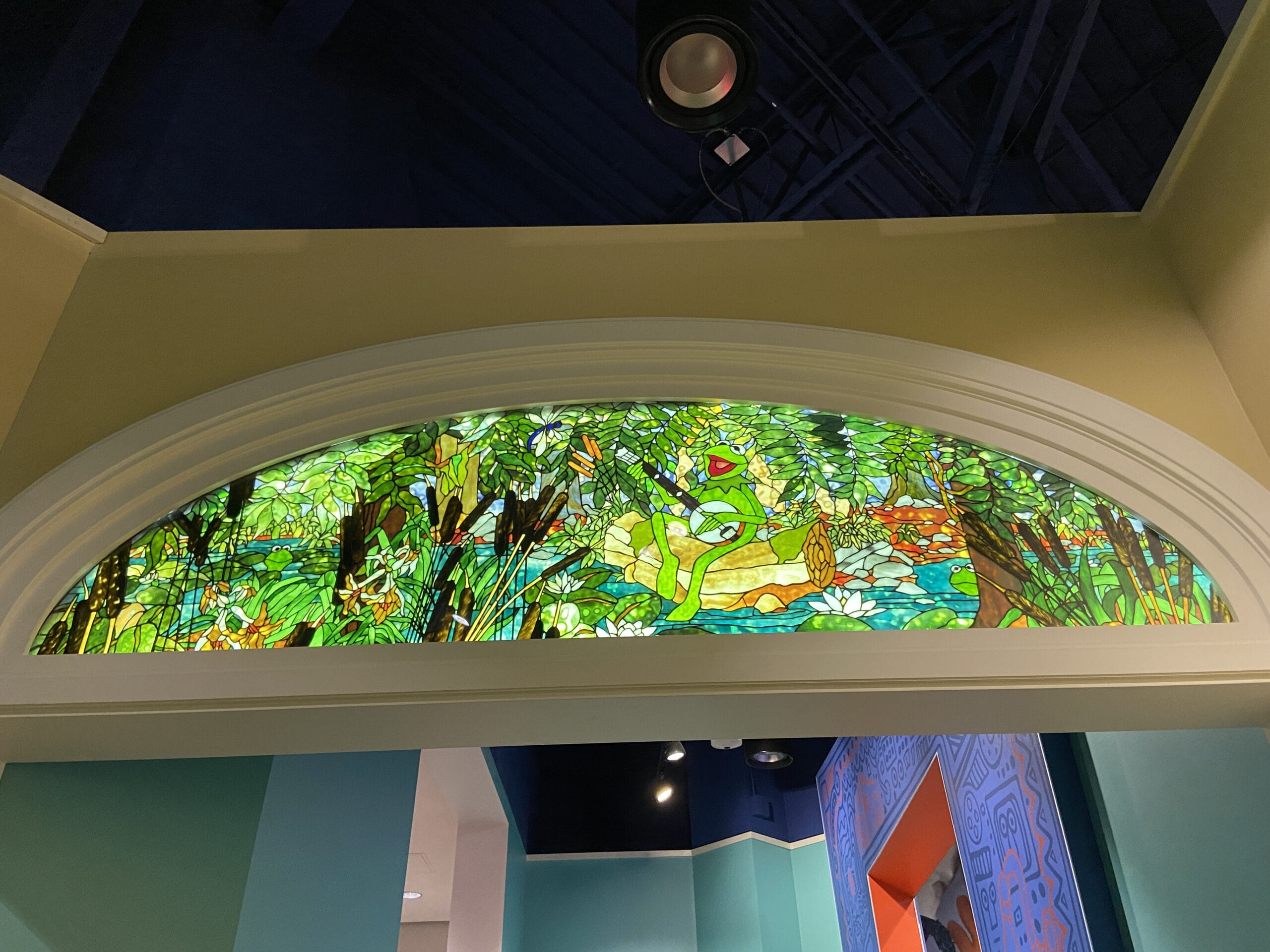
A final special item above the exit is a stained glass window of Kermit. This was created in 1980 for the entryway of the NYC Muppet Mansion and served as the 1980 Henson Company Christmas Card. In the mansion, it was accompanied by a skylight featuring Kermit’s view of the sky.
Affectionate Anarchy: Creating with Jim Henson
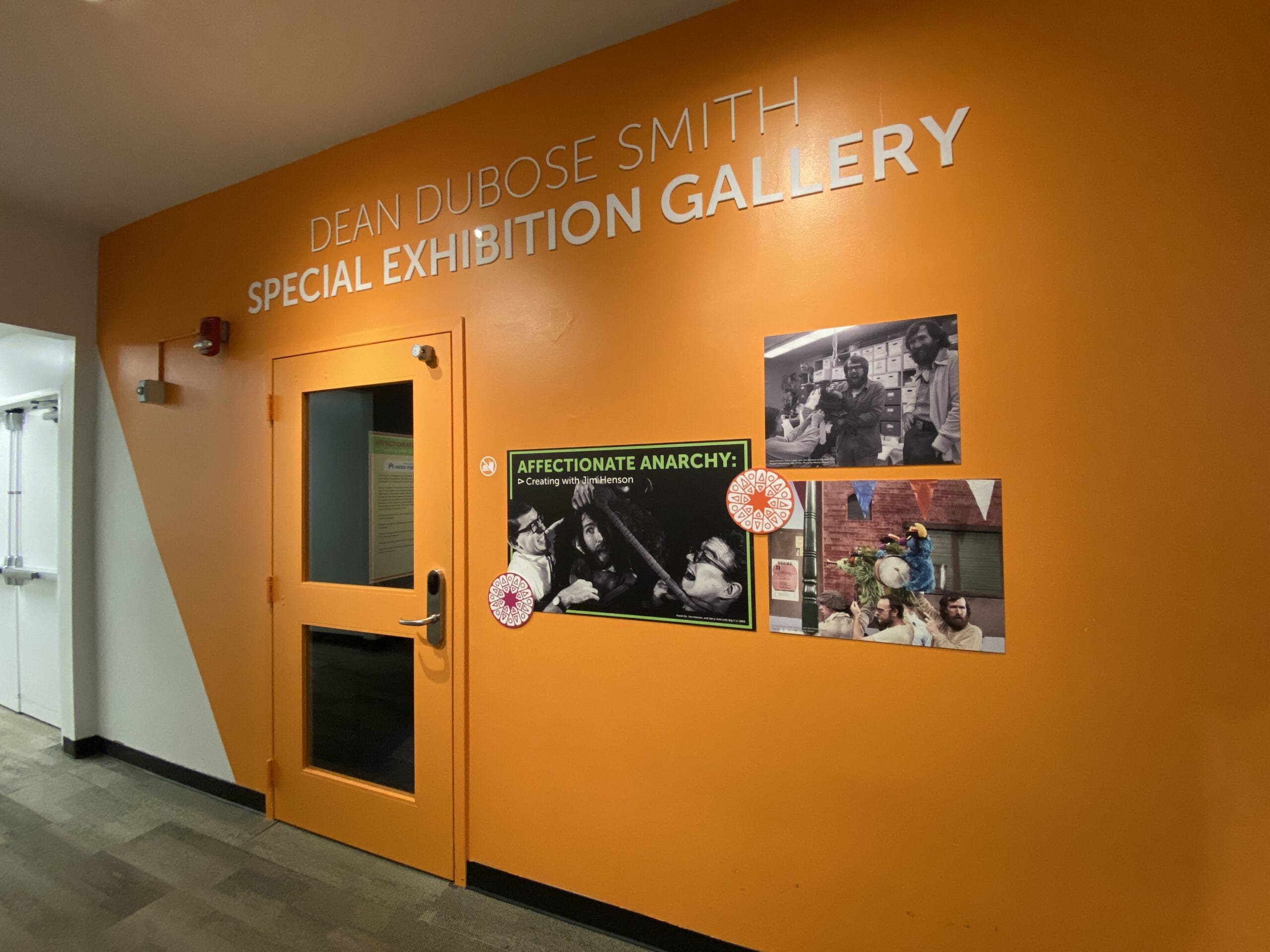
This exhibition celebrates those who collaborated with Jim Henson during the first 25 years of The Jim Henson Company including Frank Oz, Bonnie Erickson, Jerry Juhl, Don Sahlin, Caroll Spinney, and more. It’s located in the Dean Dubose Smith Special Exhibition Gallery.
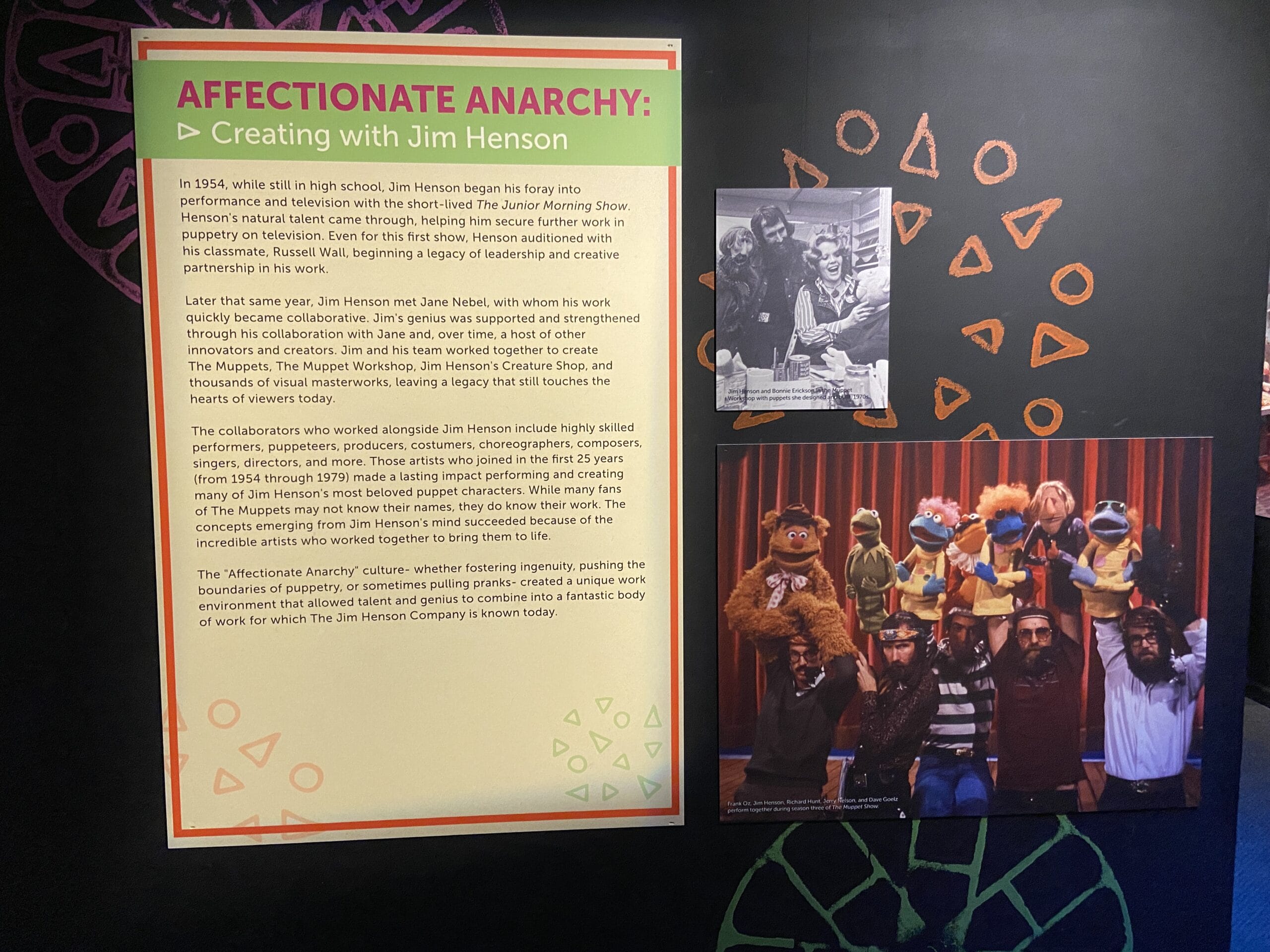
Affectionate Anarchy:
Creating with Jim HensonIn 1954, while still in high school, Jim Henson began his foray into performance and television with the short-lived The Junior Morning Show. Henson’s natural talent came through, helping him secure further work in puppetry on television. Even for this first show, Henson auditioned with his classmate, Russell Wall, beginning a legacy of leadership and creative partnership in his work.
Later that same year, Jim Henson met Jane Nebel, with whom his work quickly became collaborative. Jim’s genius was supported and strengthened through his collaboration with Jane and, over time, a host of other innovators and creators. Jim and his team worked together to create The Muppets, The Muppet Workshop, Jim Henson’s Creature Shop, and thousands of visual masterworks, leaving a legacy that still touches the hearts of viewers today.
The collaborators who worked alongside Jim Henson include highly skilled performers, puppeteers, producers, costumers, choreographers, composers, singers, directors, and more. Those artists who joined in the first 25 years (from 1954 through 1979) made a lasting impact performing and creating many of Jim Henson’s most beloved puppet characters. While many fans of The Muppets may not know their names, they do know their work. The concepts emerging from Jim Henson’s mind succeeded because of the incredible artists who worked together to bring them to life.
This “Affectionate Anarchy” culture – whether fostering ingenuity, pushing the boundaries of puppetry, or sometimes pulling pranks – created a unique work environment that allowed talent and genius to combine into a fantastic body of work for which The Jim Henson Company is known today.
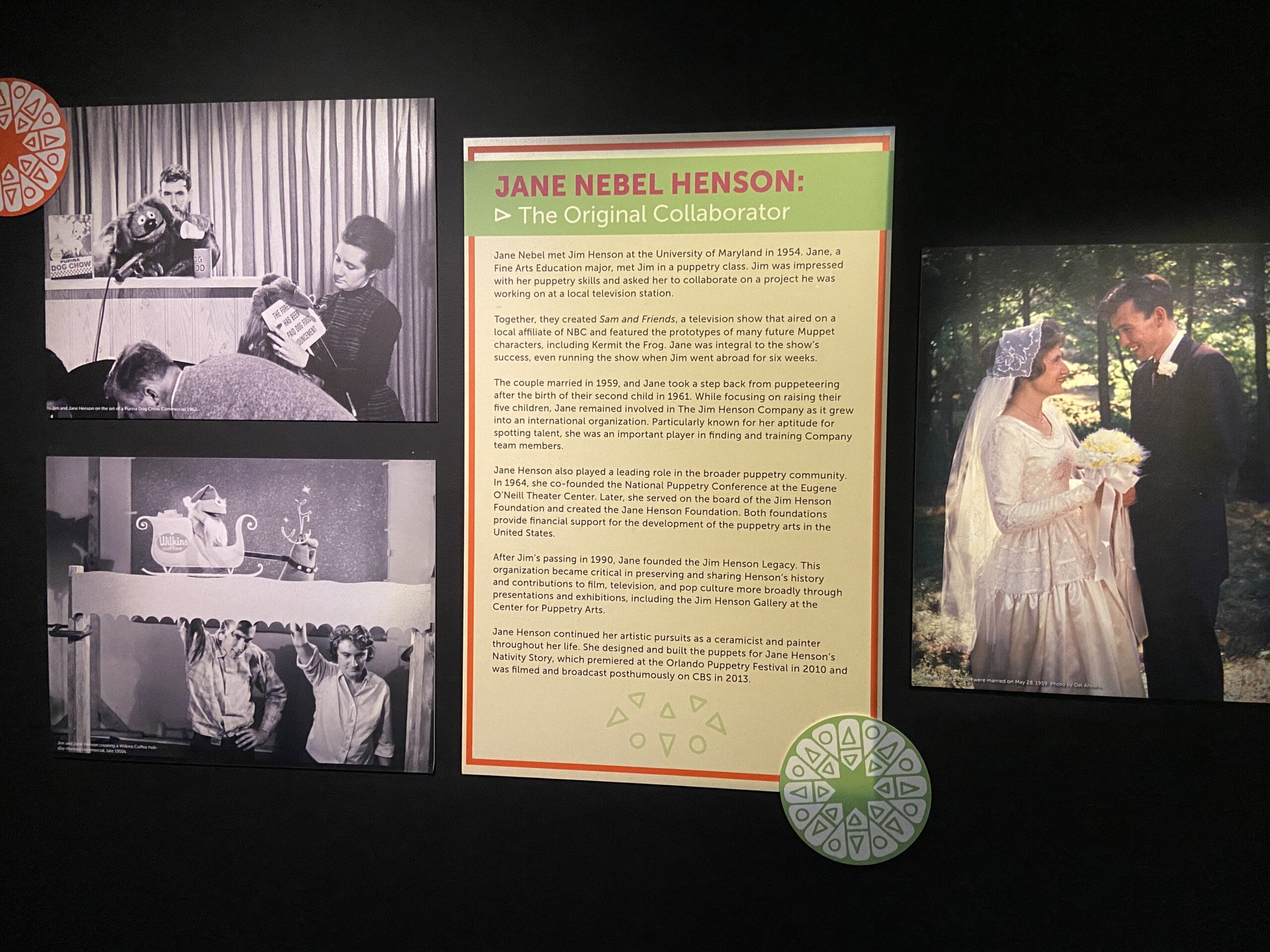
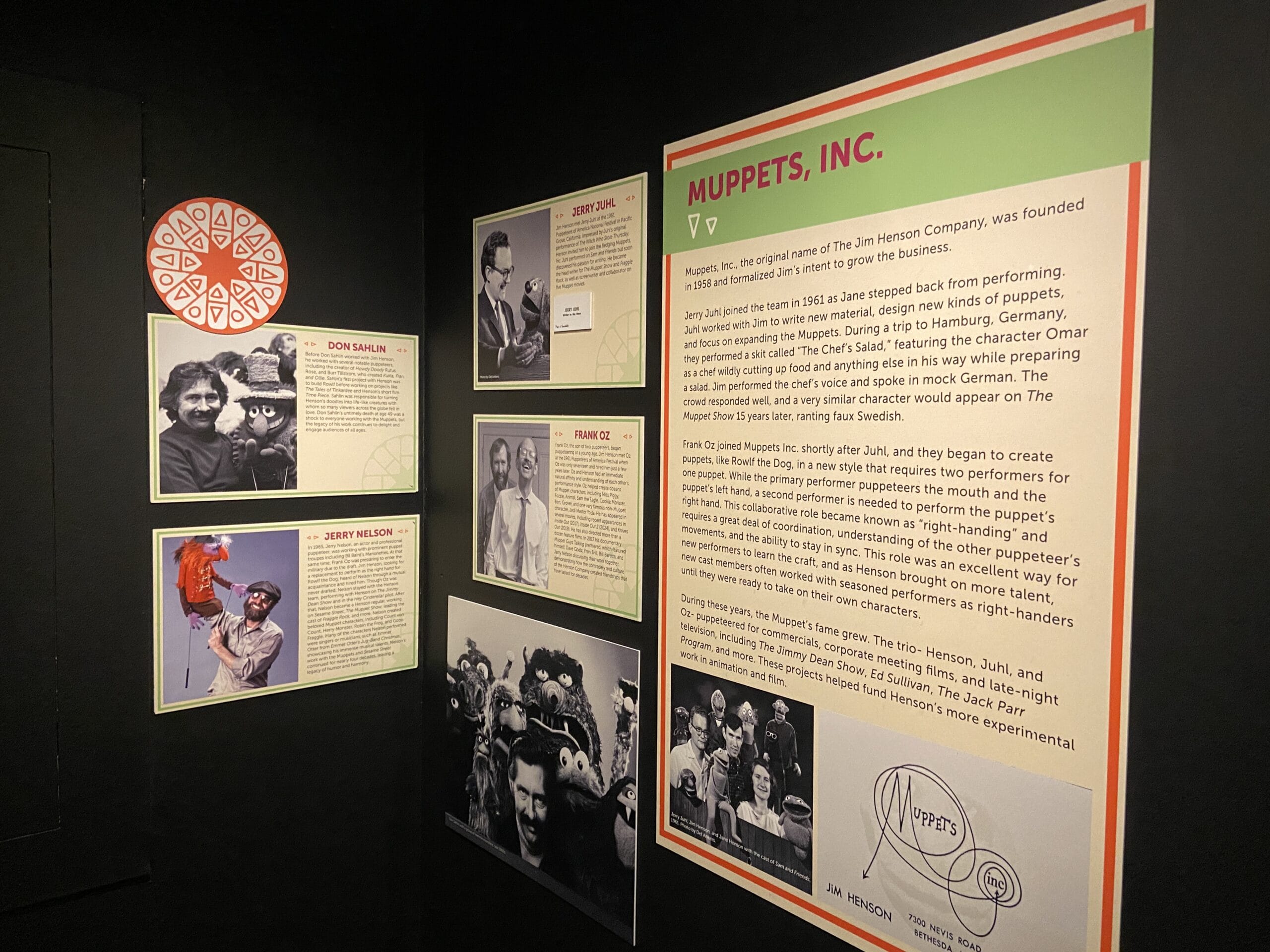
The walls are decorated with photos of Henson and his collaborators from over the years, alongside biographies of each person and descriptions of the assets on display. Highlighted performers in the first area include Jane Nebel Henson, Jerry Juhl, Frank Oz, Don Sahlin, and Jerry Nelson.
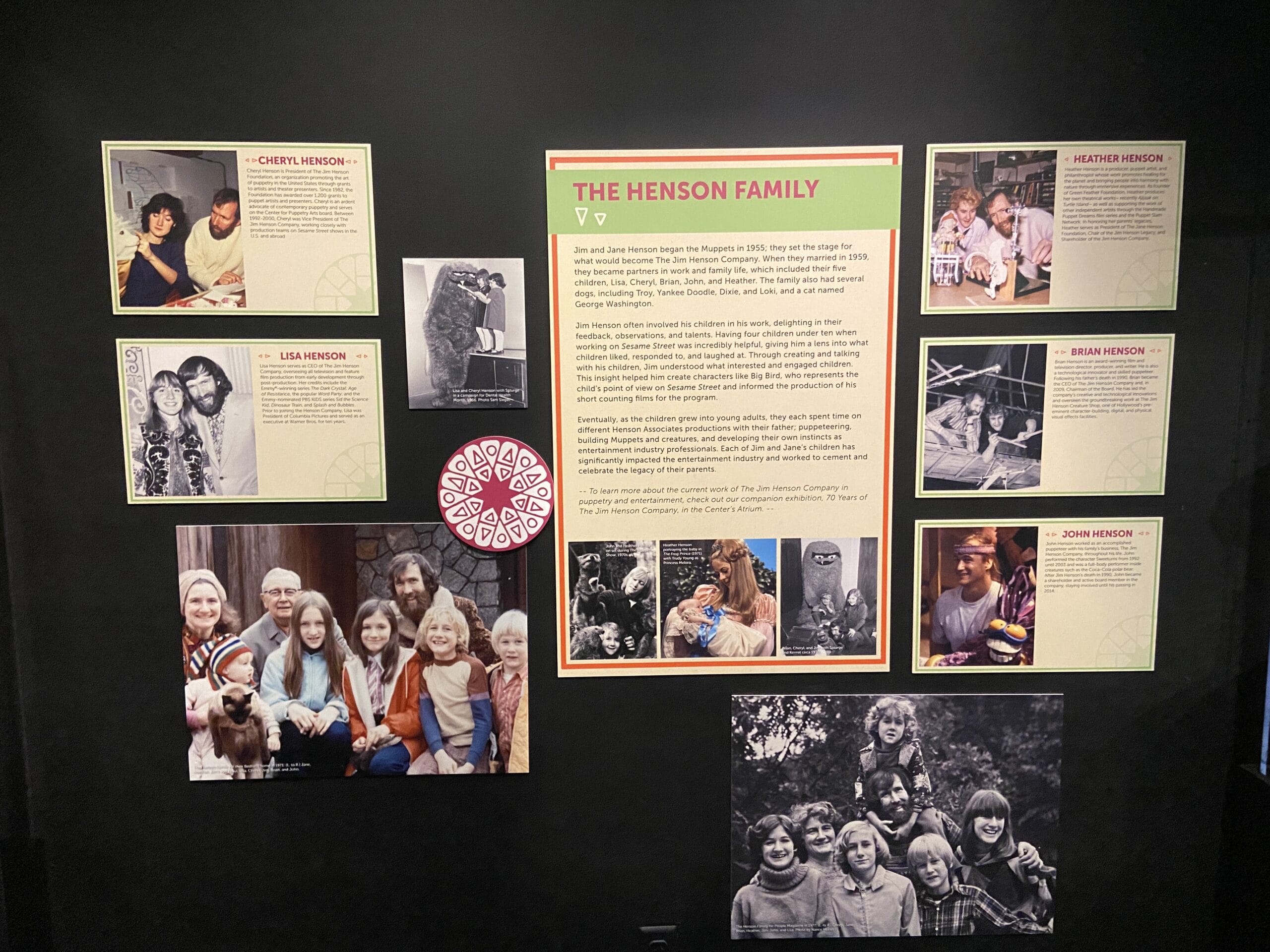
Beyond Jane, Jim’s wife, there is also information about his children who became involved in his work: Cheryl, Lisa, Heather, Brian, and John.
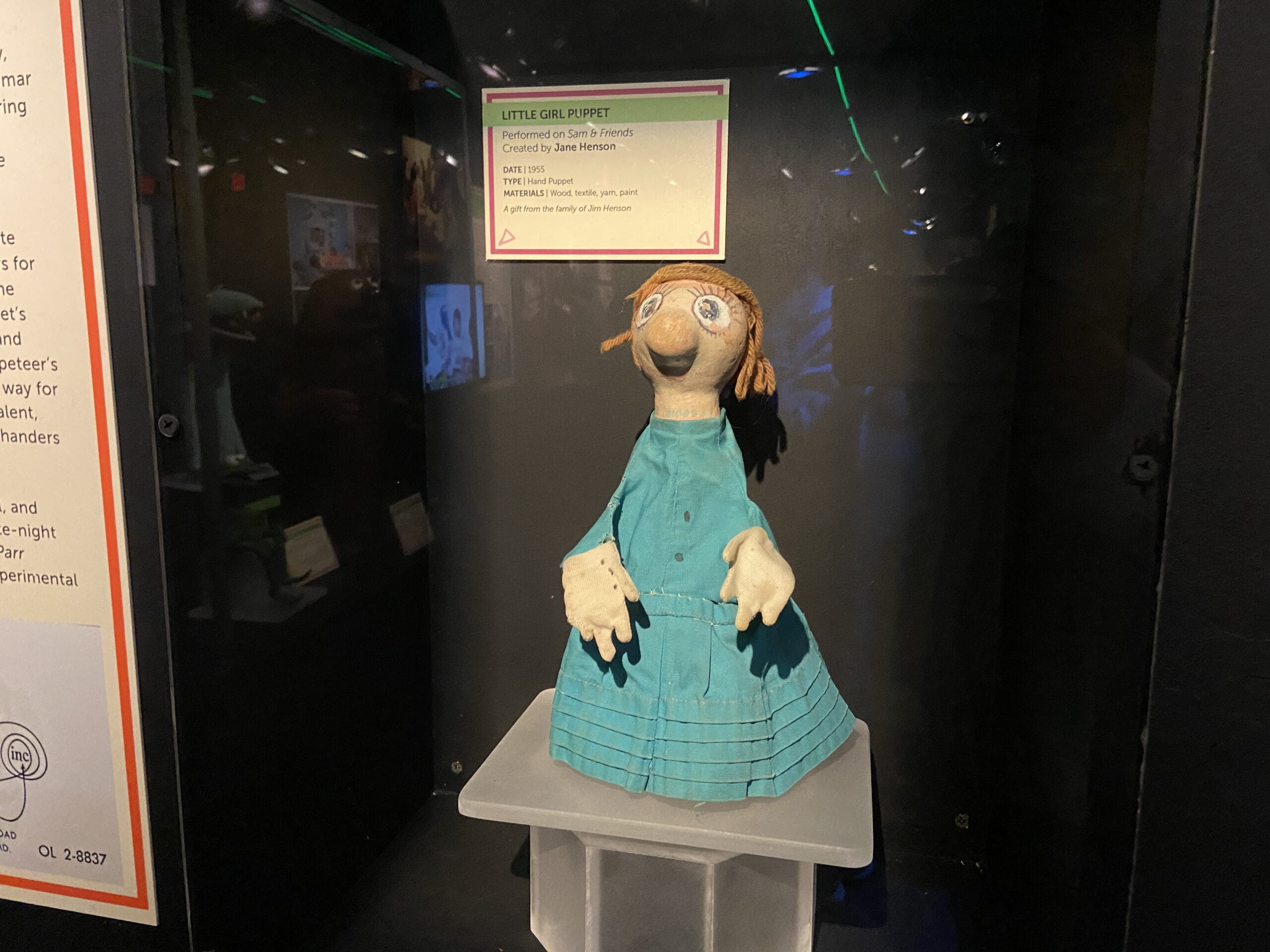
A piece by Jane Henson on display is this little girl puppet. Jane created her in 1955 for Sam & Friends.
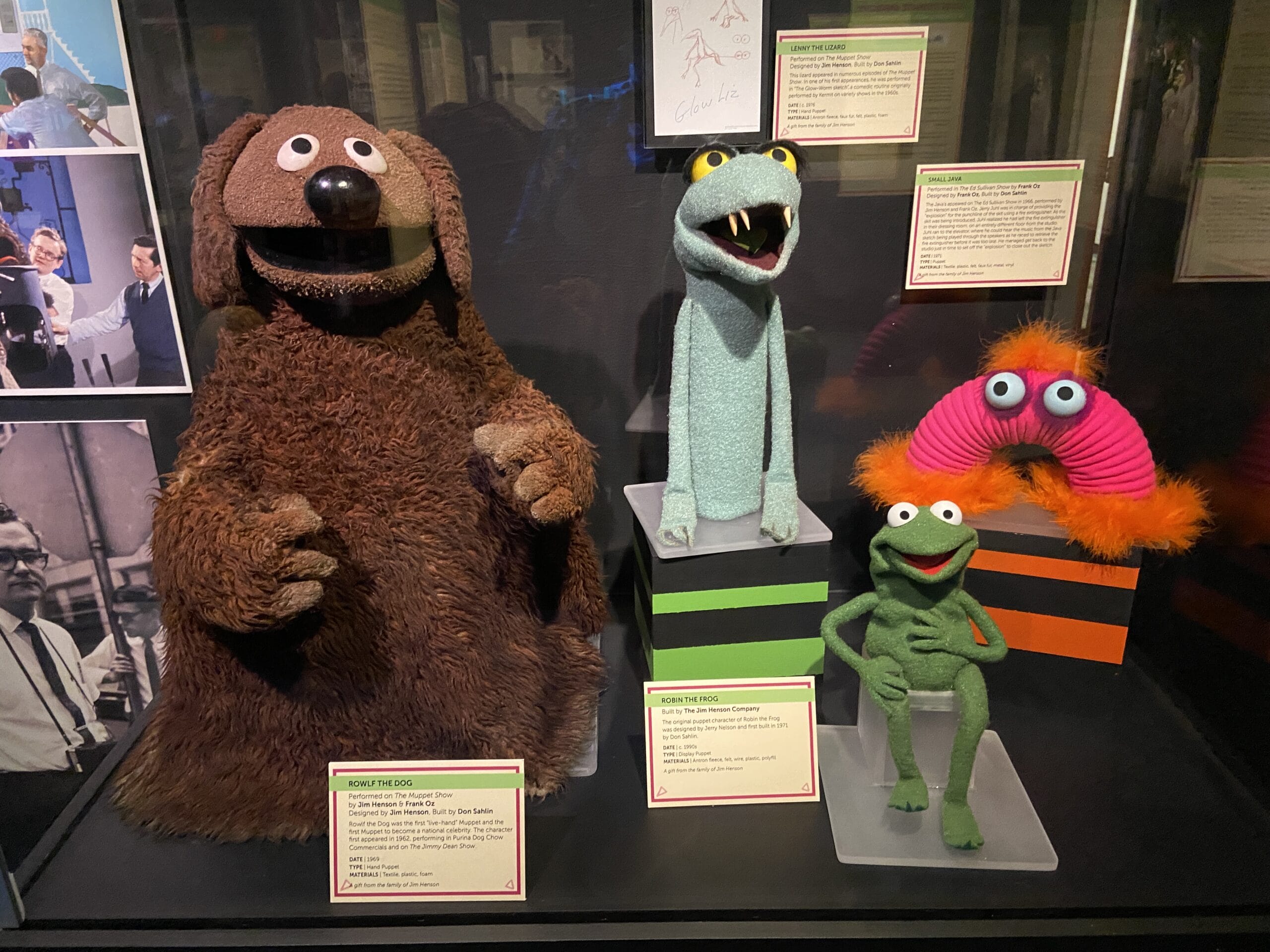
Muppet fans will undoubtedly recognize Rowlf the Dog and Robin the Frog. This Rowlf puppet was crafted by Don Sahlin in 1969. This version of Robin was constructed in the 1990s. They are accompanied by Lenny the Lizard and Small Java, also built by Sahlin. Lenny was designed by Henson and Small java was designed and performed by Frank Oz.
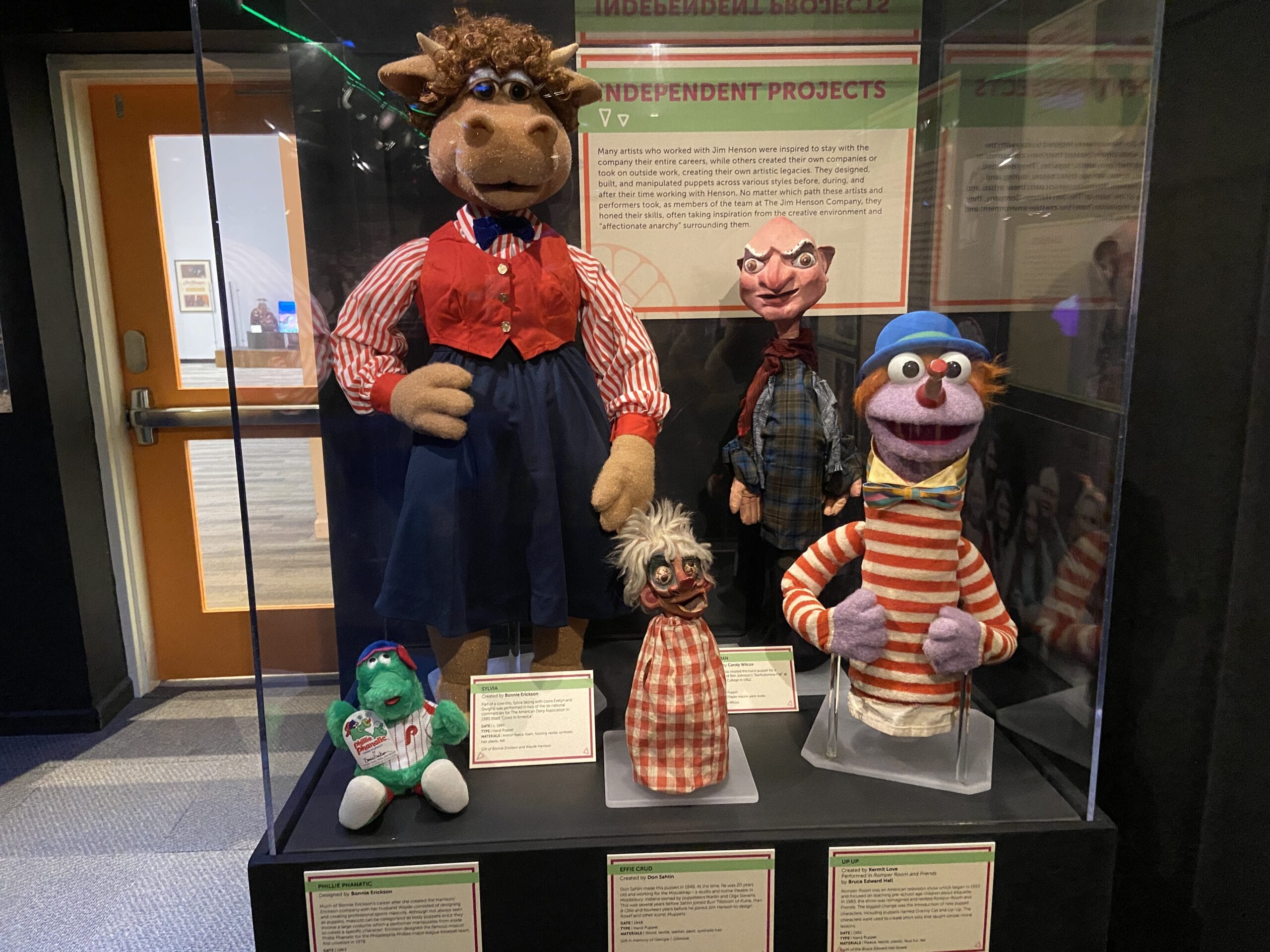
The puppets in this display were created by Henson collaborators for projects outside of The Jim Henson Company.
Independent Projects
Many artists who worked with Jim Henson were inspired to stay with the company their entire careers, while others created their own companies or took on outside work, creating their own artistic legacies. They designed, built, and manipulated puppets across various styles before, during, and after their time working with Henson. No matter which path these artists and performers took, as members of the team at The Jim Henson Company, they honed their skills, often taking inspiration from the creative environment and “affectionate anarchy” surrounding them.
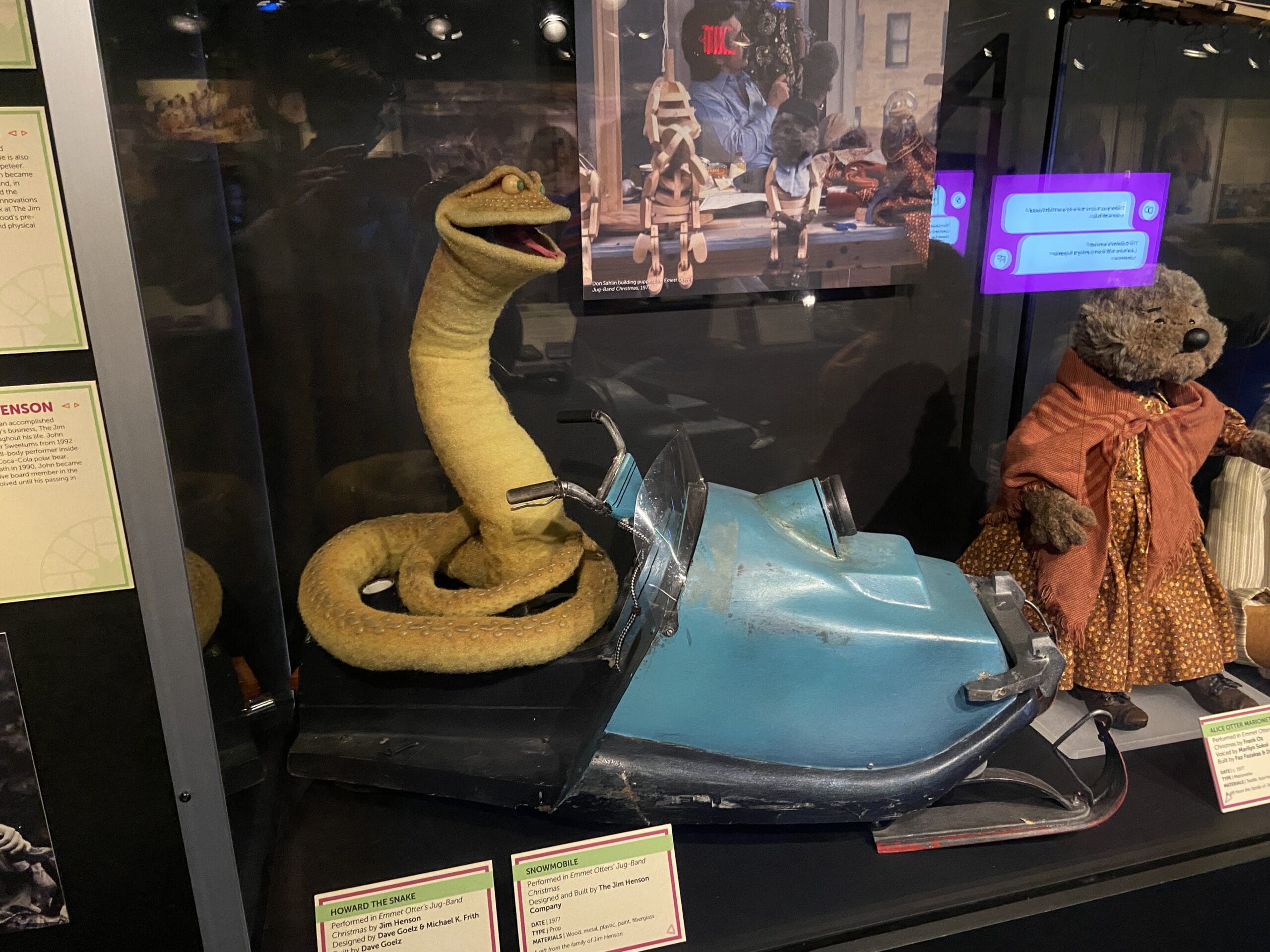
Here’s another puppet and prop from Emmet Otter’s Jug-Band Christmas. The rod puppet Howard the Snake was designed by Dave Goelz and Michael K. Frith, and built by Goelz.
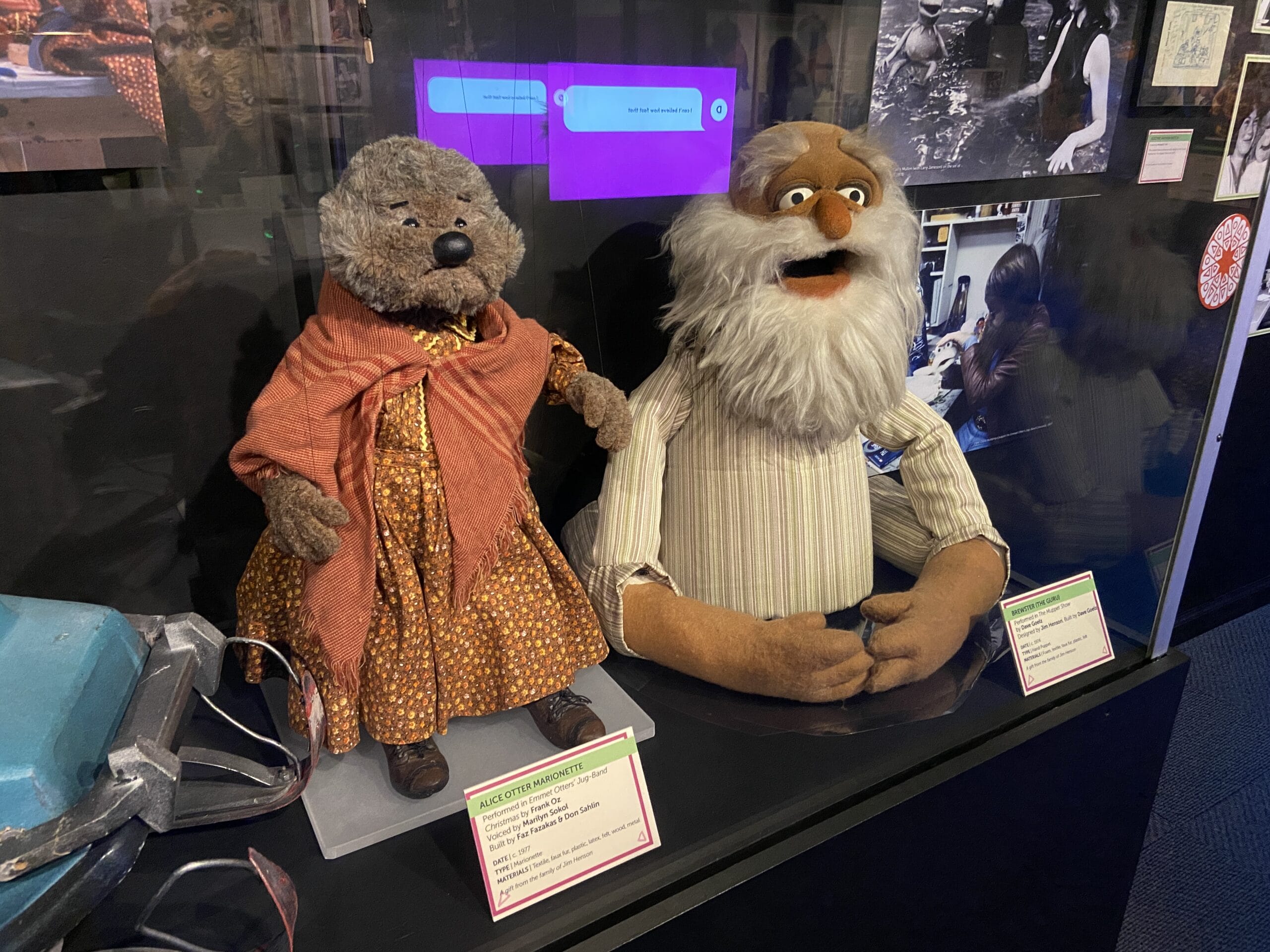
Also on display is an Alice Otter marionette. She was performed by Oz but voiced by Marilyn Sokol. The puppet was built by Faz Fazakas and Don Sahlin. She’s accompanied by Brewster (The Guru) from The Muppet Show. He was designed by Henson, but built and performed by Goelz.
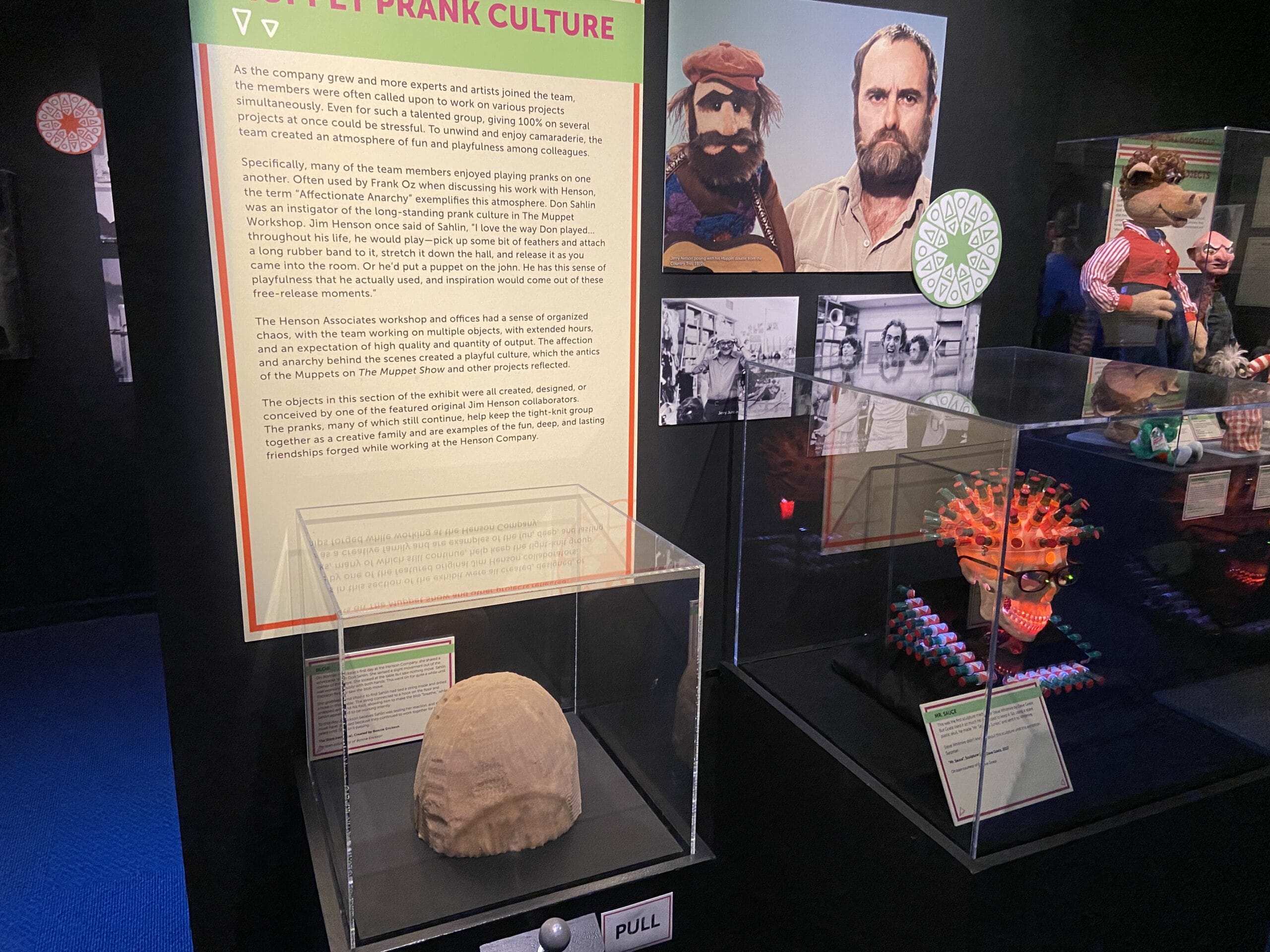
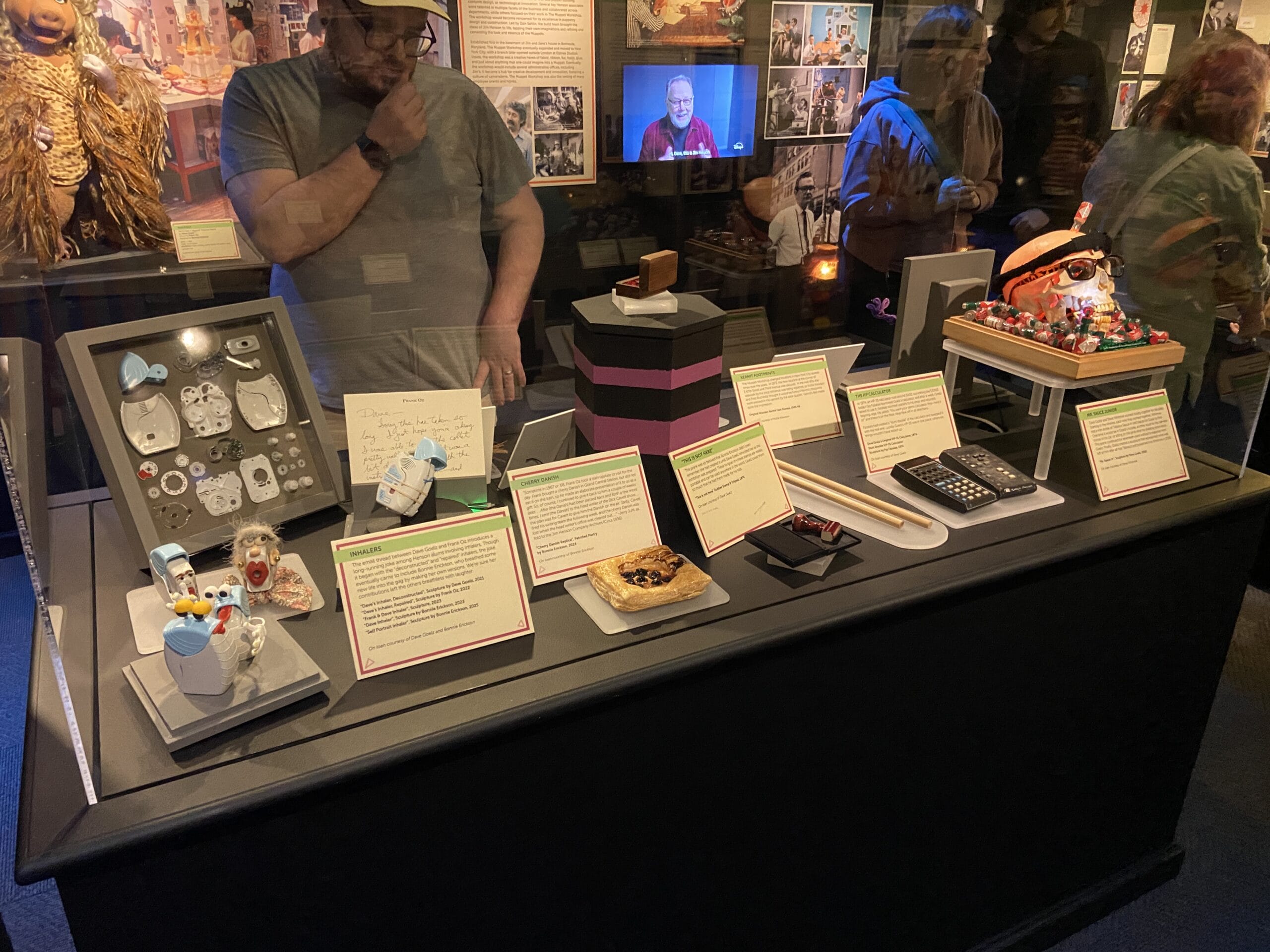
An entire section is dedicated to the prank culture of The Jim Henson Company featuring some of the prank items the artists created over the years.
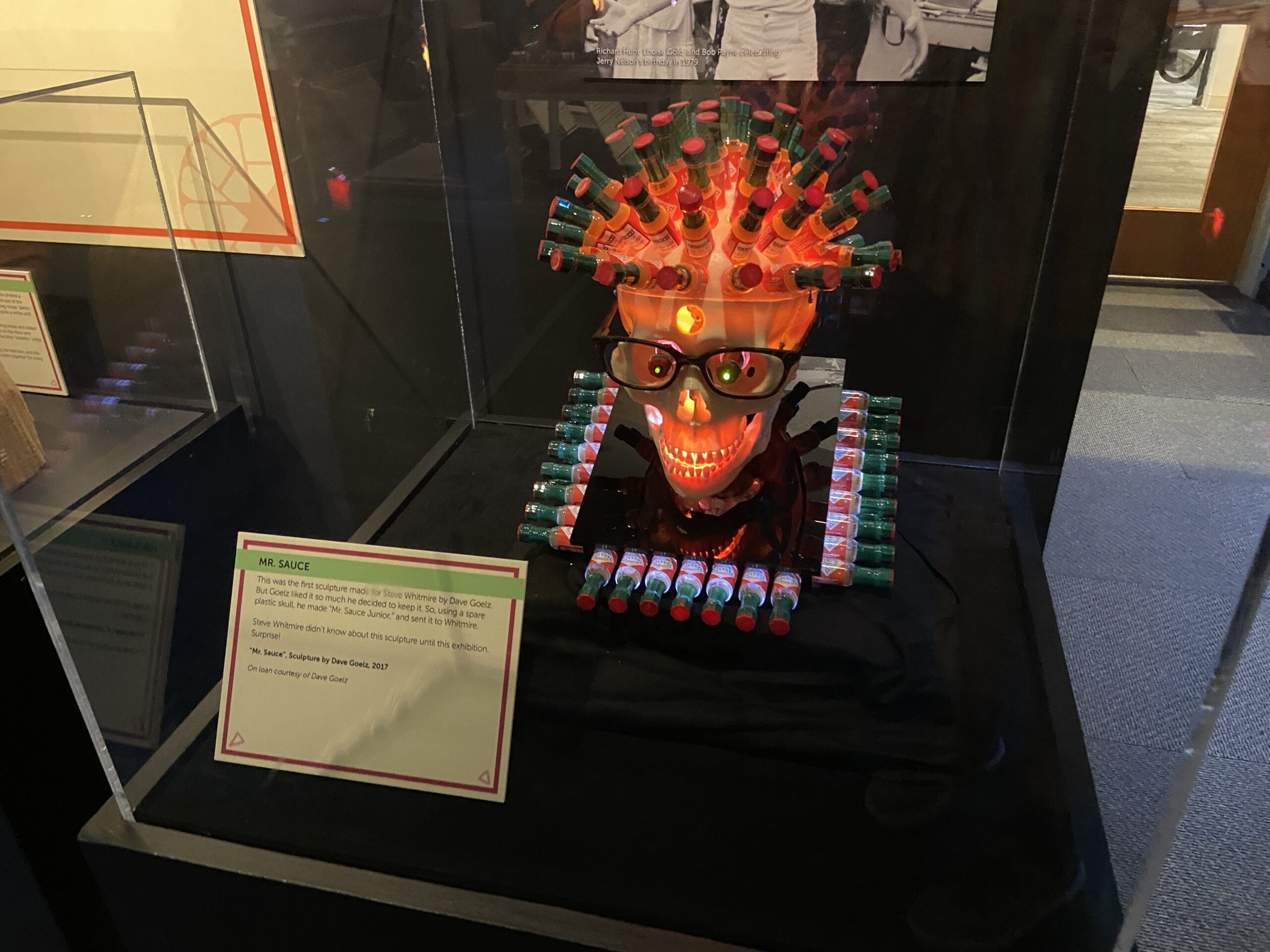
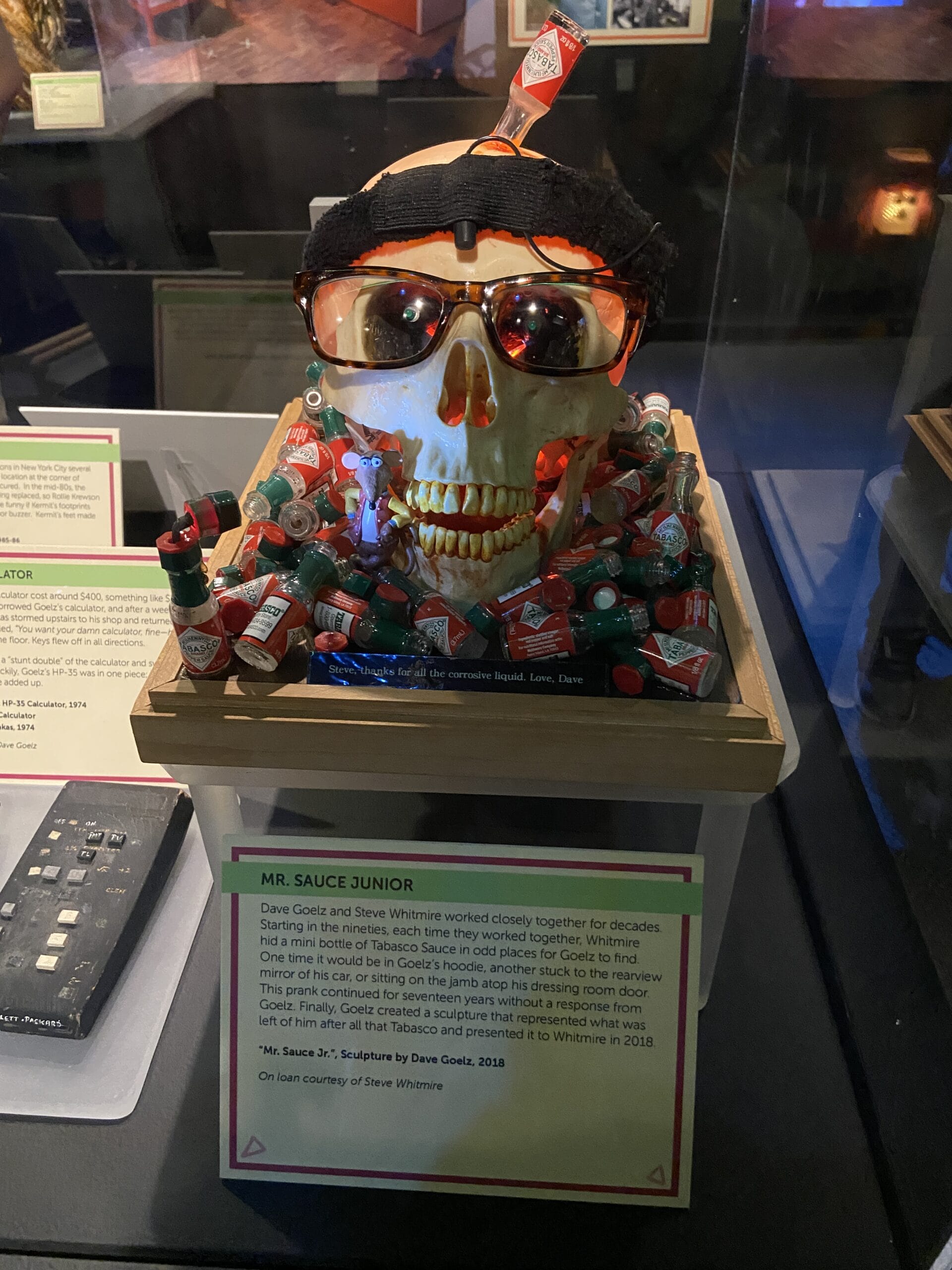
Here are Mr. Sauce and Mr. Sauce Junior, who have quite a backstory. Dave Goelz crafted both as prank gifts for Steve Whitmire. Each time the pair worked together, Whitmire hid a mini bottle of Tobasco Sauce in an odd place for Goelz to find: his hoodie, his car’s rearview mirror, atop his dressing room door. This prank went on for 17 years before Goelz responded with a sculpture that represented all that was left of him after all that Tobasco.
He initially crafted Mr. Sauce but liked it so much that he decided to keep it. So he made Mr. Sauce Junior to give to Whitmire.
Whitmire didn’t know about the original Mr. Sauce sculpture until this exhibition.
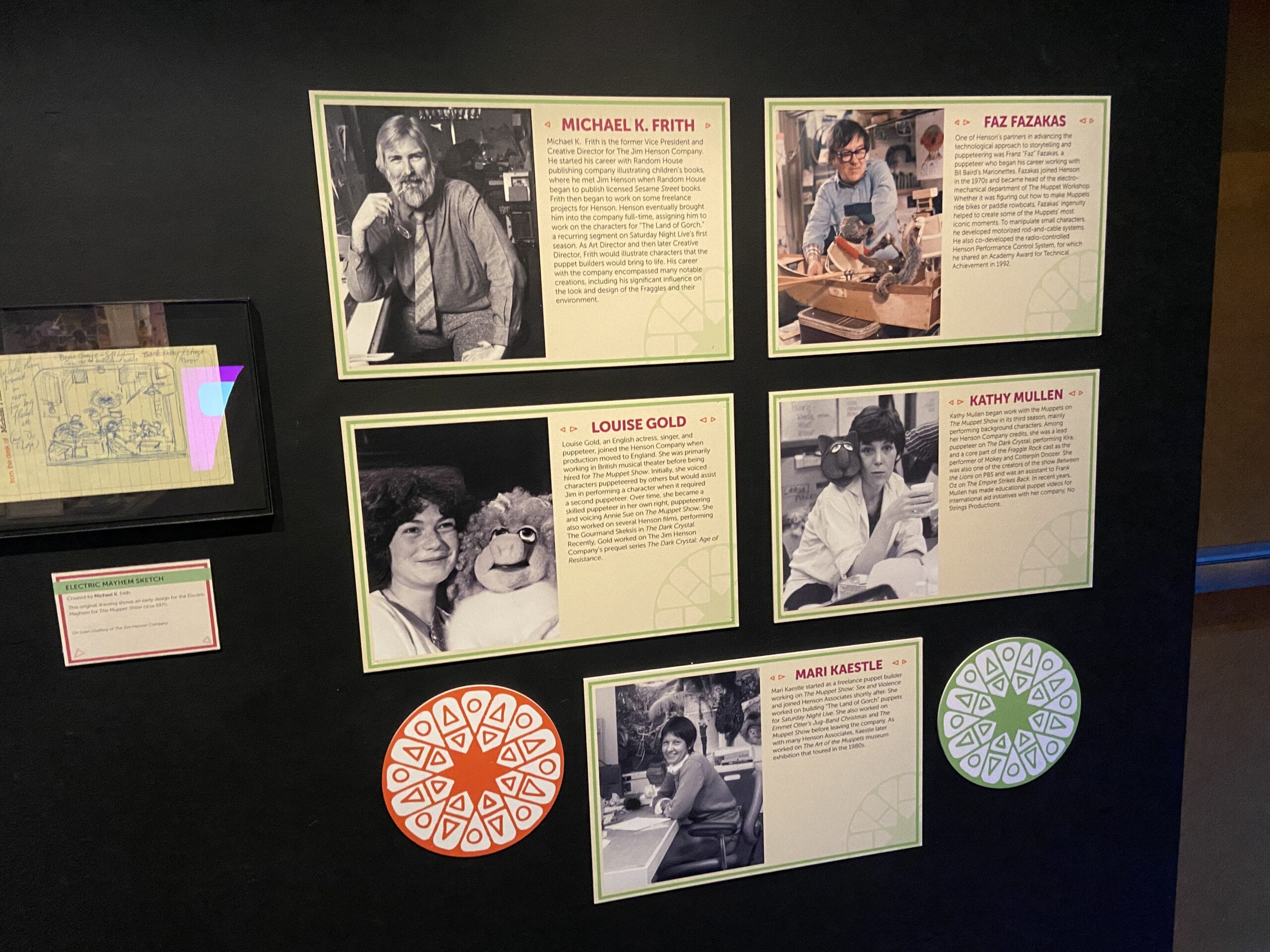
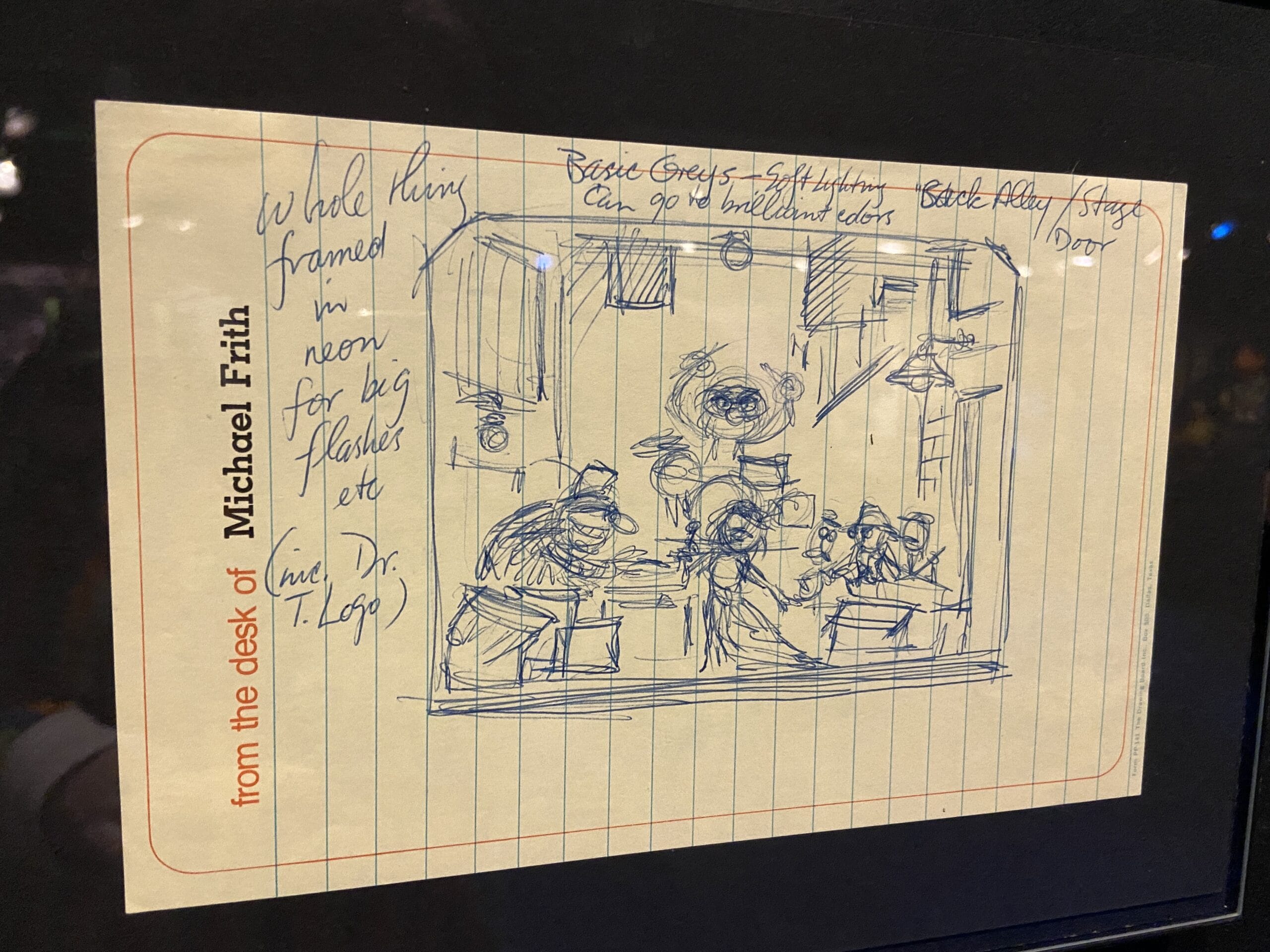
Moving on, there are plaques about Michael K. Frith, Faz Fazakas, Louise Gold, Kathy Mullen, and Mari Kaestle. Alongside these signs is an Electric Mayhem sketch by Frith showing an early design for the band circa 1975.
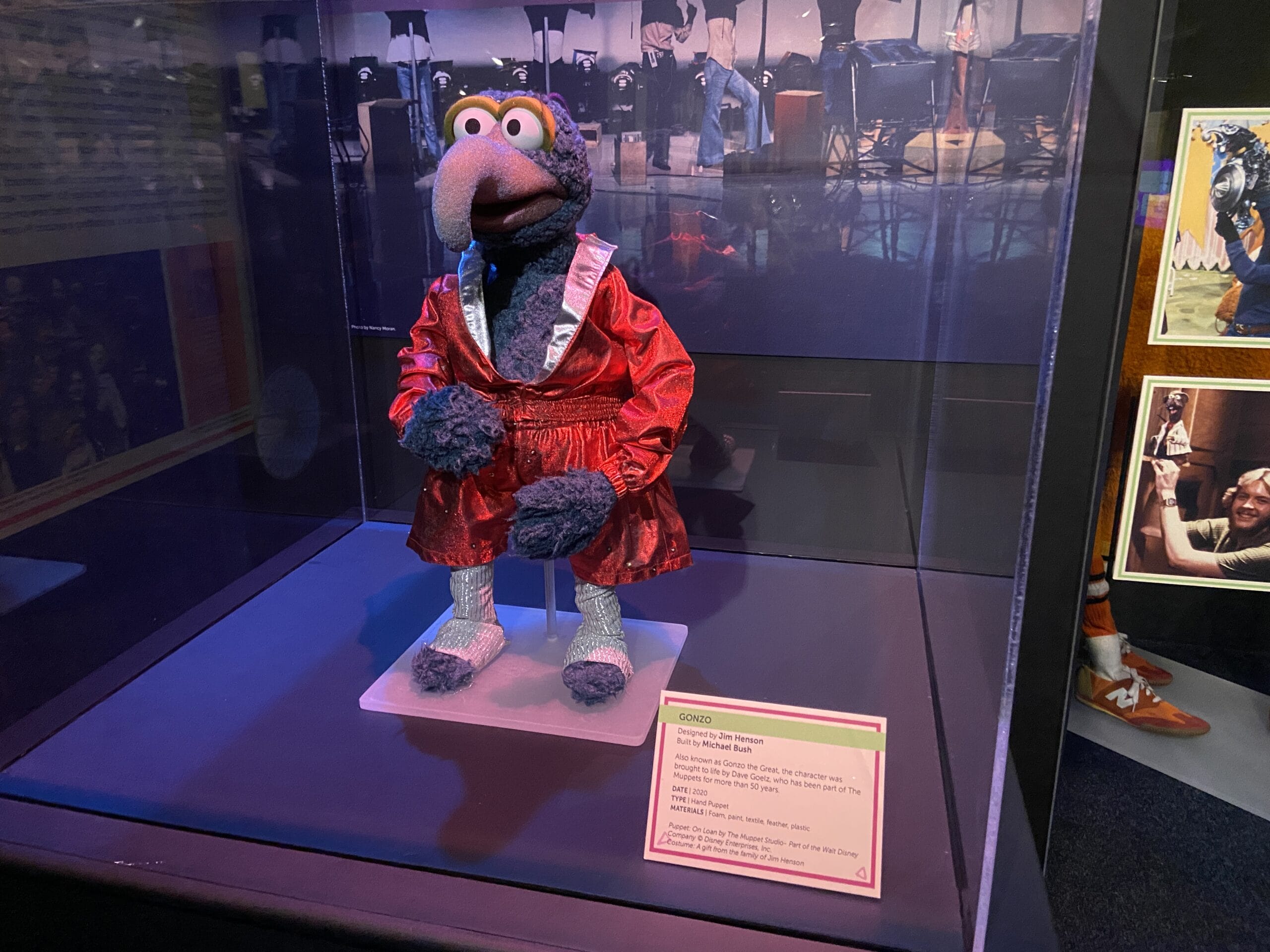
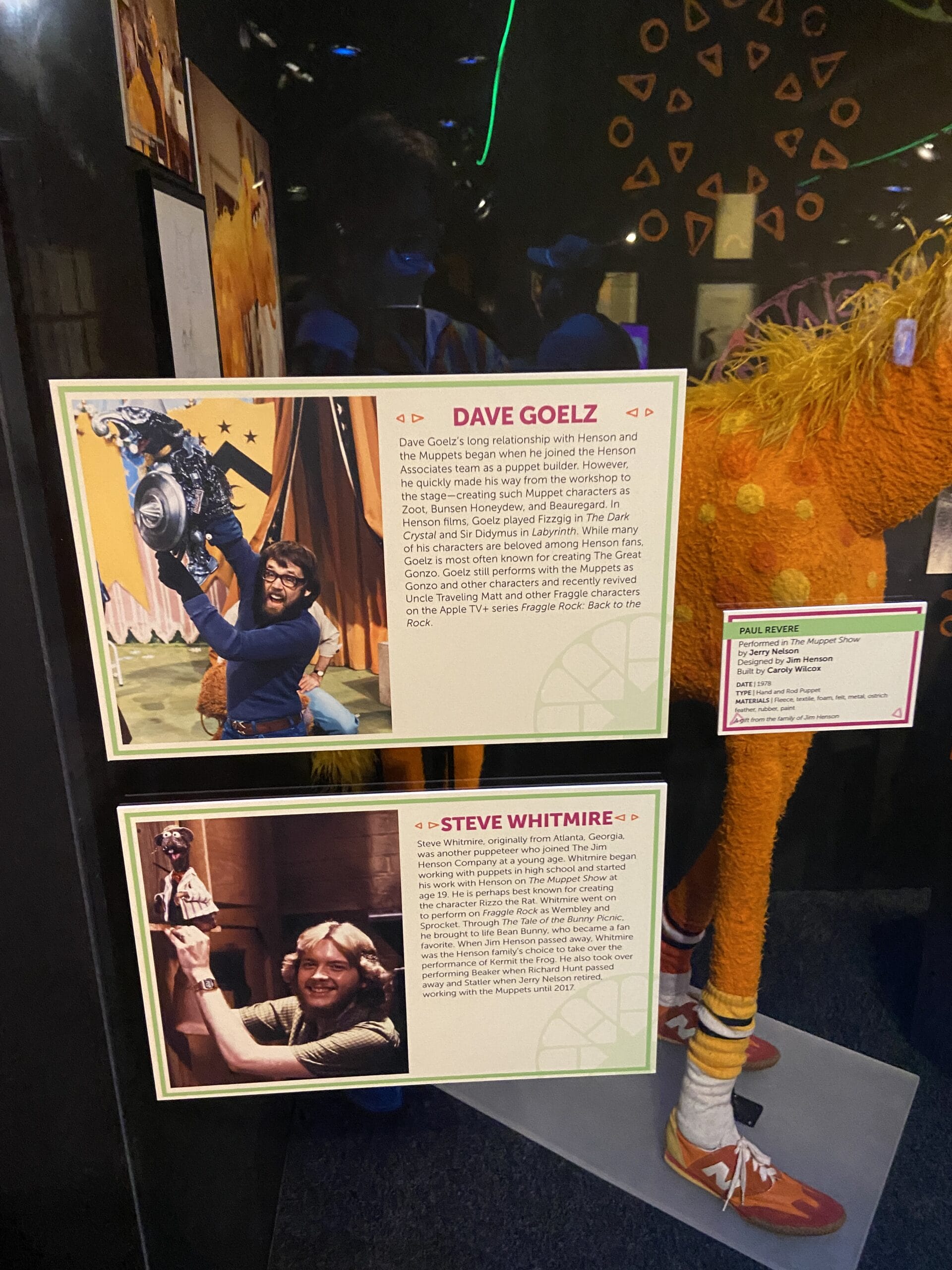
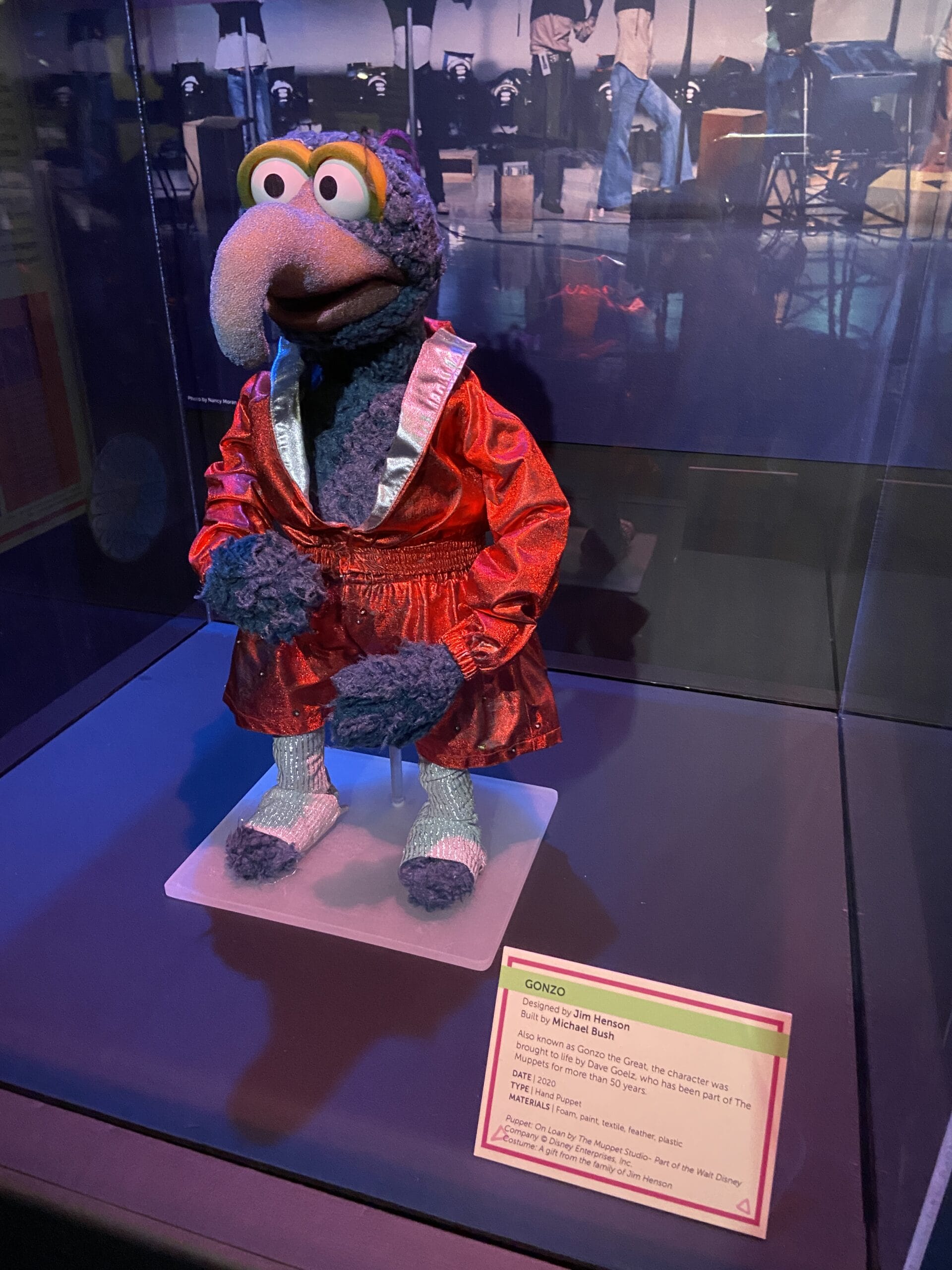
There are plaques for Dave Goelz and Steve Whitmire near a Gonzo the Great puppet built by Michael Bush in 2020 out of foam, paint, textile, feather, and plastic. Of course, Gonzo has been part of The Muppets for much longer than five years. He’s performed by Goelz.
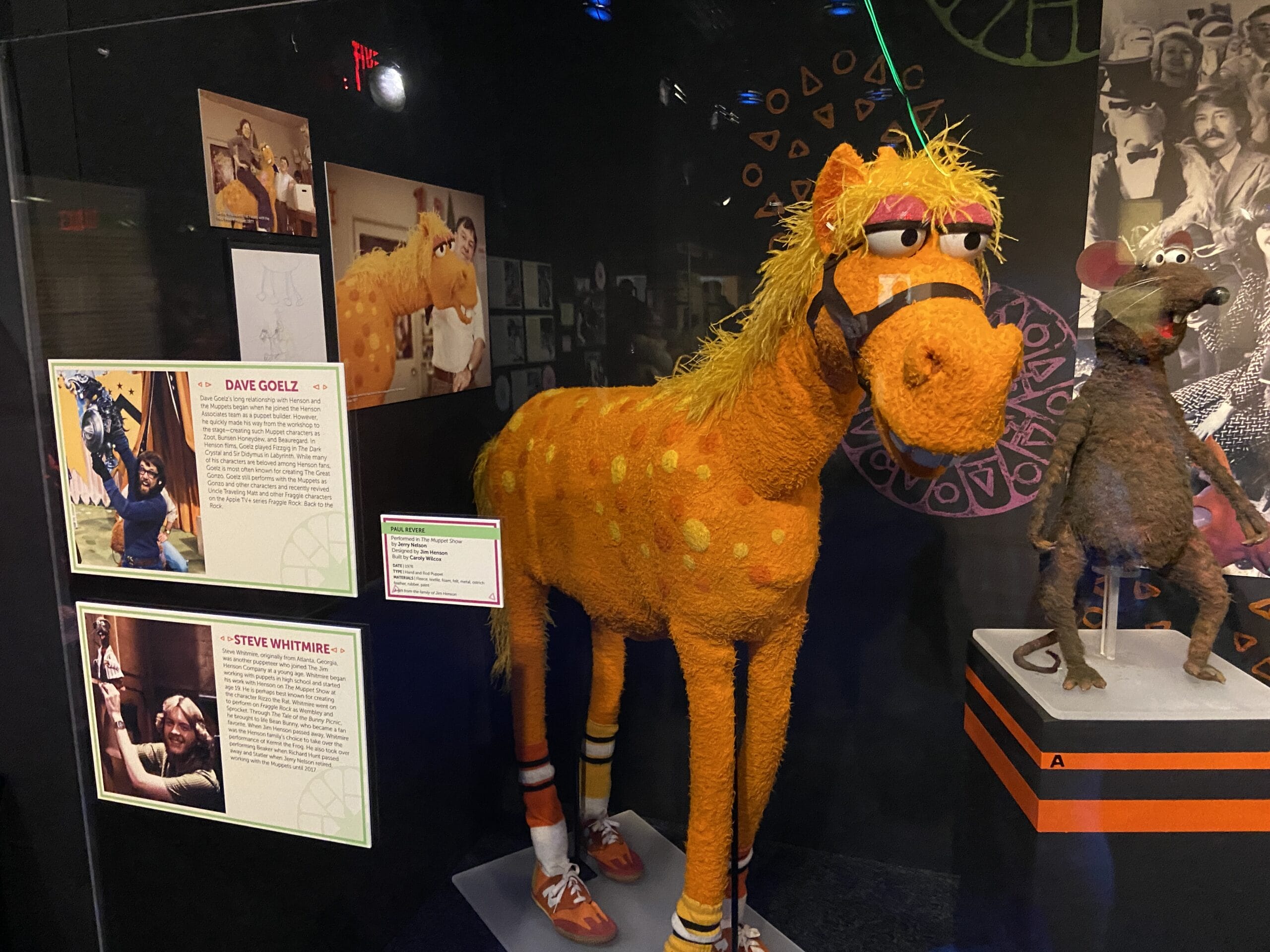
Nearby is Paul Revere, a large horse puppet built by Caroly Wilcox in 1978. The character was performed on The Muppet Show by Jerry Nelson.
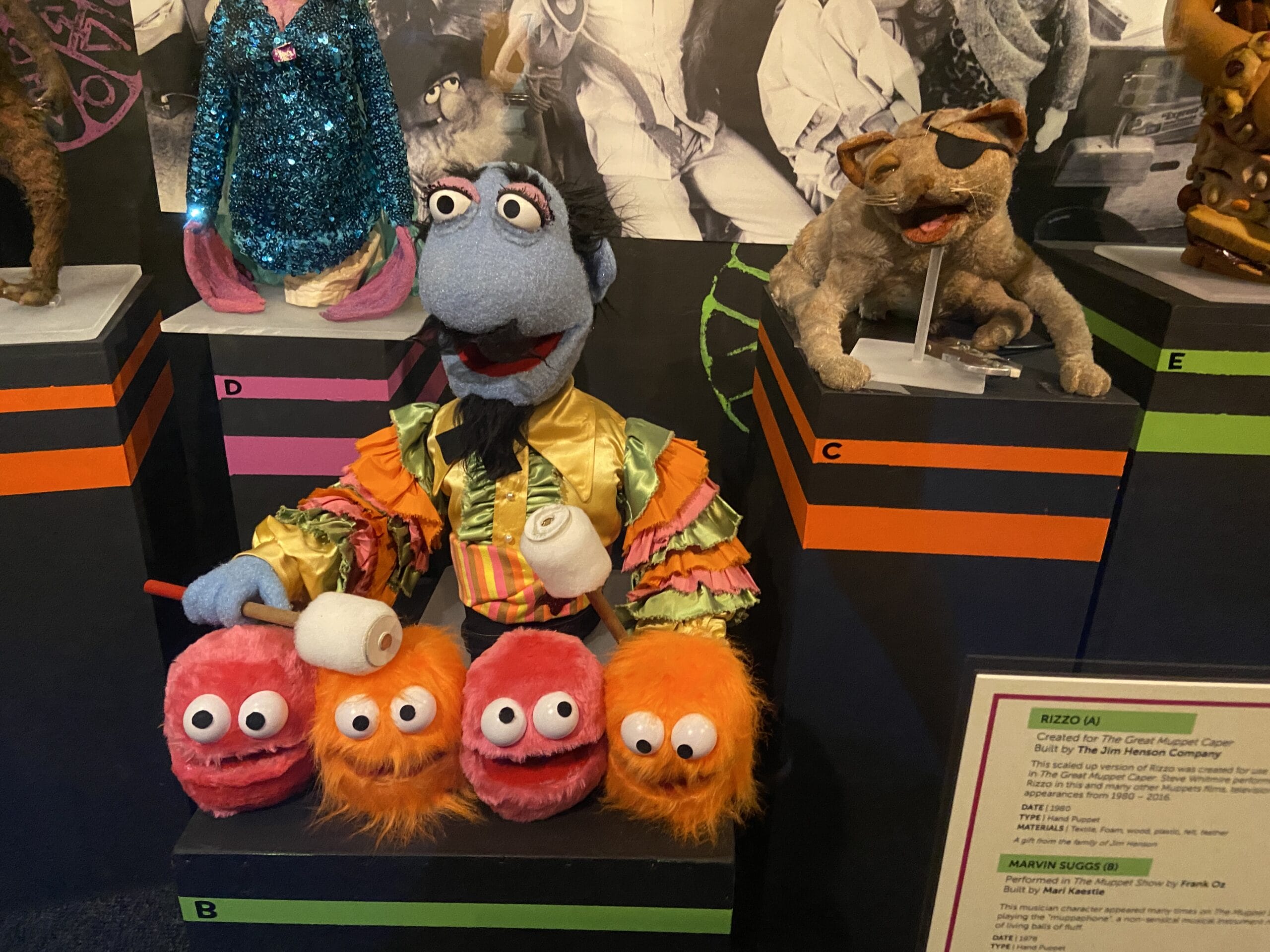
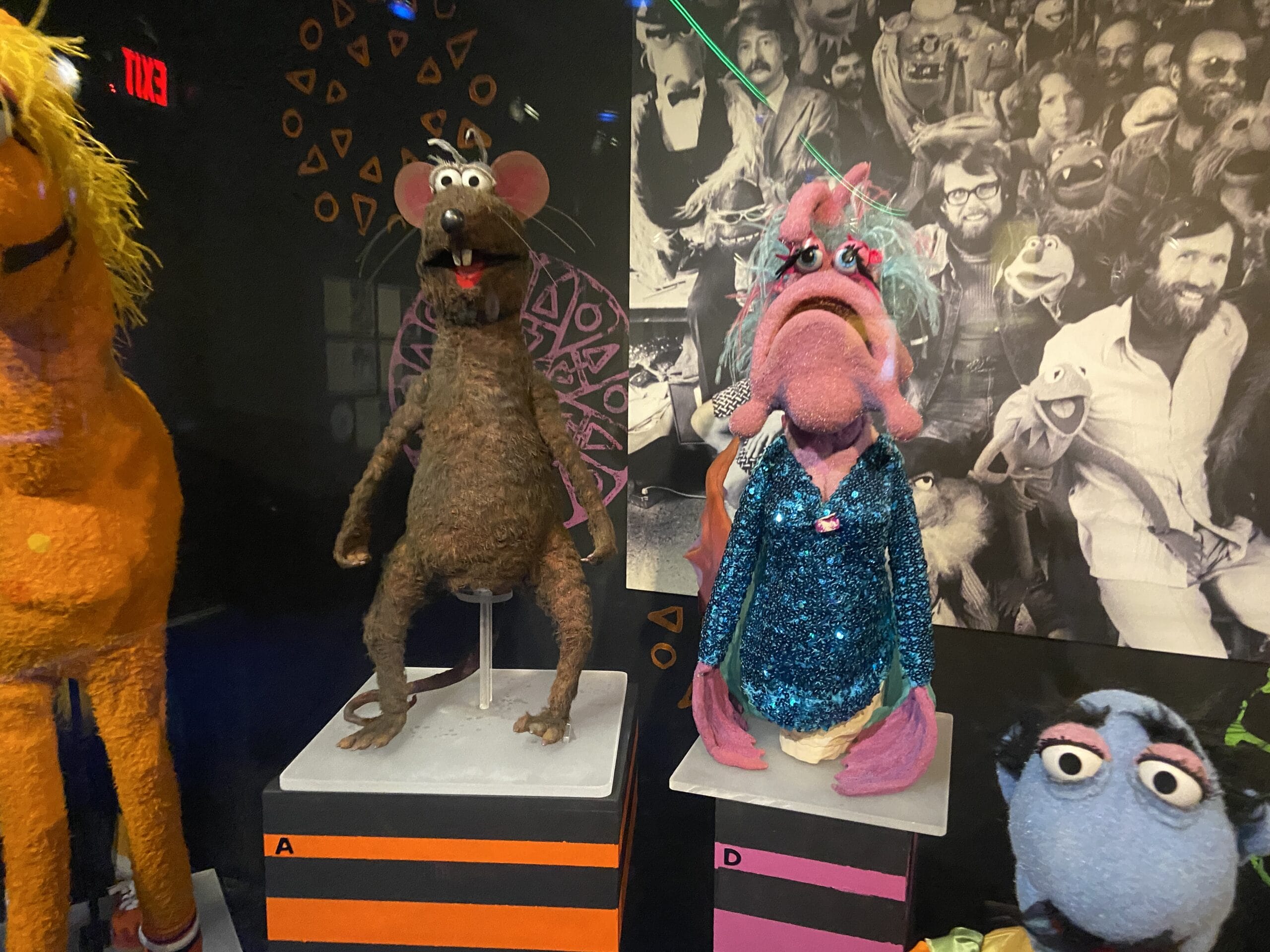
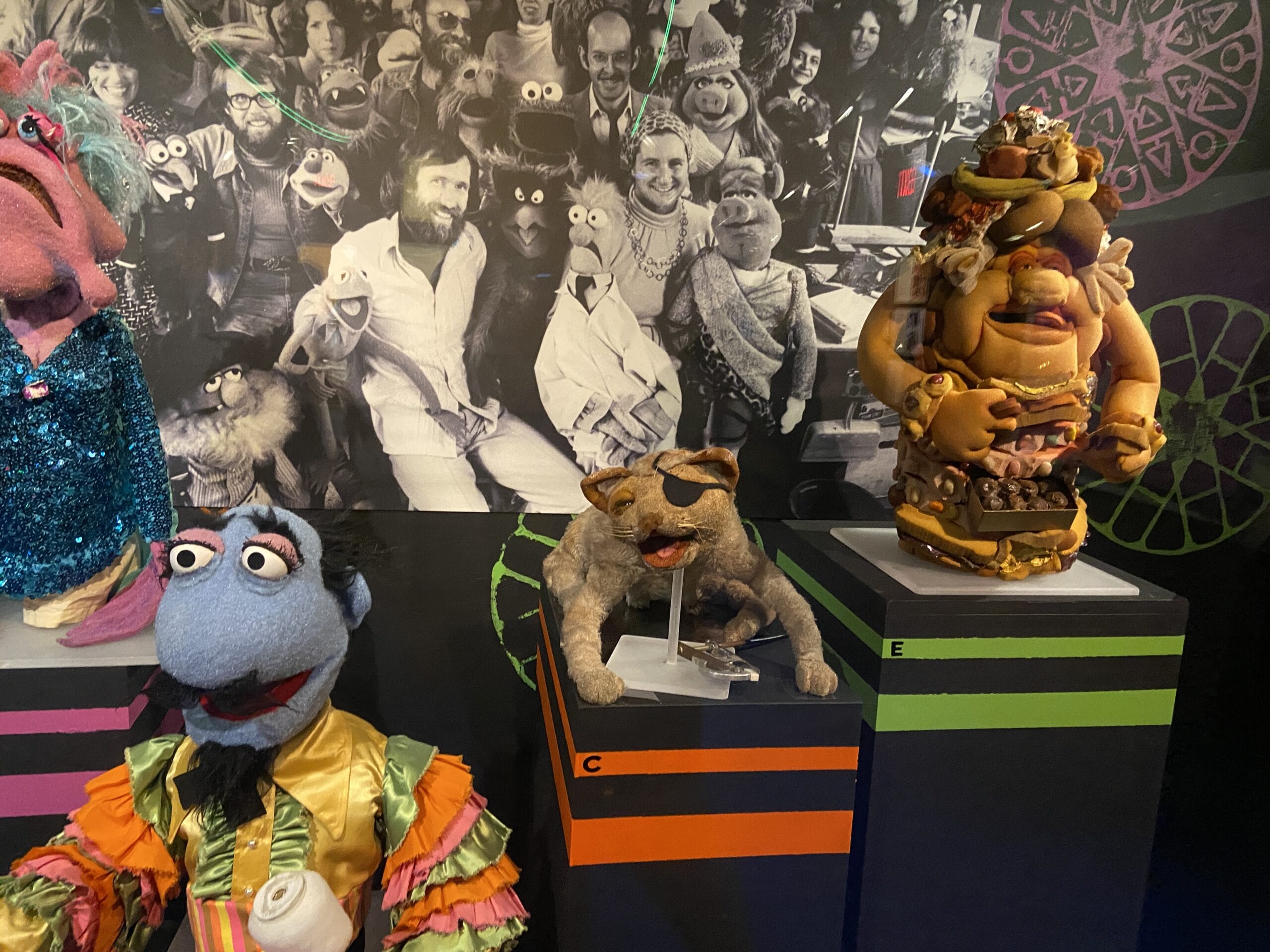
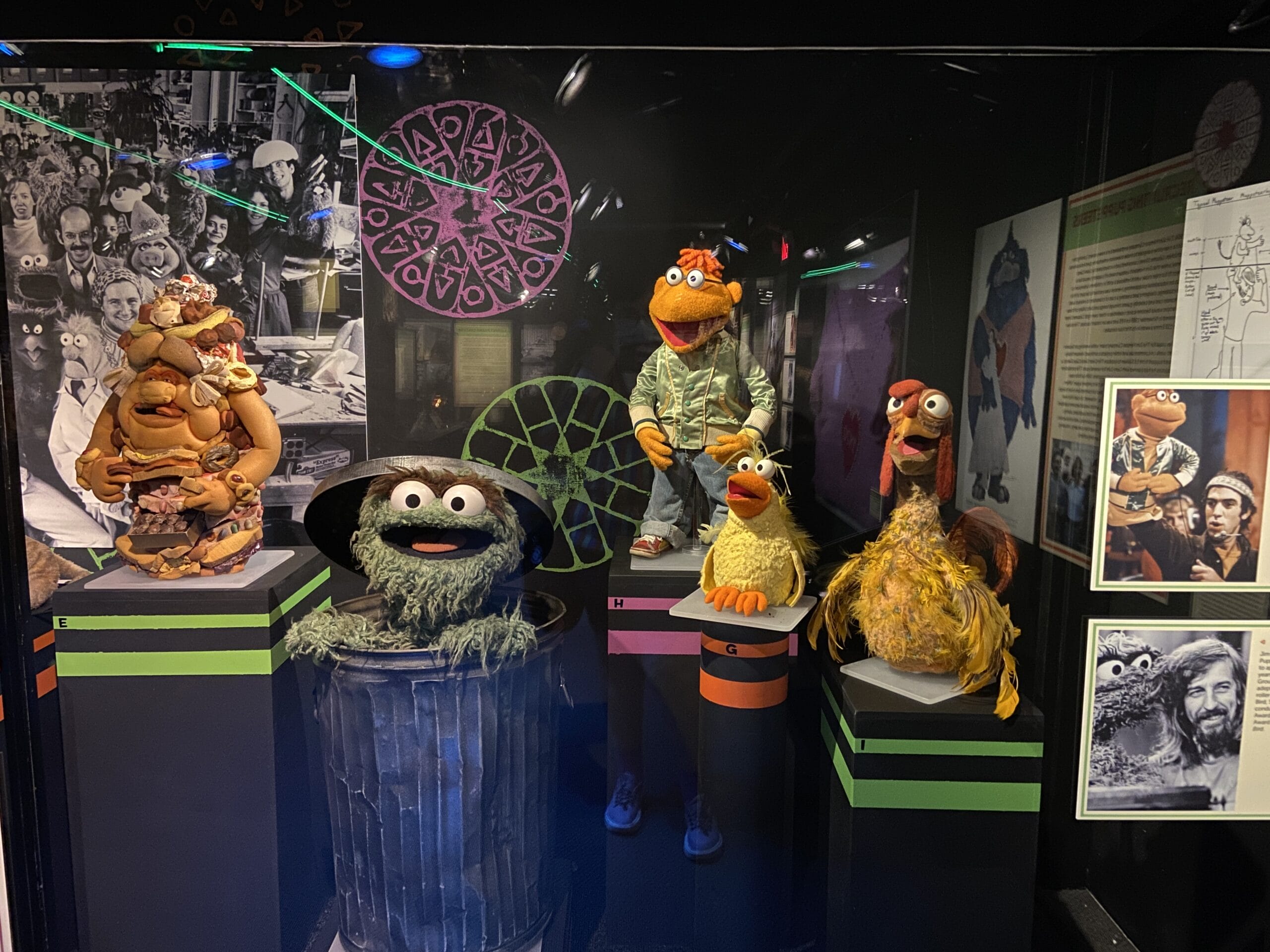
Also in this display case is a Rizzo puppet created for The Great Muppet Caper. He’s a scaled up version used for specific shots. Other puppets include Marvin Suggs built by Mari Kaestle in 1976, Gaffer the Backstage Cat built by Marianne Harms circa 1980, a Fish Singer from 1980, Gluttony designed by Frith and Wilcox from 1974, Oscar the Grouth from Sesame Street built by Sahlin, Little Bird also built by Sahlin, Scooter built by Goelz and Rollie Krewson in 1980, and T.R. Rooster built by Sahlin, John Lovelady, and Wilcox in 1972.
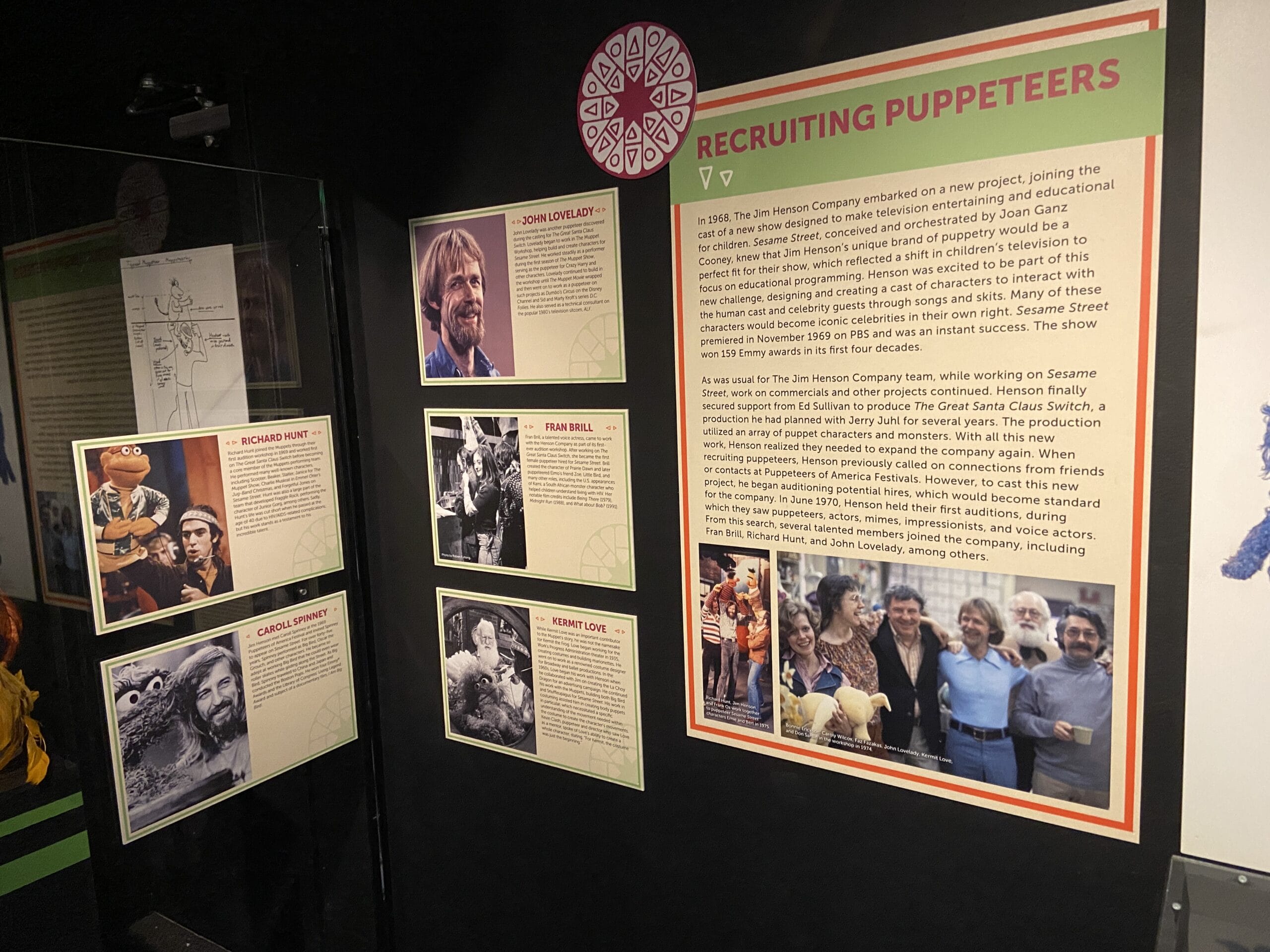
Alongside a sign about recruiting puppeteers are biographies for Richard Hunt, Caroll Spinney, John Lovelady, Fran Brill, and Kermit Love. (No, he was not the namesake for Kermit the Frog.)
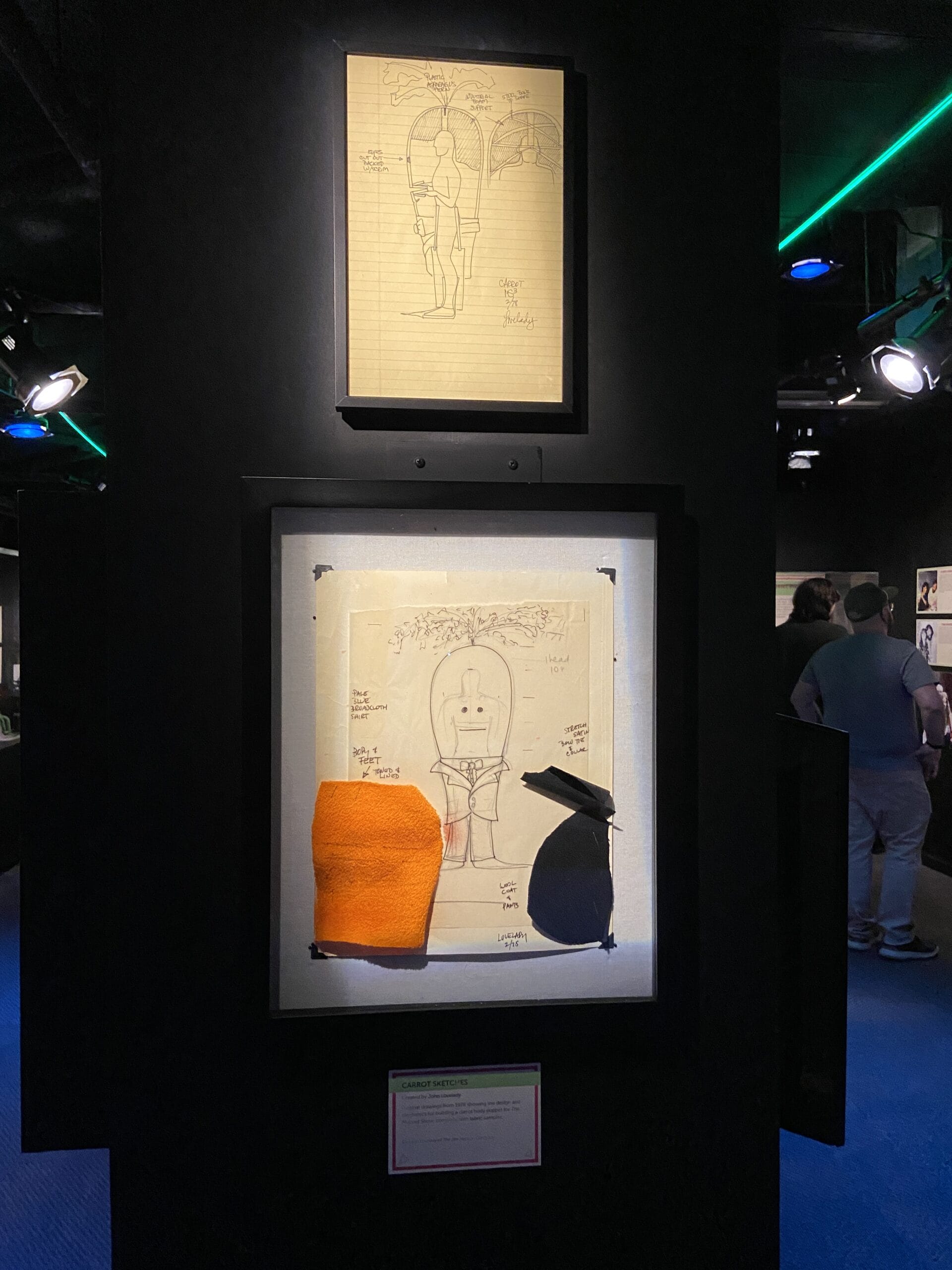
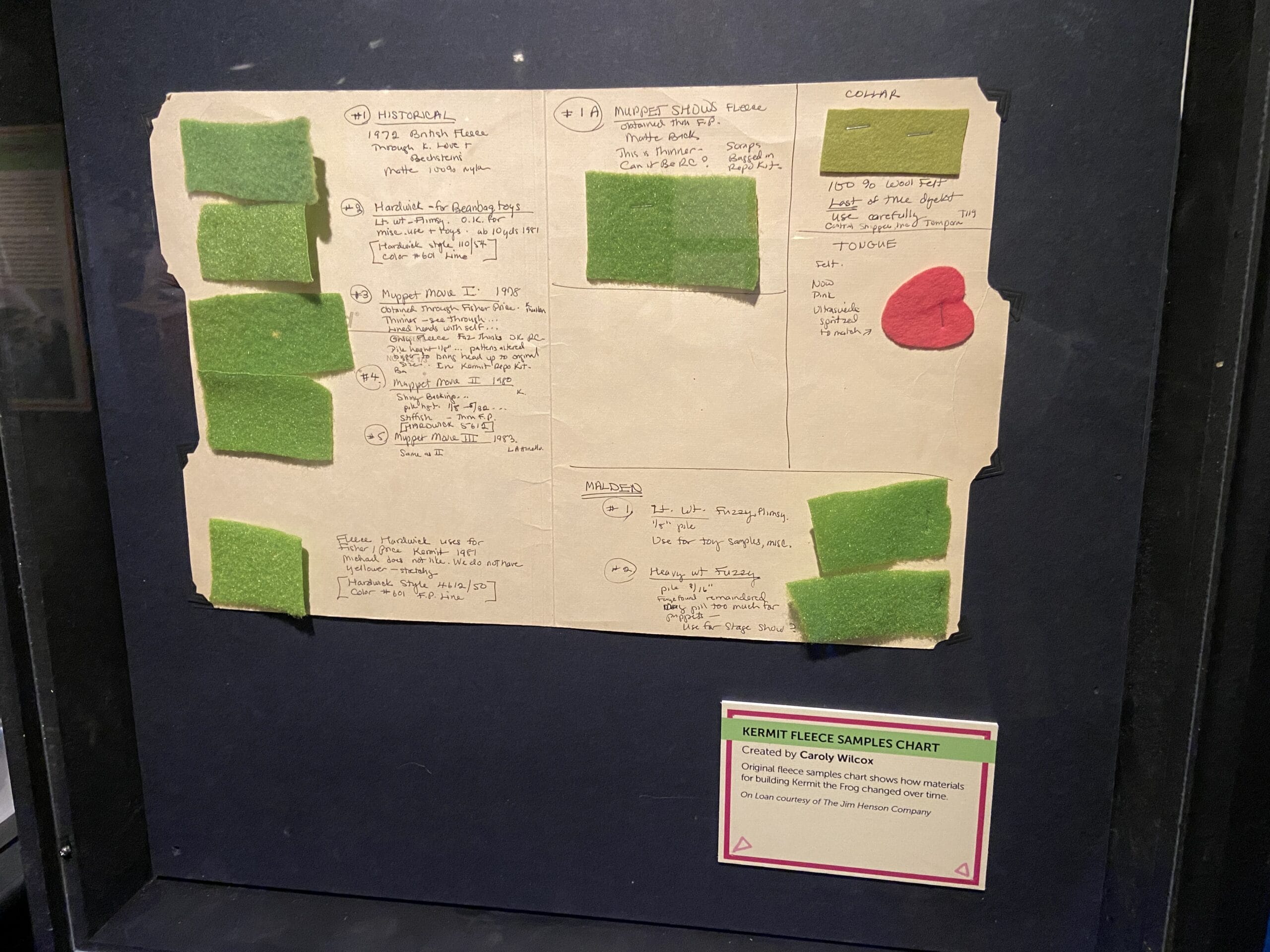
There are sketches and charts on display. The one on the right is about Kermit fleece samples.
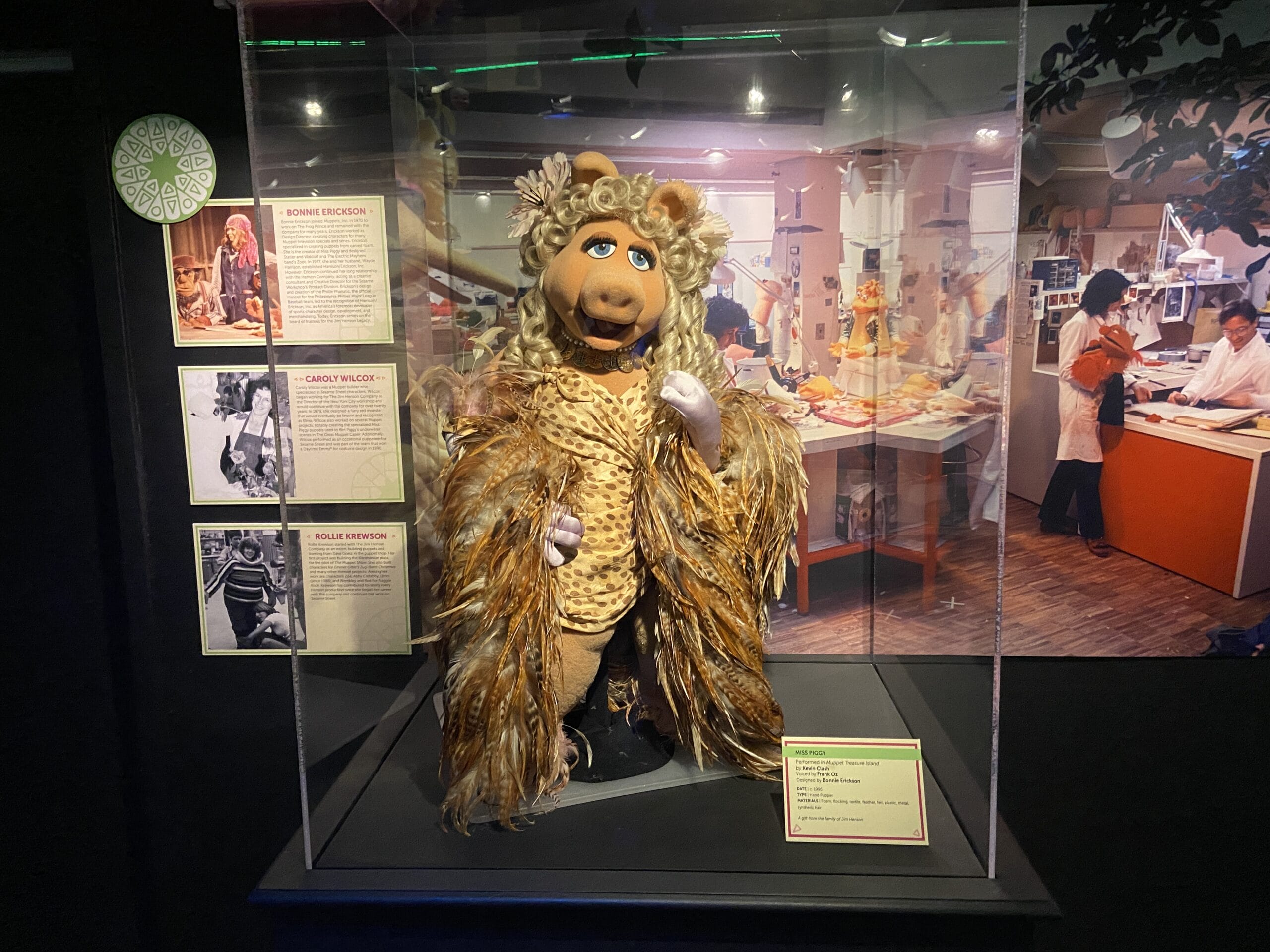
It wouldn’t be a Muppet display without Miss Piggy. She is alongside plaques about Bonnie Erickson, Caroly Wilcox, and Rollie Krewson. This particular piggy was created by Erickson for Muppet Treasure Island.
Global Gallery
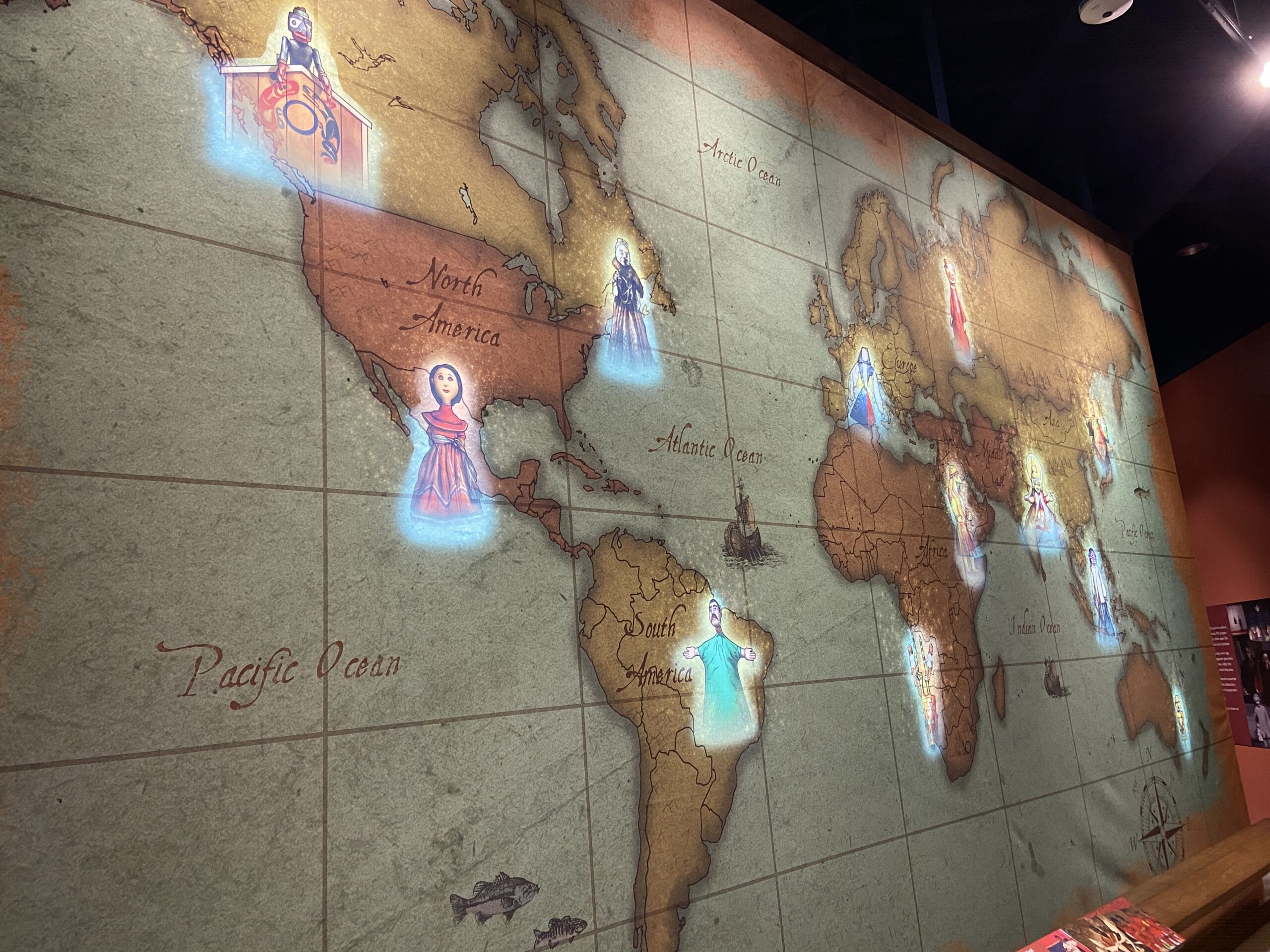
We can’t cover everything on display in the Global Gallery, but here are some of the most recognizable items that were on display during our visit.
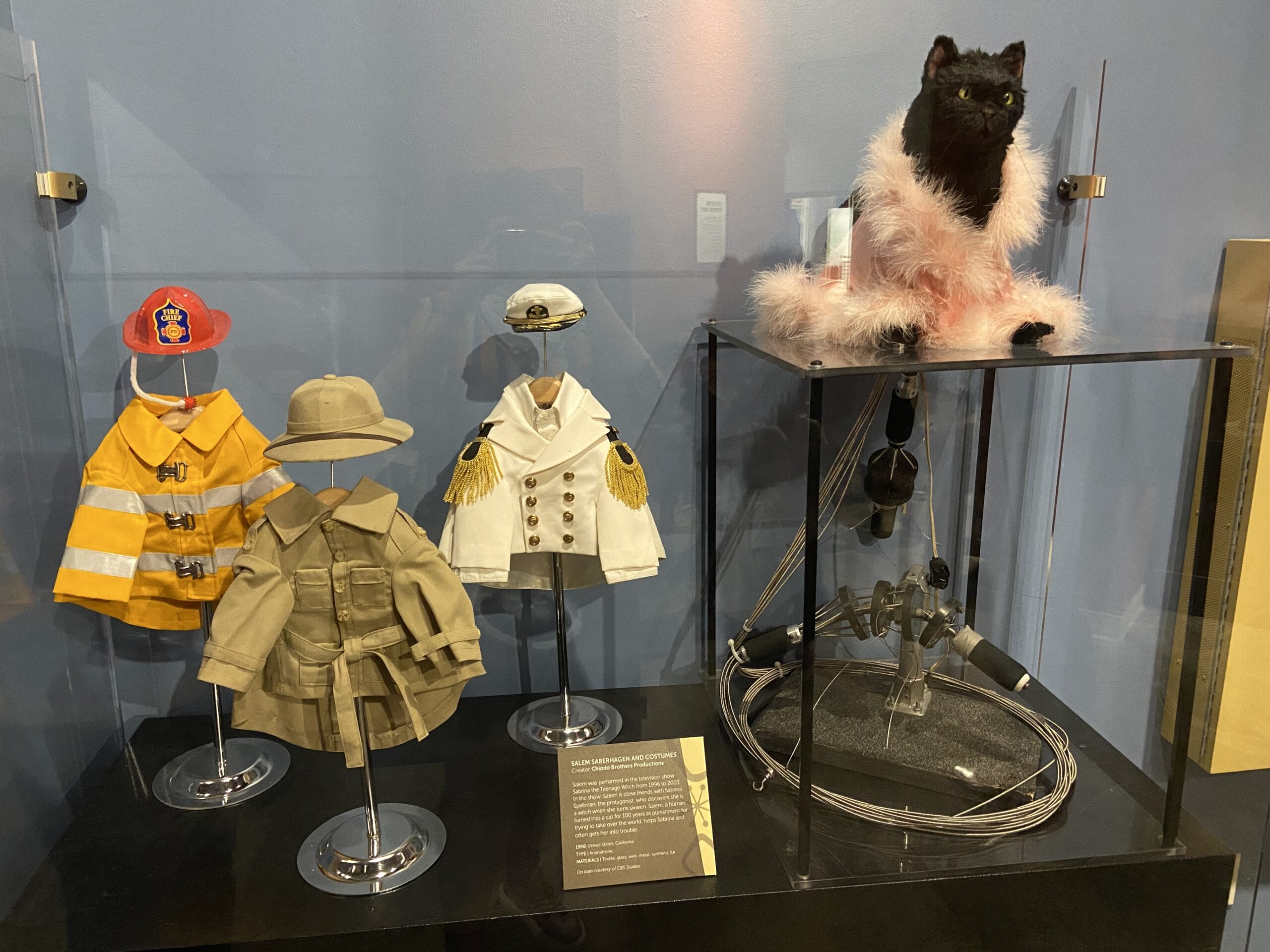
Fans of Sabrina the Teenage Witch will recognize this black cat. It’s Salem Saberhagen, alongside some of his costumes. This animatronic puppet was created by Chiodo Brothers Productions.
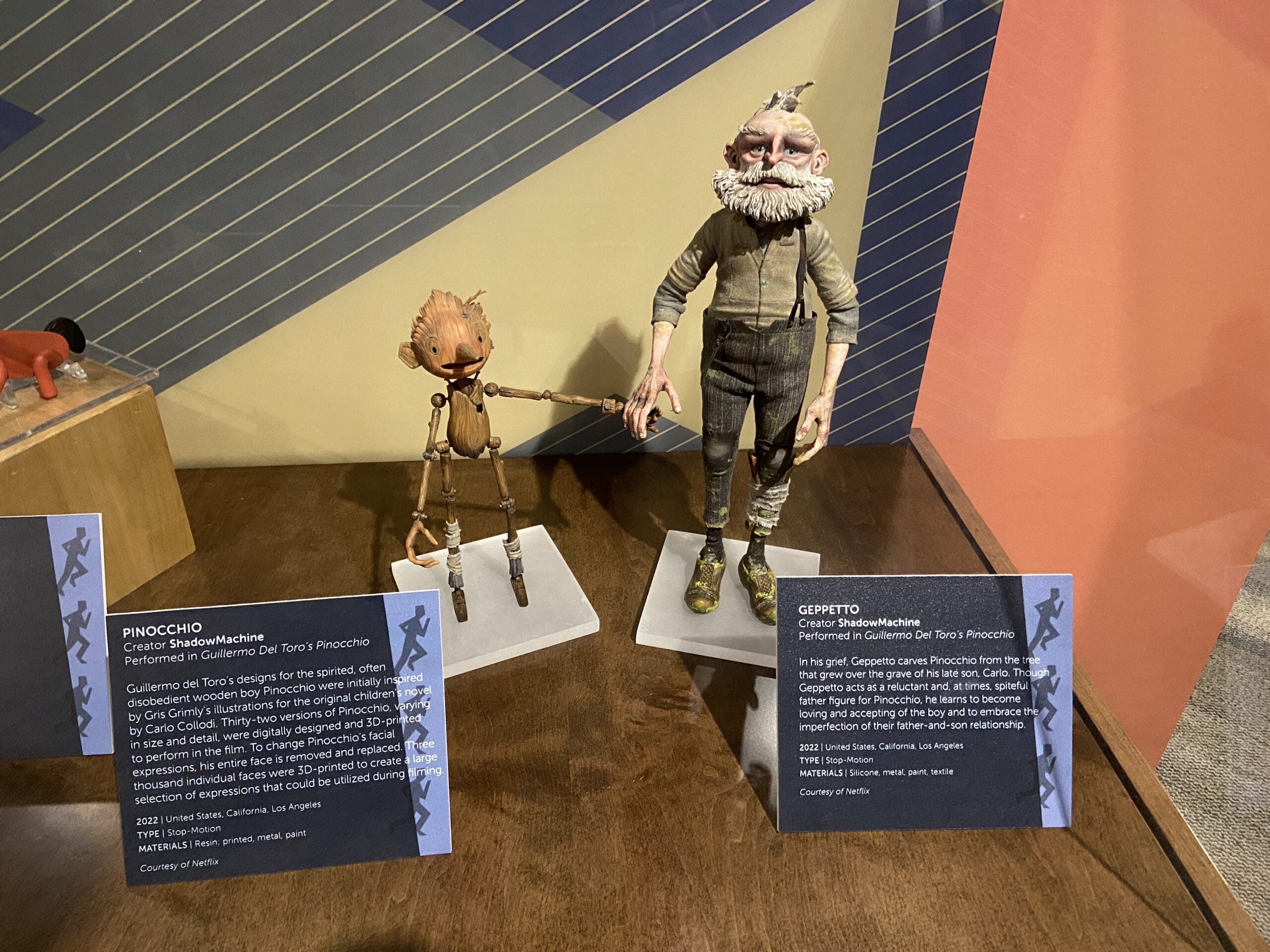
In the stop-motion section are the Pinocchio and Geppetto puppets from Guillermo Del Toro’s Pinocchio (2022). These were created by ShadowMachine.
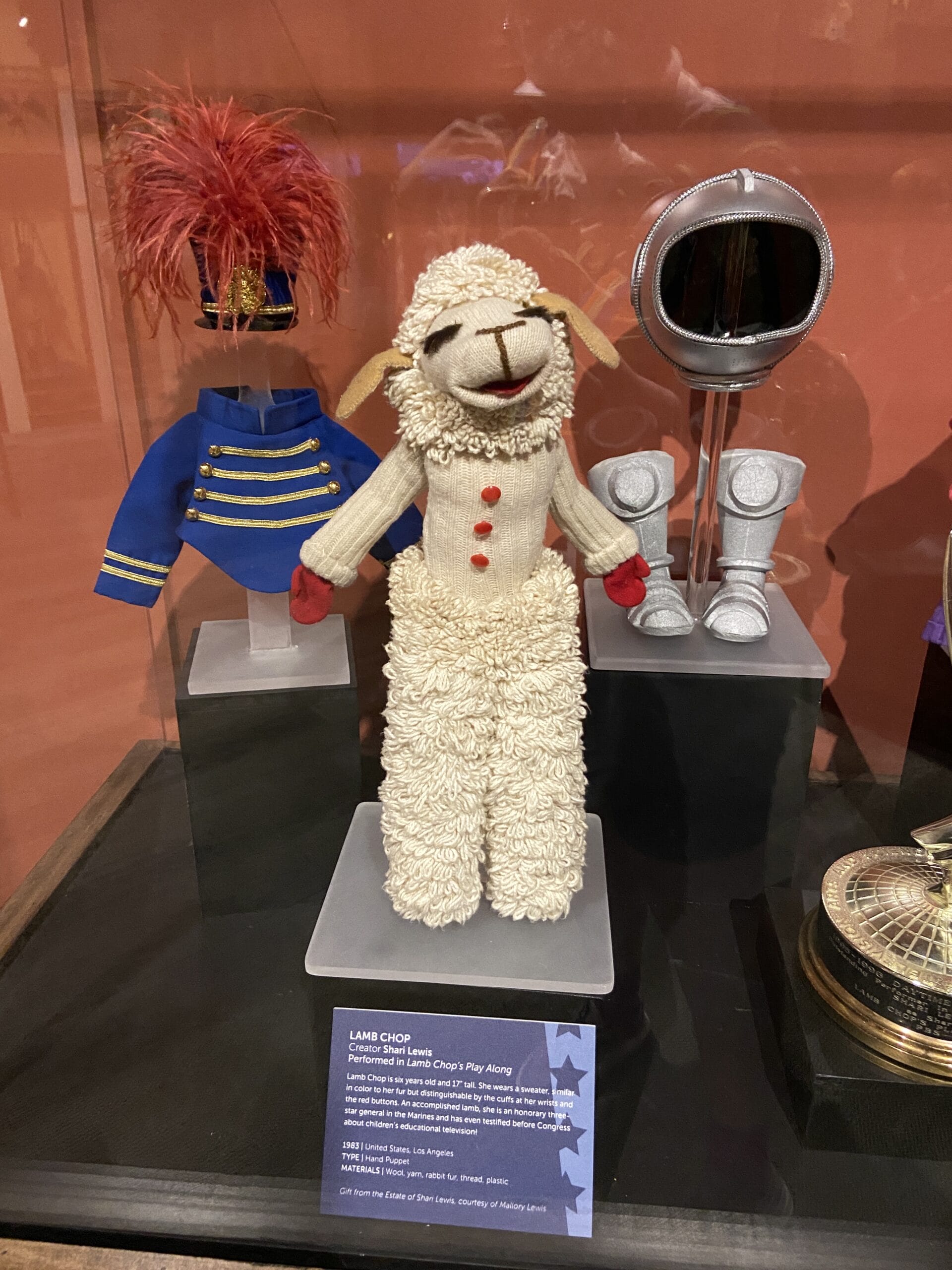
This might be a throwback for some readers. Lamb Chop was created and performed by Shari Lewis. Though Lamb Chop dates back to the 1950s, this particular hand puppet was created in 1983 and performed in Lamb Chop’s Play Along.
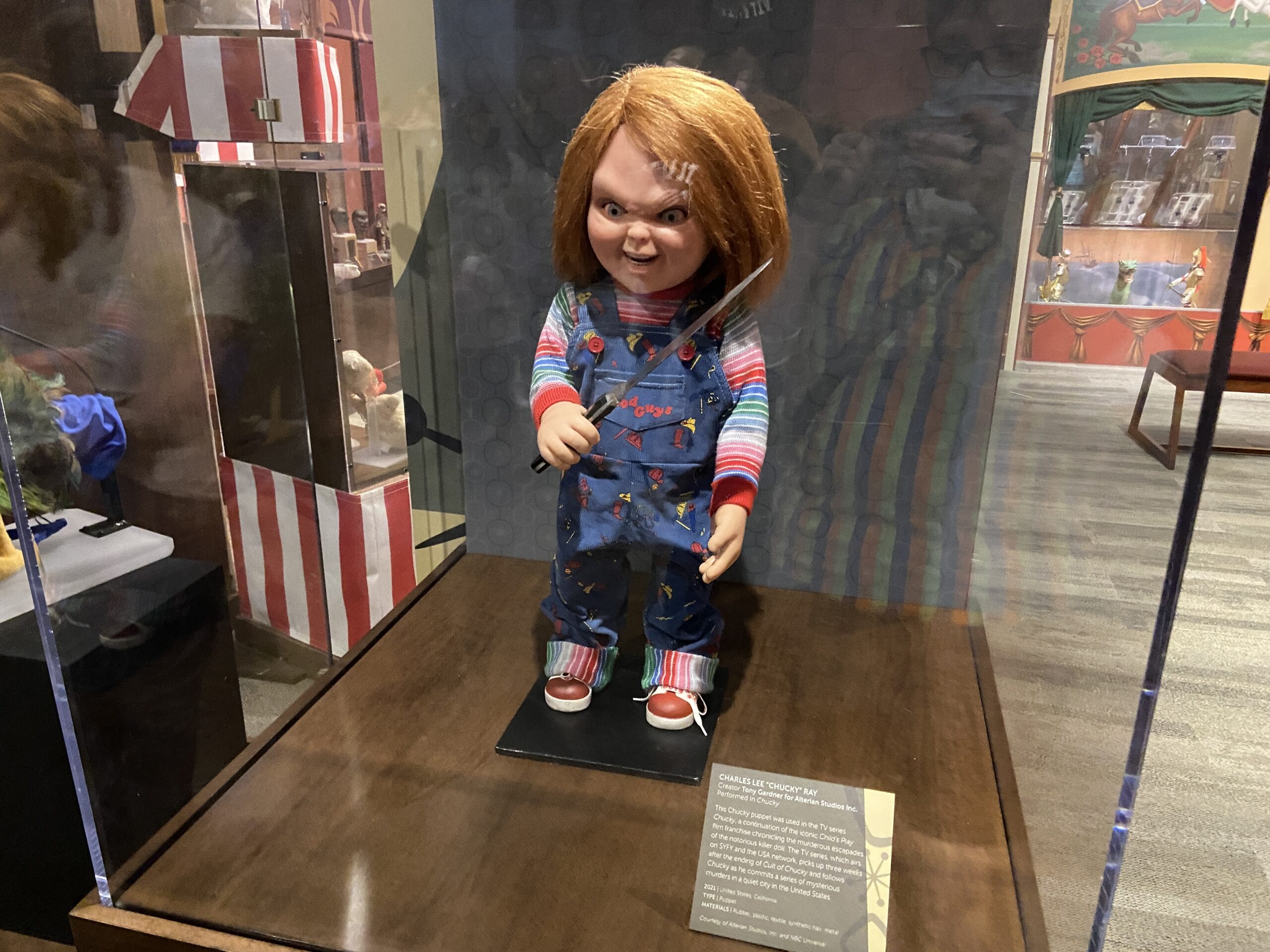
We know this guy! It’s Chucky from the famous horror franchise frequently featured at Universal Halloween Horror Nights. This is a puppet created by Tony Gardner for the 2021 Chucky series.
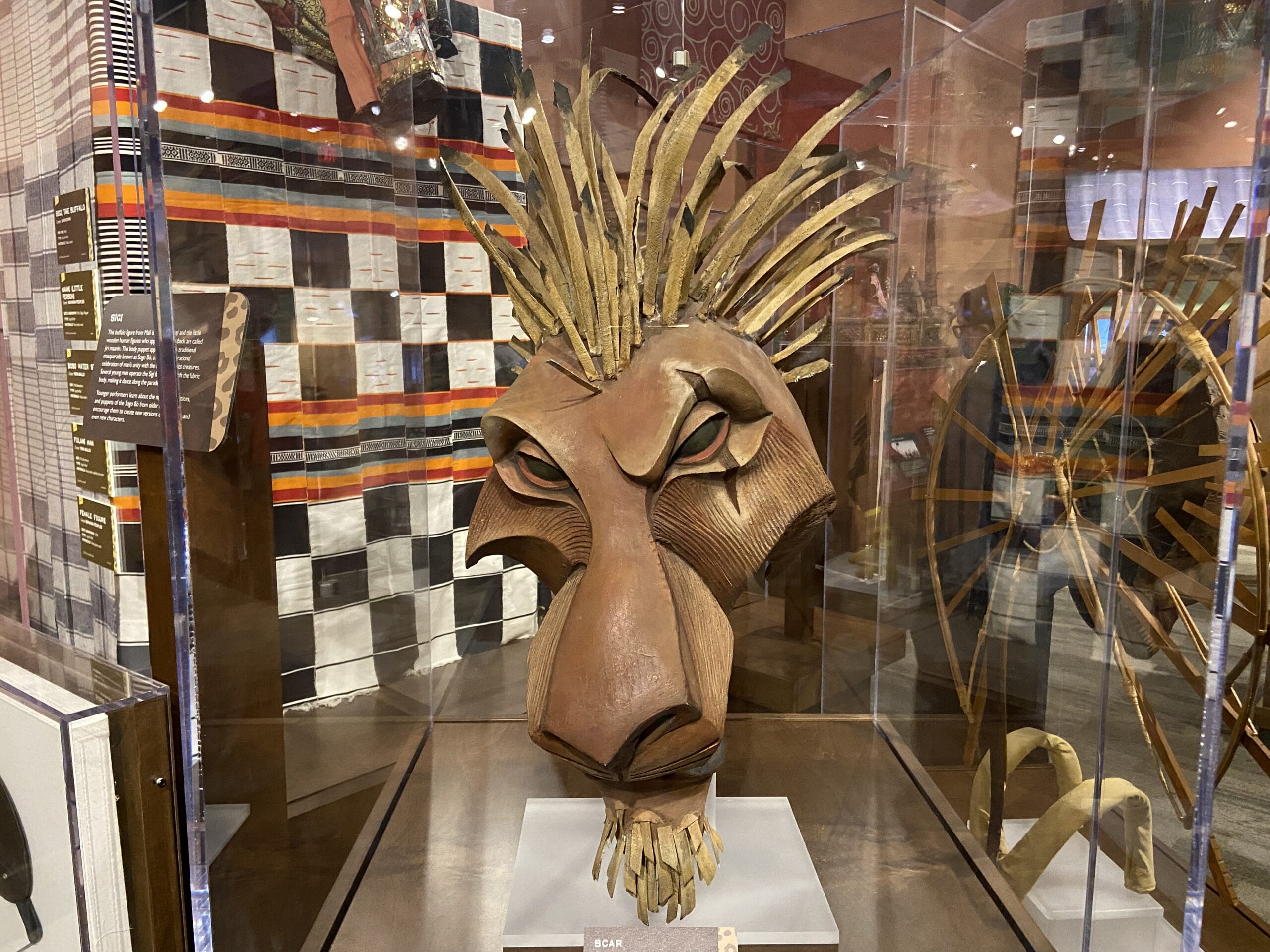
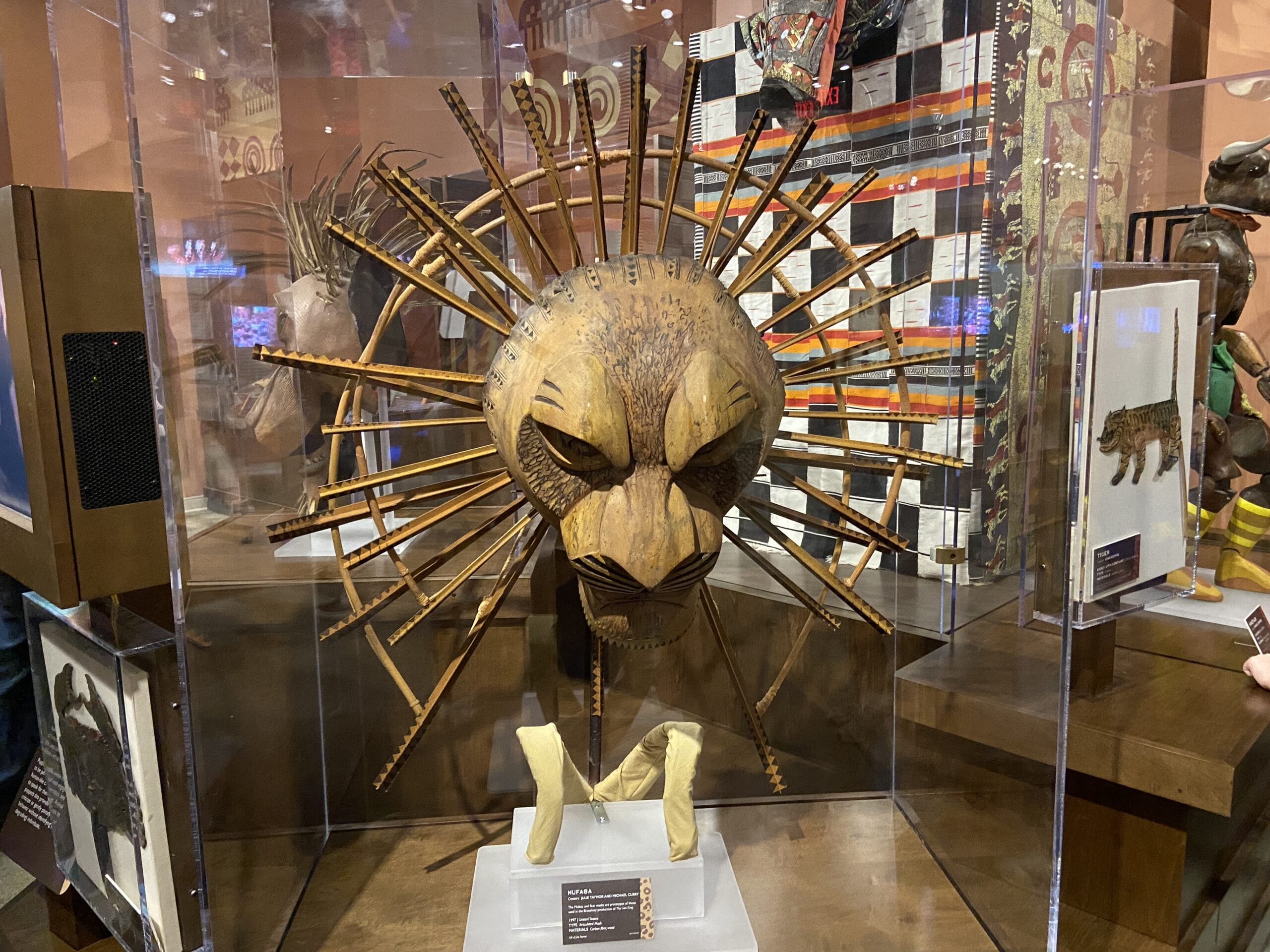
These articulated masks are prototypes for the Scar and Mufasa masks that would eventually appear in The Lion King on Broadway. These were created in 1997 by Julie Taymor and Michael Curry out of carbon fiber and wood. Scar’s mask is decorated with chicken and turkey feathers.
For the latest Disney Parks news and info, follow WDW News Today on Twitter, Facebook, and Instagram.

